 |
| Published monthly since 1996 by the Connecticut Department of Labor, Office of Research. |
 |
 |
 he Connecticut Economic Digest's purpose is to regularly provide users with a comprehensive source for the most current, up-to-date data available on the workforce and economy of the state, within perspectives of the region and nation. he Connecticut Economic Digest's purpose is to regularly provide users with a comprehensive source for the most current, up-to-date data available on the workforce and economy of the state, within perspectives of the region and nation.
Every month the Connecticut Economic Digest provides the most current economic data available for Connecticut. Decision-makers from many arenas are better informed because the Digest makes it possible to follow the trends and understand the status of economic forces that influence Connecticut's labor markets. We are pleased to continue providing information that is useful in making decisions, setting plans, and engaging in informed conversation.
Articles from the Connecticut Economic Digest may be reprinted if the source is credited. Please send copies of the reprinted material to the Managing Editor. The views expressed by the authors are theirs alone and may not reflect those of the Connecticut Department of Labor. Managing Editor: Jungmin Charles Joo.
For further information, call the Office of Research at 860-263-6290 or e-mail to dol.econdigest@po.state.ct.us.
Become a Connecticut Economic Digest subscriber!
 Send message addressed to: listserv@list.ct.gov with the following in the body of the message. (leave subject blank) Send message addressed to: listserv@list.ct.gov with the following in the body of the message. (leave subject blank)
 SUBSCRIBE DOL-CTEconomicDigest your_name (type in your name where it says your_name). SUBSCRIBE DOL-CTEconomicDigest your_name (type in your name where it says your_name).
To Unsubscribe from Connecticut Economic Digest list.
 Compose an e-mail to listserv@list.ct.gov from same email account when subscribing to DOL-CTEconomicDigest. Compose an e-mail to listserv@list.ct.gov from same email account when subscribing to DOL-CTEconomicDigest.
 Leave the subject line blank and in the body of the message type: Signoff DOL-CTEconomicDigest. Click send. Leave the subject line blank and in the body of the message type: Signoff DOL-CTEconomicDigest. Click send. |
 |
|
 |
Reference over 200 articles focusing on
Connecticut's economic climate including: |
|
|
 |
| Adobe Reader is the global standard for electronic document sharing. Use Adobe Reader to view, search, digitally sign, verify, print, and collaborate on Adobe PDF files. Download Acrobat Reader. |
 |
|
 |
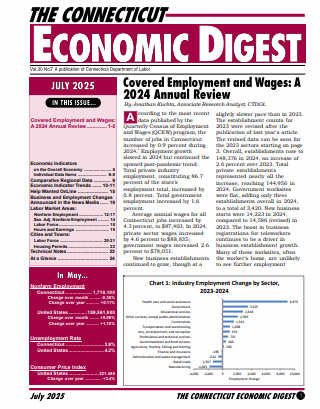

|
 |
July 2025 Connecticut Economic Digest |
 |
Covered Employment and Wages 2024: A 2024 Annual Review
By Jonathan Kuchta, Research Analyst, Department of Labor
 ccording to the most recent
data published by the
Quarterly Census of Employment
and Wages (QCEW) program, the
number of jobs in Connecticut
increased by 0.9 percent during
2024. Employment growth
slowed in 2024 but continued the
upward post-pandemic trend.
Total private industry
employment, constituting 86.7
percent of the state's
employment total, increased by
0.8 percent. Total government
employment increased by 1.6
percent. ccording to the most recent
data published by the
Quarterly Census of Employment
and Wages (QCEW) program, the
number of jobs in Connecticut
increased by 0.9 percent during
2024. Employment growth
slowed in 2024 but continued the
upward post-pandemic trend.
Total private industry
employment, constituting 86.7
percent of the state's
employment total, increased by
0.8 percent. Total government
employment increased by 1.6
percent.
Average annual wages for all
Connecticut jobs increased by
4.3 percent, to $87,403. In 2024,
private sector wages increased
by 4.6 percent to $88,835;
government wages increased 2.6
percent to $78,051. New business establishments
continued to grow, though at a
slightly slower pace than in 2023.
The establishment counts for
2023 were revised after the
.... [ read more ]
|
 |
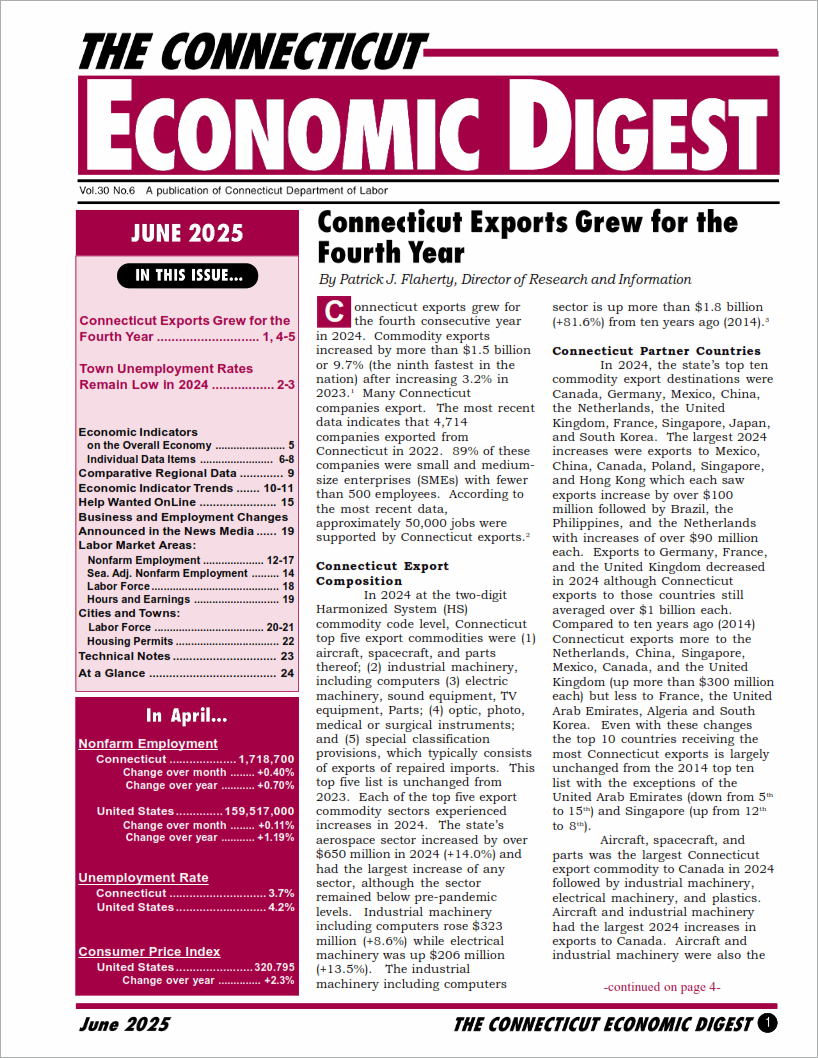


|
 |
June 2025 Connecticut Economic Digest |
 |
Connecticut Exports Grew for the Fourth Year
By Patrick J. Flaherty, Director of Research and Information
 onnecticut exports grew for the fourth consecutive year in 2024. Commodity exports increased by more than $1.5 billion or 9.7% (the ninth fastest in the nation) after increasing 3.2% in 2023.1 Many Connecticut companies export. The most recent data indicates that 4,714 companies exported from Connecticut in 2022. 89% of these companies were small and medium-size enterprises (SMEs) with fewer than 500 employees. According to the most recent data, approximately 50,000 jobs were supported by Connecticut exports. onnecticut exports grew for the fourth consecutive year in 2024. Commodity exports increased by more than $1.5 billion or 9.7% (the ninth fastest in the nation) after increasing 3.2% in 2023.1 Many Connecticut companies export. The most recent data indicates that 4,714 companies exported from Connecticut in 2022. 89% of these companies were small and medium-size enterprises (SMEs) with fewer than 500 employees. According to the most recent data, approximately 50,000 jobs were supported by Connecticut exports.
In 2024 at the two-digit Harmonized System (HS) commodity code level, Connecticut top five export commodities were (1) aircraft, spacecraft, and parts thereof; (2) industrial machinery, including computers (3) electric machinery, sound equipment, TV equipment, Parts; (4) optic, photo, medical or surgical instruments; and (5) special classification provisions, which typically consists of exports of repaired imports. This top five list is unchanged from 2023. Each of the top five export commodity sectors experienced increases in 2024.
[ read more ]
Town Unemployment Rates Remain Low in 2024
By Jungmin Charles Joo, CT Department of Labor
 In 2024, the annual average statewide unemployment rate was 3.2%, unchanged over the year. After two years of strong labor force growth when unemployment rates fell sharply in most towns, most towns saw small changes (up or down) in 2024, with 39 towns seeing no change from the 2023 level. The Local Area Unemployment Statistics (LAUS) underwent a major change reflecting new geographies, so all 169 cities and towns were revised for 2016-2024. In 2024, the annual average statewide unemployment rate was 3.2%, unchanged over the year. After two years of strong labor force growth when unemployment rates fell sharply in most towns, most towns saw small changes (up or down) in 2024, with 39 towns seeing no change from the 2023 level. The Local Area Unemployment Statistics (LAUS) underwent a major change reflecting new geographies, so all 169 cities and towns were revised for 2016-2024.
The unemployment rate in 60% of the cities and towns in the state fell in 2024. Roxbury had the lowest unemployment rate of 1.9%, while the residents of both Hartford and Waterbury experienced the highest rate of 5.0% last year (see table on page 3 for the complete town data). Overall, a total of 129 cities and towns had jobless rates below the 2024 statewide figure of 3.2%, 29 had rates above it, and 11 had rates equal to it. By comparison, 122 cities and towns had rates below the 2023 statewide average of 3.2%, 39 above it, and 8 were the same. [ read more ]
|
 |
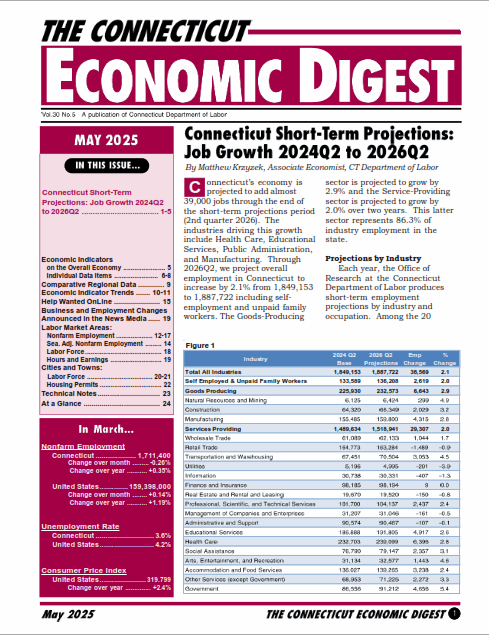

|
 |
May 2025 Connecticut Economic Digest |
 |
Connecticut Short-Term Projections: Job Growth 2024Q2 to 2026Q2
By Matthew Krzyzek, Economist, Department of Labor
 onnecticut's economy is projected to add almost 39,000 jobs through the end of the short-term projections period (2nd quarter 2026). The industries driving this growth include Health Care, Educational Services, Public Administration, and Manufacturing. Through 2026Q2, we project overall employment in Connecticut to increase by 2.1% from 1,849,153 to 1,887,722 including self-employment and unpaid family workers. The Goods-Producing sector is projected to grow by 2.9% and the Service-Providing sector is projected to grow by 2.0% over two years. This latter sector represents 86.3% of industry employment in the state. onnecticut's economy is projected to add almost 39,000 jobs through the end of the short-term projections period (2nd quarter 2026). The industries driving this growth include Health Care, Educational Services, Public Administration, and Manufacturing. Through 2026Q2, we project overall employment in Connecticut to increase by 2.1% from 1,849,153 to 1,887,722 including self-employment and unpaid family workers. The Goods-Producing sector is projected to grow by 2.9% and the Service-Providing sector is projected to grow by 2.0% over two years. This latter sector represents 86.3% of industry employment in the state.
Each year, the Office of Research at the Connecticut Department of Labor produces short-term employment projections by industry and occupation. Among the 20 industry groups shown in Figure 1, 14 are projected to increase over two years and 6 are projected to decline. The largest increases are expected in Health Care (+6,396), Educational Services (+4,917), Government (+4,656), and Manufacturing (+4,315). These four industries represent a combined 39% of base quarter 2024Q2 employment and 56% of total industry growth through 2026Q2.
[ read more ]
|
 |
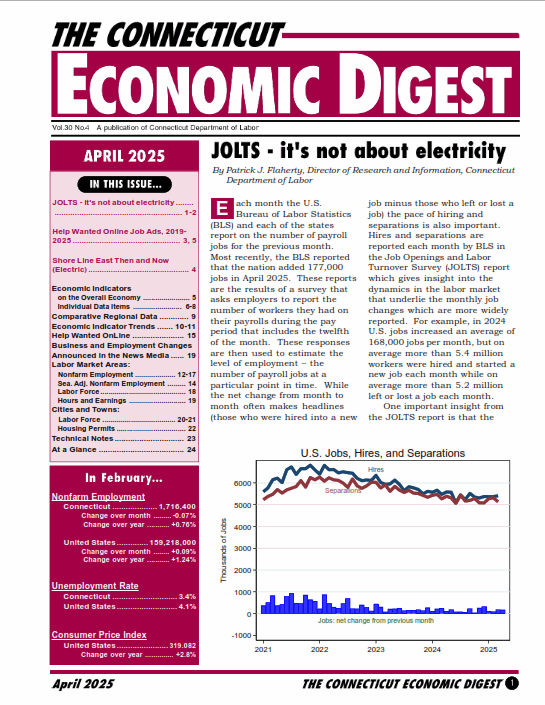



|
 |
April 2025 Connecticut Economic Digest |
 |
JOLTS - it's not about electricity
By Patrick.Flaherty, Director of Research, Department of Labor
 ach month the U.S.
Bureau of Labor Statistics
(BLS) and each of the states
report on the number of payroll
jobs for the previous month.
Most recently, the BLS reported
that the nation added 177,000
jobs in April 2025. These reports
are the results of a survey that
asks employers to report the
number of workers they had on
their payrolls during the pay
period that includes the twelfth
of the month. These responses
are then used to estimate the
level of employment - the
number of payroll jobs at a
particular point in time. ach month the U.S.
Bureau of Labor Statistics
(BLS) and each of the states
report on the number of payroll
jobs for the previous month.
Most recently, the BLS reported
that the nation added 177,000
jobs in April 2025. These reports
are the results of a survey that
asks employers to report the
number of workers they had on
their payrolls during the pay
period that includes the twelfth
of the month. These responses
are then used to estimate the
level of employment - the
number of payroll jobs at a
particular point in time.
While
the net change from month to
month often makes headlines
(those who were hired into a new job minus those who left or lost a
job) the pace of hiring and
separations is also important.
Hires and separations are
reported each month by BLS in
the Job Openings and Labor
Turnover Survey (JOLTS) report
which gives insight into the
dynamics in the labor market
that underlie the monthly job
changes which are more widely
reported. For example, in 2024
U.S. jobs increased an average of
168,000 jobs per month, but on
average more than 5.4 million
workers were hired and started a
new job each month while on
average more than 5.2 million
left or lost a job each month. [ read more ]
Help Wanted Online Job Ads, 2019-2025
By Matthew Krzyzek, Economist, Department of Labor
 he Connecticut Department of Labor publishes monthly Help Wanted OnLine (HWOL) job ad data to show the number and types of job ads posted by employers in the state. These monthly reports include deduplicated breakouts by workforce development area to provide jobseekers with information relevant to their local market. Though related, HWOL job ad data differs from the JOLTS data published by the Bureau of Labor Statistics (BLS). A job ad may be posted for a variety of reasons and won't necessarily lead to or represent an available job opening that will subsequently be filled. he Connecticut Department of Labor publishes monthly Help Wanted OnLine (HWOL) job ad data to show the number and types of job ads posted by employers in the state. These monthly reports include deduplicated breakouts by workforce development area to provide jobseekers with information relevant to their local market. Though related, HWOL job ad data differs from the JOLTS data published by the Bureau of Labor Statistics (BLS). A job ad may be posted for a variety of reasons and won't necessarily lead to or represent an available job opening that will subsequently be filled.
The dramatic shifts the economy has experienced since 2019 are reflected in the total job ad count at both the state and national level. Monthly total deduplicated job ad counts for the U.S. and CT began to increase dramatically during the beginning of 2021. The graph below illustrates this rise to series peaks of over 122,000 in Connecticut and over 9.2 million in the U.S. by March 2022. This compares to March 2021 levels of 66,500 in Connecticut and 7.4 million in the U.S. [ read more ]
Shore Line East Then and Now (Electric)
By Al Sylvestre, AICP, Research Analyst
 ntroduced in May 1990 as a temporary alternative to construction-induced traffic on I-95, as well as pending construction of the new Q Bridge in New Haven, the Clamdigger commuter rail connecting New Haven and Old Saybrook, soon took on the more forthright—and less seafood restaurant menu item — moniker, Shore Line East (SLE). Following completion of I-95 construction, because of SLE's better-than-expected popularity, the Connecticut Department of Transportation (CTDOT) continued and expanded the service, including... [ read more ] ntroduced in May 1990 as a temporary alternative to construction-induced traffic on I-95, as well as pending construction of the new Q Bridge in New Haven, the Clamdigger commuter rail connecting New Haven and Old Saybrook, soon took on the more forthright—and less seafood restaurant menu item — moniker, Shore Line East (SLE). Following completion of I-95 construction, because of SLE's better-than-expected popularity, the Connecticut Department of Transportation (CTDOT) continued and expanded the service, including... [ read more ]
|
 |
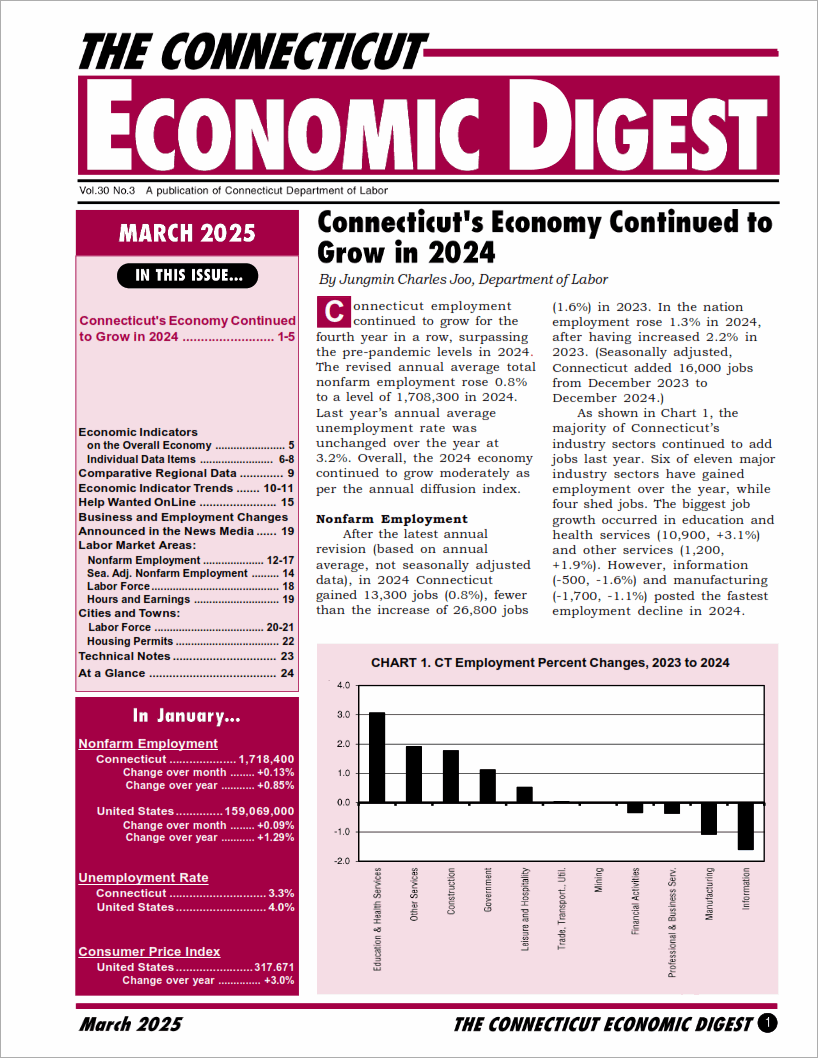

|
 |
March 2025 Connecticut Economic Digest |
 |
Connecticut's Economy Continued to Grow in 2024
By Jungmin Charles Joo, Connecticut Department of Labor
 onnecticut employment continued to grow for the fourth year in a row, surpassing the pre-pandemic levels in 2024.
The revised annual average total nonfarm employment rose 0.8% to a level of 1,708,300 in 2024. Last year�s annual average unemployment rate was unchanged over the year at 3.2%. Overall, the 2024 economy
continued to grow moderately as per the annual diffusion index. onnecticut employment continued to grow for the fourth year in a row, surpassing the pre-pandemic levels in 2024.
The revised annual average total nonfarm employment rose 0.8% to a level of 1,708,300 in 2024. Last year�s annual average unemployment rate was unchanged over the year at 3.2%. Overall, the 2024 economy
continued to grow moderately as per the annual diffusion index.
After the latest annual revision (based on annual average, not seasonally adjusted data), in 2024 Connecticut gained 13,300 jobs (0.8%), fewer than the increase of 26,800 jobs (1.6%) in 2023. In the
nation employment rose 1.3% in 2024, after having increased 2.2% in 2023. (Seasonally adjusted, Connecticut added 16,000 jobs from December 2023 to December 2024.)
[ read more ]
|
 |
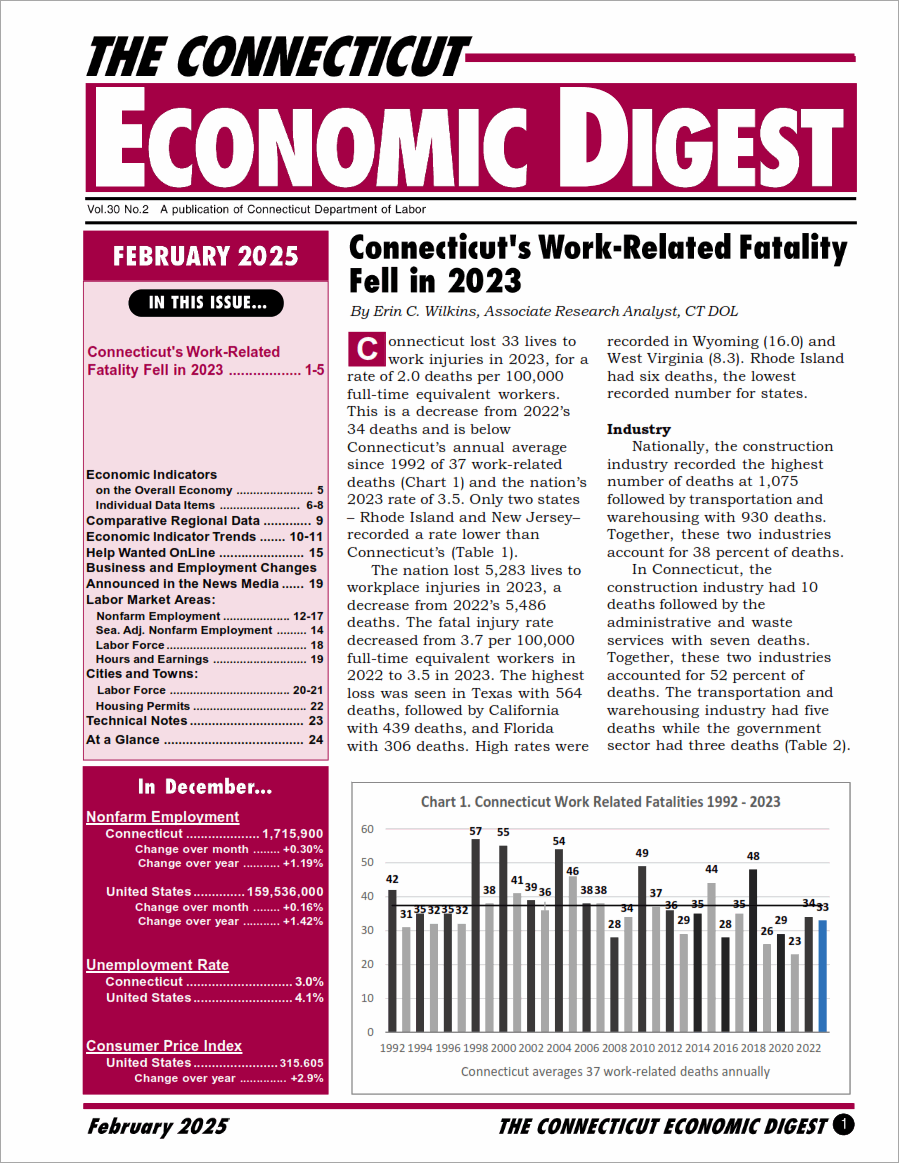

|
 |
February 2025 Connecticut Economic Digest |
 |
Connecticut's Work-Related Fatality Fell in 2023
By Erin C. Wilkins, Associate Research Analyst, CT DOL
 onnecticut lost 33 lives to work injuries in 2023, for a rate of 2.0 deaths per 100,000 full-time equivalent workers.
This is a decrease from 2022�s 34 deaths and is below Connecticut�s annual average since 1992 of 37 work-related deaths and the nation�s 2023 rate of 3.5. Only two states � Rhode Island and
New Jersey� recorded a rate lower than Connecticut�s. onnecticut lost 33 lives to work injuries in 2023, for a rate of 2.0 deaths per 100,000 full-time equivalent workers.
This is a decrease from 2022�s 34 deaths and is below Connecticut�s annual average since 1992 of 37 work-related deaths and the nation�s 2023 rate of 3.5. Only two states � Rhode Island and
New Jersey� recorded a rate lower than Connecticut�s.
The nation lost 5,283 lives to workplace injuries in 2023, a decrease from 2022�s 5,486 deaths. The fatal injury rate decreased from 3.7 per 100,000 full-time equivalent workers in 2022 to 3.5 in 2023. The highest
loss was seen in Texas with 564 deaths, followed by California with 439 deaths, and Florida with 306 deaths. High rates were recorded in Wyoming (16.0) and West Virginia (8.3). Rhode Island had six deaths, the
lowest recorded number for states. [ read more ]
|
 |
 |
|
 |
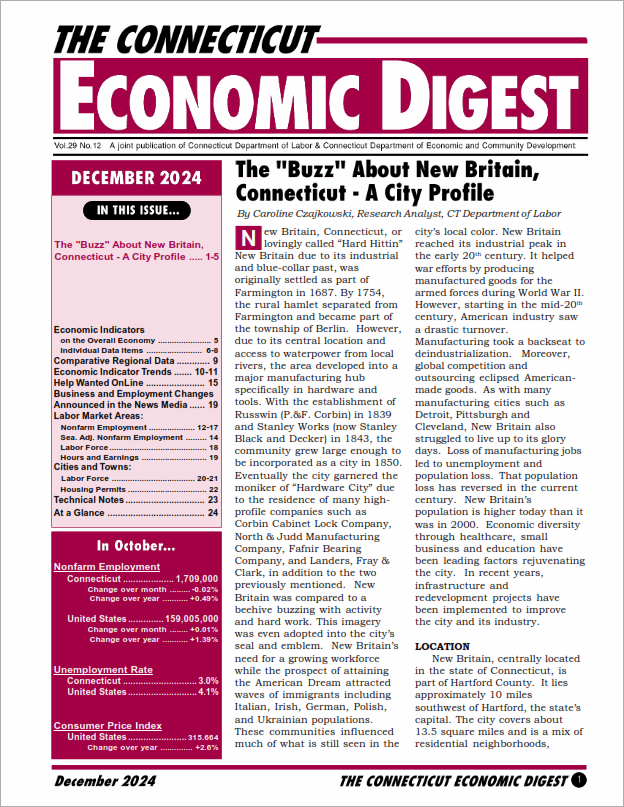

|
 |
December 2024 Connecticut Economic Digest |
 |
The "Buzz" About New Britain, Connecticut - A City Profile
By Caroline Czajkowski, Research Analyst, CT Department of Labor
 ew Britain, Connecticut, or lovingly called �Hard Hittin� New Britain due to its industrial and blue-collar past,
was originally settled as part of Farmington in 1687. By 1754, the rural hamlet separated from Farmington and became part of the township of Berlin. However, due to its central location and access to
waterpower from local rivers, the area developed into a major manufacturing hub specifically in hardware and tools. ew Britain, Connecticut, or lovingly called �Hard Hittin� New Britain due to its industrial and blue-collar past,
was originally settled as part of Farmington in 1687. By 1754, the rural hamlet separated from Farmington and became part of the township of Berlin. However, due to its central location and access to
waterpower from local rivers, the area developed into a major manufacturing hub specifically in hardware and tools.
With the establishment of Russwin (P.&F. Corbin) in 1839 and Stanley Works (now Stanley Black and Decker) in 1843, the community grew large enough to be incorporated as a city in 1850. Eventually the city
garnered the moniker of �Hardware City� due to the residence of many high-profile companies such as Corbin Cabinet Lock Company, North & Judd Manufacturing Company, Fafnir Bearing Company, and Landers, Fray & Clark, in addition to the two previously mentioned.
New Britain was compared to a beehive buzzing with activity and hard work. This imagery was even adopted into the city�s seal and emblem. New Britain�s need for a growing workforce while the prospect of attaining the American Dream attracted waves of immigrants including Italian, Irish, German, Polish, and Ukrainian populations.
[ read more ]
|
 |
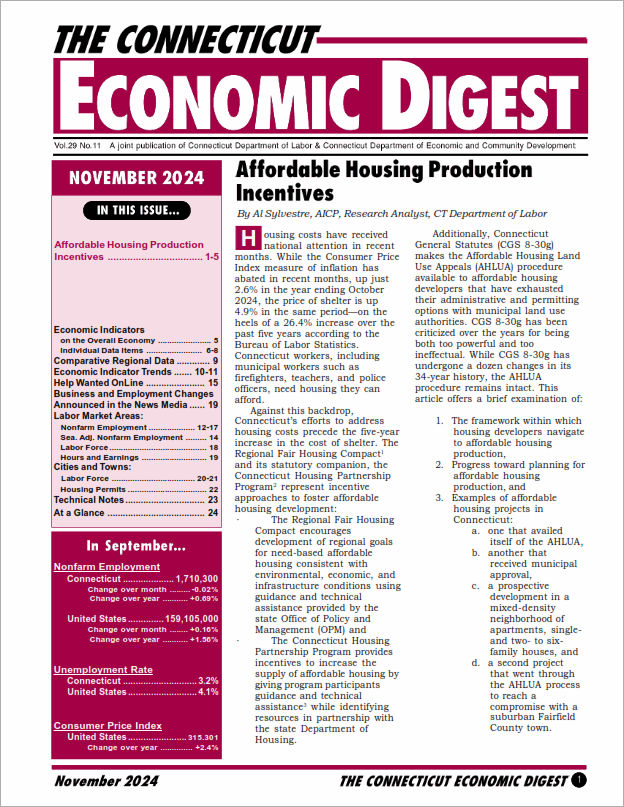

|
 |
November 2024 Connecticut Economic Digest |
 |
Affordable Housing Production Incentives
By Al Sylvestre, AICP, Research Analyst
 ousing costs have received national attention in recent months. While the Consumer Price Index measure of inflation
has abated in recent months, up just 2.6% in the year ending October 2024, the price of shelter is up 4.9% in the same period�on the heels of a 26.4% increase over the past five years according to the
Bureau of Labor Statistics. Connecticut workers, including municipal workers such as firefighters, teachers, and police officers, need housing they can afford. ousing costs have received national attention in recent months. While the Consumer Price Index measure of inflation
has abated in recent months, up just 2.6% in the year ending October 2024, the price of shelter is up 4.9% in the same period�on the heels of a 26.4% increase over the past five years according to the
Bureau of Labor Statistics. Connecticut workers, including municipal workers such as firefighters, teachers, and police officers, need housing they can afford.
Against this backdrop, Connecticut�s efforts to address housing costs precede the five-year increase in the cost of shelter. The Regional Fair Housing Compact1 and its statutory companion, the Connecticut
Housing Partnership Program2 represent incentive approaches to foster affordable housing development:
� The Regional Fair Housing Compact encourages development of regional goals for need-based affordable housing consistent with environmental, economic, and infrastructure conditions using guidance and technical assistance provided by the state Office of Policy and Management (OPM) and
� The Connecticut Housing Partnership Program provides incentives to increase the supply of affordable housing by giving program participants guidance and technical assistance3 while identifying resources in partnership with the state Department of Housing.
[ read more ]
|
 |
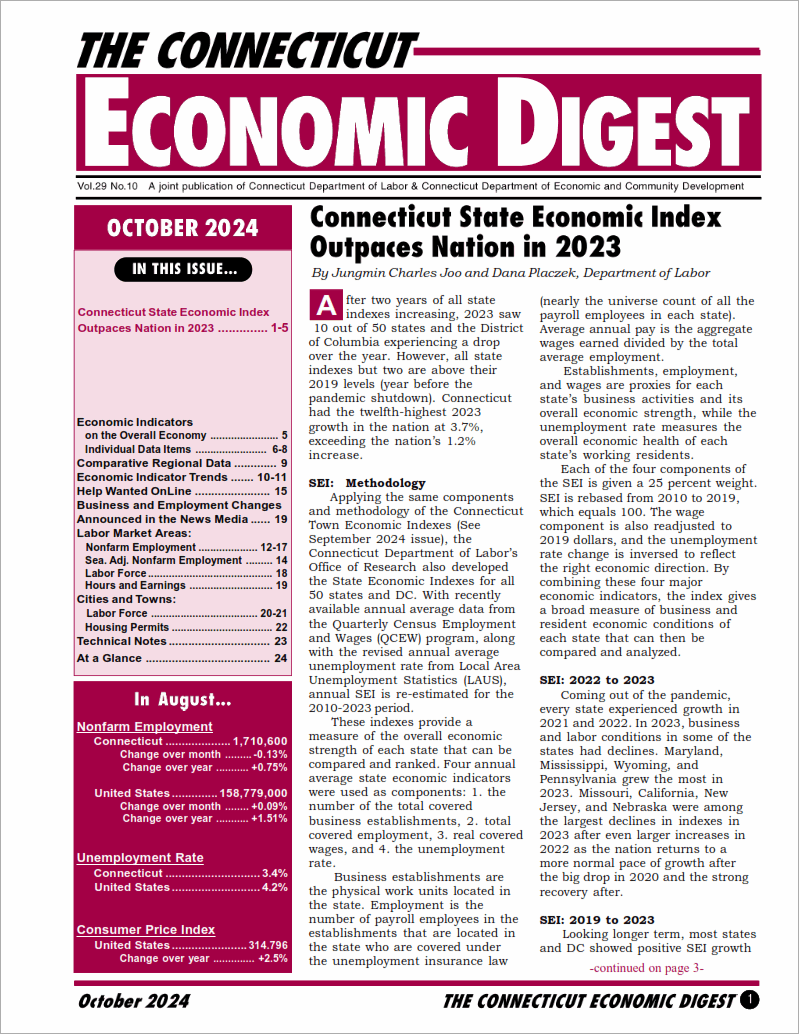

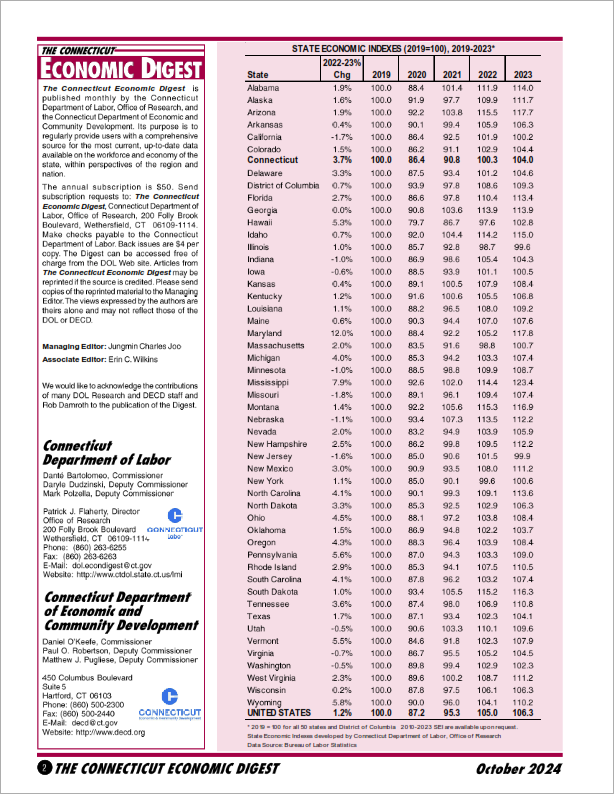
|
 |
October 2024 Connecticut Economic Digest |
 |
Connecticut State Economic Index Outpaces Nation in 2023
By Jungmin Charles Joo, and Dana Placzek
 fter two years of all state indexes increasing, 2023 saw 10 out of 50 states and the District of Columbia experiencing a
drop over the year. However, all state indexes but two are above their 2019 levels (year before the pandemic shutdown). Connecticut had the twelfth-highest 2023 growth in the nation at 3.7%, exceeding the nation�s
1.2% increase. fter two years of all state indexes increasing, 2023 saw 10 out of 50 states and the District of Columbia experiencing a
drop over the year. However, all state indexes but two are above their 2019 levels (year before the pandemic shutdown). Connecticut had the twelfth-highest 2023 growth in the nation at 3.7%, exceeding the nation�s
1.2% increase.
SEI: Methodology
Applying the same components and methodology of the Connecticut Town Economic Indexes (See September 2024 issue), the Connecticut Department of Labor�s Office of Research also developed the State Economic Indexes for all 50 states
and DC. With recently available annual average data from the Quarterly Census Employment and Wages (QCEW) program, along with the revised annual average unemployment rate from Local Area Unemployment Statistics (LAUS), annual SEI is re-estimated for the 2010-2023 period.
These indexes provide a measure of the overall economic strength of each state that can be compared and ranked. Four annual average state economic indicators were used as components: 1. the number of the total covered business establishments, 2. total covered employment,
3. real covered wages, and 4. the unemployment rate. [ read more ]
Download SEI2010-2023data.xlsx
|
 |
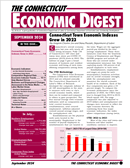

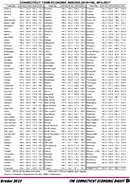
|
 |
September 2024 Connecticut Economic Digest |
 |
Connecticut Town Economic Indexes Grew in 2023
By Jungmin Charles Joo, and Dana Placzek
 onnecticut's overall economy grew last year with nearly all towns seeing increases. Fully 136 of Connecticut's 169 cities and towns were above pre-COVID-19 pandemic (2019)
levels in 2023. The indexes on page 3 give a broad measure of business and resident economic well-being of each town, allowing comparisons among them. onnecticut's overall economy grew last year with nearly all towns seeing increases. Fully 136 of Connecticut's 169 cities and towns were above pre-COVID-19 pandemic (2019)
levels in 2023. The indexes on page 3 give a broad measure of business and resident economic well-being of each town, allowing comparisons among them.
The Connecticut Town Economic Indexes (CTEI) were introduced in 2015 and are released annually. The Connecticut Department of Labor�s Office of Research developed the
composite indexes of all 169 municipalities in the state to measure each town or city�s overall economic health, which then can be ranked and compared to others to gain
perspective. The four annual average town economic indicators used as components are total covered business establishments, total covered employment, inflation-adjusted
covered annual average wages, and the unemployment rate.
Establishments are the physical work units located in the municipality. Employment is the number of payroll employees in establishments that are located in the town. Wages are the aggregate payroll pay divided by the total average employment. [ read more ]
Download SEI2010-2023data.xlsx
|
 |
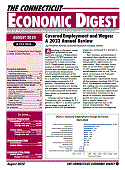

|
 |
August 2024 Connecticut Economic Digest |
 |
Covered Employment and Wages: A 2023 Annual Review
By Jonathan Kuchta, Research Analyst, Department of Labor
 ccording to the most recent data published by the Quarterly Census of Employment and Wages (QCEW) program, the number of jobs in Connecticut increased by 1.6 percent during 2023.1 Employment growth was modest in 2023 but continued the upward post-pandemic trend. Total private industry employment, constituting 86.8 percent of the state�s employment total, increased by 1.5 percent. Total government
employment increased by 2.0 percent. Connecticut has now recovered all the jobs lost during the pandemic, though some sectors have understandably fared better than others as business models change. ccording to the most recent data published by the Quarterly Census of Employment and Wages (QCEW) program, the number of jobs in Connecticut increased by 1.6 percent during 2023.1 Employment growth was modest in 2023 but continued the upward post-pandemic trend. Total private industry employment, constituting 86.8 percent of the state�s employment total, increased by 1.5 percent. Total government
employment increased by 2.0 percent. Connecticut has now recovered all the jobs lost during the pandemic, though some sectors have understandably fared better than others as business models change.
Average annual wages for all Connecticut jobs increased by 3.1 percent, to $83,773. In 2023, private sector wages increased by 3.1 percent to $84,948; government wages also increased 3.1 percent to $76,044.
New business establishments continued their significant growth, though they continue to be heavily influenced by registrations for teleworkers. New business starts were 14,210 in 2023, compared to 17,007 (revised) in 2022. Overall, establishments rose to 149,796 in 2023, an increase of 4.9 percent over 2022. [ read more ] |
 |
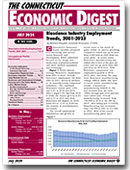


|
 |
July 2024 Connecticut Economic Digest |
 |
Bioscience Industry Employment Trends, 2001-2023
By Matthew Krzyzek, Economist, Department of Labor
 onnecticut's bioscience cluster includes advanced manufacturing and service sector Research and Development (R&D) industries focused on the design and production of pharmaceuticals and other medical equipment and technology. onnecticut's bioscience cluster includes advanced manufacturing and service sector Research and Development (R&D) industries focused on the design and production of pharmaceuticals and other medical equipment and technology.
Figure 1 shows annual average Bioscience employment from 2001 to 2023. Overall, Bioscience employment fell from 2001 to 2017, driven by declines in its manufacturing component industries. The combined Bioscience cluster grew 2.5% and 4.4% in 2018 and 2019. After a slight 0.3% dip from 2019 to 2020, the cluster grew by 6.2% and 5.1% in 2021 and 2022. Bioscience fell slightly in 2023, down 344 or -1.3% in 2023 but the number of establishments increased. [ read more ]
Occupational Profile: Electricians
By Jennifer Goddu, Research Analyst, Department of Labor
 lectricians are skilled trade workers responsible for installing, maintaining, and repairing electrical wiring, equipment, and fixtures. Trained electricians ensure that electrical work is done in accordance with state and local building regulations based on the National Electrical Code. Enforced in all 50 states, NFPA 70, National Electrical Code, is the benchmark for safe electrical design, installation, and inspection to protect people and property from electrical hazards. Electricians work both indoors and outdoors at homes, businesses, factories, and construction sites. Duties may include installing electrical systems in newly constructed buildings or maintaining electrical equipment and systems. Maintenance work can include fixing or replacing parts, light fixtures, control systems and motors, or inspecting electrical components such as transformers and circuit breakers. Electricians read blueprints of electrical systems that show the location of circuits, outlets, and other equipment. They use a variety of tools to perform their jobs, such as conduit benders, wire strippers, screw drivers, pliers, and drills. Electricians also use a variety of testing equipment such as voltmeters, ohmmeters, ammeters, thermal scanners, and cable testers to identify electrical problems and ensure components are working properly. [ read more ] lectricians are skilled trade workers responsible for installing, maintaining, and repairing electrical wiring, equipment, and fixtures. Trained electricians ensure that electrical work is done in accordance with state and local building regulations based on the National Electrical Code. Enforced in all 50 states, NFPA 70, National Electrical Code, is the benchmark for safe electrical design, installation, and inspection to protect people and property from electrical hazards. Electricians work both indoors and outdoors at homes, businesses, factories, and construction sites. Duties may include installing electrical systems in newly constructed buildings or maintaining electrical equipment and systems. Maintenance work can include fixing or replacing parts, light fixtures, control systems and motors, or inspecting electrical components such as transformers and circuit breakers. Electricians read blueprints of electrical systems that show the location of circuits, outlets, and other equipment. They use a variety of tools to perform their jobs, such as conduit benders, wire strippers, screw drivers, pliers, and drills. Electricians also use a variety of testing equipment such as voltmeters, ohmmeters, ammeters, thermal scanners, and cable testers to identify electrical problems and ensure components are working properly. [ read more ]
|
 |
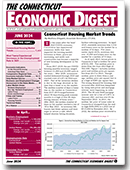


|
 |
June 2024 Connecticut Economic Digest |
 |
Connecticut Housing Market Trends
By Matthew Krzyzek, Economist, Department of Labor
 n the years after the brief 2020 COVID-recession, Connecticut has experienced numerous shifts that have impacted the housing market. Inventory is down, prices are increasing, and multi-unit construction has become a majority of new housing development in the state.
From 2017-2019, the pre-COVID housing monthly inventory ranged between 14,000 and 20,000 units in the state. After 2020, inventories tracked downward through 2024 and reached a low of 3,071 by February 2024. Part of the inventory decline is due to the large decrease in the time that a home is on the market. The median number of days a home was on the market in Connecticut from 2017-2019 ranged between about 50 days during peak summer months to a high of over 80 days during January of those years. After 2020, the median number of days on the market reached a low of 18 in May 2022. As inventory fell, buyers had fewer options and were eager to secure a sale, which helped shorten listing duration, further reducing inventory. In April 2024, statewide inventory was 3,432 and homes were on the market for a median of 32 days. Five years earlier (April 2019), inventory was over 15,000 and homes were on the market for a median of 53 days. [ read more ] n the years after the brief 2020 COVID-recession, Connecticut has experienced numerous shifts that have impacted the housing market. Inventory is down, prices are increasing, and multi-unit construction has become a majority of new housing development in the state.
From 2017-2019, the pre-COVID housing monthly inventory ranged between 14,000 and 20,000 units in the state. After 2020, inventories tracked downward through 2024 and reached a low of 3,071 by February 2024. Part of the inventory decline is due to the large decrease in the time that a home is on the market. The median number of days a home was on the market in Connecticut from 2017-2019 ranged between about 50 days during peak summer months to a high of over 80 days during January of those years. After 2020, the median number of days on the market reached a low of 18 in May 2022. As inventory fell, buyers had fewer options and were eager to secure a sale, which helped shorten listing duration, further reducing inventory. In April 2024, statewide inventory was 3,432 and homes were on the market for a median of 32 days. Five years earlier (April 2019), inventory was over 15,000 and homes were on the market for a median of 53 days. [ read more ]
Most Towns Experienced Decreases in the Unemployment Rate in 2023
By Jungmin Charles Joo, Department of Labor
 n 2023, the annual average statewide unemployment rate was 3.8%, down from 4.1% in 2022. As the labor force bounced back for the third year from the impact of the COVID-19 pandemic, most of the municipalities continued to experience a decrease in their unemployment rate last year. n 2023, the annual average statewide unemployment rate was 3.8%, down from 4.1% in 2022. As the labor force bounced back for the third year from the impact of the COVID-19 pandemic, most of the municipalities continued to experience a decrease in their unemployment rate last year.
2022 to 2023
The unemployment rate in 89% of the cities and towns in the state fell in 2023. Washington had the lowest unemployment rate of 2.3%, while the residents of Waterbury experienced the highest rate of 5.9% last year (see table on page 3 for the complete town data). Overall, a total of 131 cities and towns had jobless rates below the 2023 statewide figure of 3.8%, 30 had rates above it, and 8 had rates equal to it. By comparison, 125 cities and towns had rates below the 2022 statewide average of 4.1%, 38 above it, and 6 were the same.
Of the five largest cities in the state with a population of 100,000 or more, Stamford had the lowest unemployment rate of 3.5% in 2023. Waterbury posted the highest jobless rate among the large cities at 5.9%. All five cities experienced over-the-year unemployment rate decreases. [ read more ]
|
 |
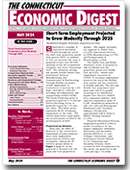

|
 |
May 2024 Connecticut Economic Digest |
 |
Short-Term Employment Projected to Grow Modestly Through 2025
By Matthew Krzyzek, Economist, Department of Labor
 onnecticut's economy is projected to add almost 30,000 jobs through the end of the short-term projections period (2nd quarter 2025). In addition to that net increase, the state is projected to have over 425,000 openings across all occupational categories and every educational level. The industries driving this growth include Health Care, Educational Services, Manufacturing, and Transportation & Warehousing. Through 2025Q2, we project overall employment in Connecticut to increase by 1.6% from 1,824,865 to 1,854,557 including self-employment and unpaid family workers (UFW). The Goods-Producing sector is projected to grow by 2.1% and the Service-Providing sector is projected to grow by 1.5% over two years. This latter sector represents 86.6% of industry employment in the state. The current projections round spans the second quarter of 2023 to the second quarter of 2025. onnecticut's economy is projected to add almost 30,000 jobs through the end of the short-term projections period (2nd quarter 2025). In addition to that net increase, the state is projected to have over 425,000 openings across all occupational categories and every educational level. The industries driving this growth include Health Care, Educational Services, Manufacturing, and Transportation & Warehousing. Through 2025Q2, we project overall employment in Connecticut to increase by 1.6% from 1,824,865 to 1,854,557 including self-employment and unpaid family workers (UFW). The Goods-Producing sector is projected to grow by 2.1% and the Service-Providing sector is projected to grow by 1.5% over two years. This latter sector represents 86.6% of industry employment in the state. The current projections round spans the second quarter of 2023 to the second quarter of 2025.
Projections by Industry
Each year, the Office of Research at the Connecticut Department of Labor produces short-term employment projections by industry and occupation. Among the 20 industry groups shown in Figure 1 (page 3), 16 are projected to increase over two years and 4 are projected to decline. The largest increases are expected in Health Care (+9,255), Educational Services (+2,954), Manufacturing (+2,787), and Transportation & Warehousing (+2,692). [ read more ] |
 |
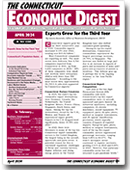


|
 |
April 2024 Connecticut Economic Digest |
 |
Exports Grew for the Third Year
By Laura Jaworski, Office of Business Development, DECD
 onnecticut exports grew for the third consecutive year in 2023. Commodity exports increased 3.13% over 2022, totaling over $15.82 billion. More Connecticut companies are exporting as well. The most recent data indicates that 4,761 companies exported from Connecticut in 2021, up from 4,606 companies in 2020. 89% of these companies were small and medium-sized enterprises (SMEs) with fewer than 500 employees. According to the most recent data, approximately 50,705 U.S. jobs were supported by Connecticut exports. onnecticut exports grew for the third consecutive year in 2023. Commodity exports increased 3.13% over 2022, totaling over $15.82 billion. More Connecticut companies are exporting as well. The most recent data indicates that 4,761 companies exported from Connecticut in 2021, up from 4,606 companies in 2020. 89% of these companies were small and medium-sized enterprises (SMEs) with fewer than 500 employees. According to the most recent data, approximately 50,705 U.S. jobs were supported by Connecticut exports.
Connecticut Partner Countries
In 2023, the state's top ten commodity export destinations were Germany, Canada, the Netherlands, the United Kingdom, Mexico, France, China, Singapore, South Korea, and Japan. Among the top ten destinations, except for the U.K., Mexico, and France, all experienced export growth. Exports to the U.K. dropped most significantly, down 19.59% over 2022.
In 2023, there were decreases in many of the top ten Connecticut export commodity sectors to the United Kingdom, the largest being in the aircraft, spacecraft, and parts sector. A potential reason for this is continued regulatory challenges of Brexit and customs barriers. Higher inflation and rising energy prices in the United Kingdom have also shifted consumer goods spending. [ read more ]
Connecticut's Population Gains
By Patrick.Flaherty, Director of Research, Department of Labor
 he latest population estimates from the U.S. Census Bureau show that Connecticut's population increased by 8,470 in 2023 with births outnumbering deaths by 2,115 and net migration from other states and countries totaling 6,248. While it will be some months before a breakdown by state and age will be available for 2023, the available data through 2022 show encouraging signs for Connecticut. [ read more ] he latest population estimates from the U.S. Census Bureau show that Connecticut's population increased by 8,470 in 2023 with births outnumbering deaths by 2,115 and net migration from other states and countries totaling 6,248. While it will be some months before a breakdown by state and age will be available for 2023, the available data through 2022 show encouraging signs for Connecticut. [ read more ]
|
 |
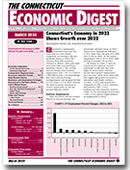

|
 |
March 2024 Connecticut Economic Digest |
 |
Connecticut's Economy in 2023 Shows Growth over 2022
By Jungmin Charles Joo, Associate Research Analyst, Department of Labor
 onnecticut employment continued to grow for the third year in a row, nearly completely recovering to the pre-pandemic levels in 2023. (The January 2024 jobs numbers, released in March, show jobs have more than fully recovered from pandemic losses.) The revised annual average total nonfarm employment rose 1.6% to a level of 1,694,200 in 2023. Correspondingly, last year's annual average unemployment rate dropped further to 3.8% from 4.1% in 2022. Overall, the 2023 economy continued to recover moderately as per the annual diffusion index. onnecticut employment continued to grow for the third year in a row, nearly completely recovering to the pre-pandemic levels in 2023. (The January 2024 jobs numbers, released in March, show jobs have more than fully recovered from pandemic losses.) The revised annual average total nonfarm employment rose 1.6% to a level of 1,694,200 in 2023. Correspondingly, last year's annual average unemployment rate dropped further to 3.8% from 4.1% in 2022. Overall, the 2023 economy continued to recover moderately as per the annual diffusion index.
Nonfarm Employment
After the latest annual revision (based on annual average, not seasonally adjusted data), in 2023 Connecticut regained 26,100 jobs (1.6%), fewer than the gain of 51,800 jobs (3.2%) in 2022. In the nation employment rose 2.3% in 2023, after having increased 4.3% in 2022.
As shown in Chart 1, most of Connecticut's industry sectors continued to add jobs last year. Eight of eleven major industry sectors have gained employment over the year, while three shed jobs. The biggest job growth occurred in education and health services (13,200, +3.9%), and leisure and hospitality (4,200, +2.8%). However, information (-300, -1.0%), professional and business services (-900, -0.4%), and financial activities (-200, -0.2%) posted slight declines in employment in 2023. [ read more ]
|
 |
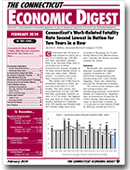

|
 |
February 2024 Connecticut Economic Digest |
 |
Connecticut's Work-Related Fatality Rate Second Lowest in Nation for Two Years in a Row
By Erin C. Wilkins, Associate Research Analyst, Department of Labor
 onnecticut lost 34 lives to work injuries in 2022, for a rate of 2.0 deaths per 100,000 full-time equivalent workers. This is an increase from 2021's 23 deaths but is below Connecticut's annual average of 38 work-related deaths (Chart 1). Only one other state - Rhode Island - recorded a rate lower than Connecticut's (Table 1). onnecticut lost 34 lives to work injuries in 2022, for a rate of 2.0 deaths per 100,000 full-time equivalent workers. This is an increase from 2021's 23 deaths but is below Connecticut's annual average of 38 work-related deaths (Chart 1). Only one other state - Rhode Island - recorded a rate lower than Connecticut's (Table 1).
The nation lost 5,486 lives to workplace injuries in 2022, an increase from 2021's 5,190 deaths. The fatal injury rate increased from 3.6 per 100,000 full-time equivalent workers in 2021 to 3.7 in 2022. The highest loss was seen in Texas with 578 deaths, followed by California with 504 deaths and Florida with 307 deaths. High rates were recorded in Wyoming (12.7) and North Dakota (9.8). Rhode Island had 7 deaths, the lowest recorded number for states.
Industry
Nationally, the construction industry recorded the highest number of deaths at 1,069 followed by transportation and warehousing with 1,053 deaths. Together, these two industries account for 39 percent of deaths.
The construction industry and the transportation and warehousing industry each had 9 deaths in Connecticut. Together, they accounted for 53 percent of 2022's deaths. Manufacturing came in third with 4 deaths, or 11.8 percent of total deaths (Table 2). With an overall rate of 2.0, Connecticut saw a rate of 9.4 in transportation and utilities and 6.7 in construction. Rates for other industry sectors did not meet publishing criteria. [ read more ] |
 |
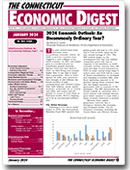

|
 |
January 2024 Connecticut Economic Digest |
 |
2024 Economic Outlook: An Uncommonly Ordinary Year?
By Steven P. Lanza, Associate Professor-in-Residence, UConn Department of Economics
 he past several years have witnessed some extraordinary economic events. In 2020, a once-in-a-century virus triggered a near-collapse of the world economy. In 2021 real output grew at a breakneck pace as populations gained immunity against Covid and went back to work. In 2022 living costs jumped higher than at any time in more than a generation. Then in 2023, against all odds, price pressures were brought to heel without the feared sacrifice of high unemployment and reduced output. Now, with inflation nearly tamed, monetary authorities set to reverse rate hikes, and output and job growth on course to track closer to historical trends, 2024 is shaping up to be an uncommonly ordinary year. he past several years have witnessed some extraordinary economic events. In 2020, a once-in-a-century virus triggered a near-collapse of the world economy. In 2021 real output grew at a breakneck pace as populations gained immunity against Covid and went back to work. In 2022 living costs jumped higher than at any time in more than a generation. Then in 2023, against all odds, price pressures were brought to heel without the feared sacrifice of high unemployment and reduced output. Now, with inflation nearly tamed, monetary authorities set to reverse rate hikes, and output and job growth on course to track closer to historical trends, 2024 is shaping up to be an uncommonly ordinary year.
The Global Economy
Following a 3.5% rise in world output in 2022, the International Monetary Fund (IMF) projects that global growth will slow to 3.0% 2023, and to 2.9% in 2024, below the 20-year annual average of 3.8%. The IMF outlook hinges on the assumptions that fuel and nonfuel commodity prices will ease in response to the slowdown in world economic activity, interest rates will peak and begin to inch downward in 2024 as major central banks begin to reduce rates, and 2024 will be a year of "fiscal consolidation" in developed and emerging economies alike, with fiscal tightening expected to be greatest among those countries that saw the largest increases in government debt in response to the pandemic. The IMF characterizes its overall outlook as consistent with a much-desired "soft landing" wherein price levels continue to ease while a major economic downturn is averted.
Beneath these topline projections, however, lies a divergence between the emerging and developed worlds. For the advanced economies, including the United States and Western Europe, output is expected to slow from 2.6% in 2022 to 1.5% in 2023 and 1.4% in 2024 (well below the 20-year annual average of more than 2%). In emerging markets and developing economies, growth is expected to largely hold steady, from 4.1% in 2022 to 4.0% in both 2023 and 2024. Even so, those rates of growth remain below the 20-year trend of over 5% annually. [ read more ] |
 |
 |
 |
 |
|
 |
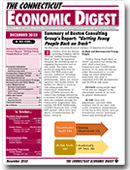

|
 |
December 2023 Connecticut Economic Digest |
 |
Summary of Boston Consulting Group's Report: "Getting Young People Back on Track"
By Xian Guan, Associate Research Analyst, Department of Labor
 n October 2023, the Boston Consulting Company (BCG) released "Getting Young People Back on Track," an important blueprint for identifying and re-engaging disconnected and at-risk youth. The report was produced using data from the state's P20 WIN project and reached audiences including policymakers, youth services professionals, safety net service agencies, and media outlets. To further the efforts to reach at-risk young people, the Connecticut Department of Labor (CTDOL) presents the report's key findings followed by a synopsis of how the underlying data was compiled through the Connecticut longitudinal data system, P20 WIN. Additionally, CTDOL's Research Unit, a P20 WIN partner, offers three data-driven recommendations for future research. n October 2023, the Boston Consulting Company (BCG) released "Getting Young People Back on Track," an important blueprint for identifying and re-engaging disconnected and at-risk youth. The report was produced using data from the state's P20 WIN project and reached audiences including policymakers, youth services professionals, safety net service agencies, and media outlets. To further the efforts to reach at-risk young people, the Connecticut Department of Labor (CTDOL) presents the report's key findings followed by a synopsis of how the underlying data was compiled through the Connecticut longitudinal data system, P20 WIN. Additionally, CTDOL's Research Unit, a P20 WIN partner, offers three data-driven recommendations for future research.
At-Risk and Disconnected Young People
"Getting Young People Back on Track" concluded that during the 2021-2022 school year Connecticut had 119,000 youth between 14-26 years old who are either disconnected or at risk. Using the below definitional framework, this total is comprised of 63,000 disconnected and 56,000 at-risk youth.
On-track: young people aged 14-26 who are engaged in the educational system or on-track for gainful employment.
At-risk: three sub-populations-off-track, those students who do not meet state credit attainment requirements; at-risk due to other factors, such as absenteeism and/or behavioral issues; and severely off-track, those students are off-track and display additional risk factors. [ read more ] [ read more ]
|  |
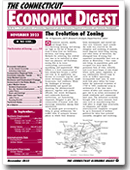

|
 |
November 2023 Connecticut Economic Digest |
 |
The Evolution of Zoning
By Al Sylvestre, Research Analyst, Department of Labor
 bnoxious sounds, smells, and danger from manufacturing, farming, and mining are high on the list of things we want to keep from our bedrooms, kitchens, and living spaces. Methods for achieving this evolved over time to be embodied in what land use planners call Euclidean zoning that is by turns confounding, controversial, mystifying, and aspirational. What follows is a brief examination of how zoning has become a useful tool even as its application can become an economic trap for real estate developers, regulators, small businesses, and residents. While the challenges of housing affordability and sprawl are daunting, the aforementioned planners, together with public officials, real estate developers, and community financial institutions, are formulating responses designed to give rise to communities of human scale that encourage interaction among their inhabitants. bnoxious sounds, smells, and danger from manufacturing, farming, and mining are high on the list of things we want to keep from our bedrooms, kitchens, and living spaces. Methods for achieving this evolved over time to be embodied in what land use planners call Euclidean zoning that is by turns confounding, controversial, mystifying, and aspirational. What follows is a brief examination of how zoning has become a useful tool even as its application can become an economic trap for real estate developers, regulators, small businesses, and residents. While the challenges of housing affordability and sprawl are daunting, the aforementioned planners, together with public officials, real estate developers, and community financial institutions, are formulating responses designed to give rise to communities of human scale that encourage interaction among their inhabitants.
As people grew accustomed to living in group settlements, the walled cities of antiquity became places in which their denizens lived, worshipped, and carried out their civic business. Land outside the walls was reserved for the slaughter and rendering of animals, waste disposal, brick firing, mining, and other forms of extraction; the aboriginal form of zoning that separated incompatible land uses as shown in illustration 1 thus came into being. As populations grew and occupied ever more land, the protozoan form of cities, suburbs, and rural areas began to take shape where earth, space, vegetation, or any combination thereof came to serve as buffers separating incompatible land uses. As most work took place within the home before the industrial revolution of 1760 to 1840, residential areas in settlements of the time were centers of labor and commerce that gave rise to an urban environment of mixed residential and commercial land uses. The industrial revolution brought with it more intensive land uses such as manufacturing that took place in single large structures, on campuses, and within interconnected complexes occupied by up to thousands of workers gathered for labor that included assembly, slaughter and rendering of animals, and the processing of sewage and storm-water runoff. The scale at which industry did its work made the separation of working and living spaces a more urgent proposition; enter the concept of Euclidean zoning. [ read more ] |
 |
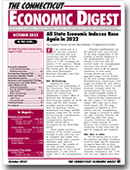

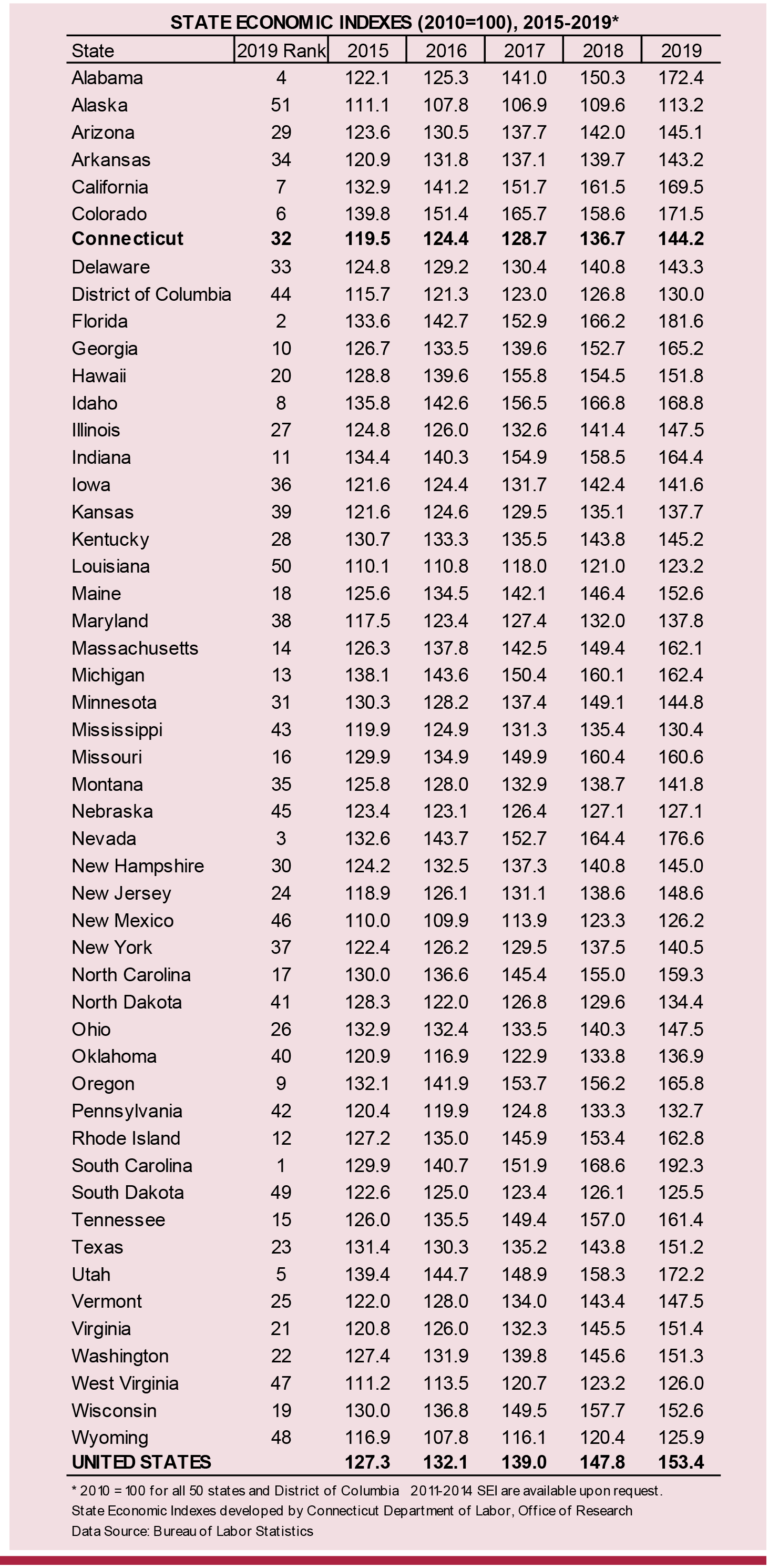 |
 |
October 2023 Connecticut Economic Digest |
 |
All State Economic Indexes Rose Again in 2022
By Jungmin Charles Joo, Department of Labor and Dana Placzek, Research, Department of Labor
 or the second year in a row, all state economic indexes increased last year. Connecticut had the twelfth-highest 2022 growth in the nation at 17.8%, exceeding the nation's 17.6% increase. Rhode Island, Colorado, Missouri, and New Jersey grew the most in 2022 while Washington, Kentucky, Nebraska, and Utah were the slowest. or the second year in a row, all state economic indexes increased last year. Connecticut had the twelfth-highest 2022 growth in the nation at 17.8%, exceeding the nation's 17.6% increase. Rhode Island, Colorado, Missouri, and New Jersey grew the most in 2022 while Washington, Kentucky, Nebraska, and Utah were the slowest.
SEI: Methodology
Applying the same components and methodology of the Connecticut Town Economic Indexes (See September 2023 issue), the Connecticut Department of Labor's Office of Research also developed the State Economic Indexes for all 50 states and DC. With recently available annual average data from the Quarterly Census Employment and Wages (QCEW) program, along with the revised annual average unemployment rate from Local Area Unemployment Statistics (LAUS), annual SEI is reestimated for the 2010-2022 period.
These indexes provide a measure of the overall economic strength of each state that can be compared and ranked. Four annual average state economic indicators were used as components: 1. the number of the total covered business establishments, 2. total covered employment, 3. real covered wages, and 4. the unemployment rate.
Business establishments are the physical work units located in the state. Employment is the number of payroll employees in the establishments that are located in the state who are covered under the unemployment insurance law (nearly the universe count of all the payroll employees in each state). Average annual pay is the aggregate wages earned divided by the total average employment. Establishments, employment, and wages are proxies for each state's business activities and its overall economic strength, while the unemployment rate measures the overall economic health of each state's working residents. [ read more ]
Download SEI 2010-2022 data.xlsx |
 |
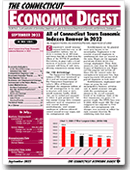

 |
 |
September 2023 Connecticut Economic Digest |
 |
All of Connecticut Town Economic Indexes Recover in 2022
By Jungmin Charles Joo, Department of Labor and Dana Placzek, Research, Department of Labor
 onnecticut's overall economy bounced back last year, as all municipalities' indexes rose in 2022, a recovery for all 169 cities and towns that fell in 2020 from the effects of the COVID-19 pandemic. The indexes on page 3 give a broad measure of business and resident economic well-being of each town, allowing comparisons among them. onnecticut's overall economy bounced back last year, as all municipalities' indexes rose in 2022, a recovery for all 169 cities and towns that fell in 2020 from the effects of the COVID-19 pandemic. The indexes on page 3 give a broad measure of business and resident economic well-being of each town, allowing comparisons among them.
The CTEI Methodology
The Connecticut Town Economic Indexes (CTEI) were introduced in 2015 and are released annually. The Connecticut Department of Labor's Office of Research developed the composite indexes of all 169 municipalities in the state to measure each town or city's overall economic health, which then can be ranked and compared to others to gain perspective. The four annual average town economic indicators used as components are total covered business establishments, total covered employment, inflation-adjusted covered annual average wages, and the unemployment rate.
Establishments are the physical work units located in the municipality. Employment is the number of payroll employees in establishments that are located in the town. Wages are the aggregate payroll pay divided by the total average employment. These three measures come from the Quarterly Census of Employment and Wages (QCEW) program and include all those who are covered under the unemployment insurance law, thus capturing nearly 100 percent of all payroll employees in each town. [ read more ]
Download CTEI 2005-2022 data.xlsx |
 |
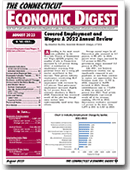

|
 |
August 2023 Connecticut Economic Digest |
 |
Covered Employment and Wages: A 2022 Annual Review
By Jonathan Kuchta, Research Analyst, Department of Labor
 ccording to the most recent data published by the Quarterly Census of Employment and Wages (QCEW) program, the number of jobs in Connecticut increased by 3.2 percent during 2022.1 A combination of employment returning from pandemic losses and a strong job market contributed to this increase. Total private industry employment, constituting 86.9 percent of the state's employment total, increased by 3.4 percent. Total government employment increased slightly by 1.6 percent. Since the economic shutdown in March 2020, Connecticut has recovered nearly all the jobs lost, though some sectors have understandably fared better than others. ccording to the most recent data published by the Quarterly Census of Employment and Wages (QCEW) program, the number of jobs in Connecticut increased by 3.2 percent during 2022.1 A combination of employment returning from pandemic losses and a strong job market contributed to this increase. Total private industry employment, constituting 86.9 percent of the state's employment total, increased by 3.4 percent. Total government employment increased slightly by 1.6 percent. Since the economic shutdown in March 2020, Connecticut has recovered nearly all the jobs lost, though some sectors have understandably fared better than others.
Average annual wages for all Connecticut jobs increased by 4.4 percent, to $81,241. In 2022, private sector wages increased by 4.5 percent to $82,373; government wages increased 3.2 percent to $73,754.
Like 2021, new business establishment creation was up significantly compared to pre-pandemic, as new firms continue to explore new opportunities. New business starts were 16,459 in 2022, compared to 16,978 (revised) in 2021. Overall, establishments rose to 142,858 in 2022, an increase of 6.7 percent over 2021. Total private establishments represented nearly all of the increase, reaching 139,442 in 2022. Government worksites increased 1.5 percent in the state, from 3,374 in 2021 to 3,424 in 2022. [ read more ] |
 |
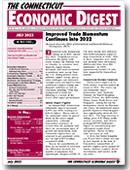


|
 |
July 2023 Connecticut Economic Digest |
 |
Improved Trade Momentum Continues into 2022
By Laura Jaworski, Office of International and Domestic Business Development, DECD
 mproved trade momentum coming out of 2021 carried into 2022. Geopolitical issues influenced the global trade scene, namely the Russian war on Ukraine, as sanctions were imposed, supply chains disrupted, and countries looked to purchase more energy from the U.S. Rising interest rates, inflation, higher energy prices, labor shortages, and increased transportation and logistics costs continued to impact supply and demand conditions as well as consumer spending. With this background in mind, the following is a review of the state's 2022 export performance. mproved trade momentum coming out of 2021 carried into 2022. Geopolitical issues influenced the global trade scene, namely the Russian war on Ukraine, as sanctions were imposed, supply chains disrupted, and countries looked to purchase more energy from the U.S. Rising interest rates, inflation, higher energy prices, labor shortages, and increased transportation and logistics costs continued to impact supply and demand conditions as well as consumer spending. With this background in mind, the following is a review of the state's 2022 export performance.
Annual Export Figures
In Annual 2022, Connecticut commodity exports increased 5.47% over 2021, totaling over $15.34 billion. Please refer to the associated tables for greater detail on the state's export composition. Although Connecticut continues to recover from the pandemic and there are encouraging signs of growth and momentum, state commodity exports have not returned to pre-pandemic levels nor the high of $17.4 billion recorded in 2018.
Due to the unavailability of data, we are unable to ascertain the differential between the number of companies that exported pre- and post-COVID-19. The most recent data indicates that 4,606 companies exported from Connecticut in 2020. 89% of these companies were small and medium-sized enterprises (SMEs) with fewer than 500 employees. In 2019, approximately 63,000 U.S. jobs were supported by Connecticut exports. [ read more ]
Solving the Office to Residential Conversion Puzzle
By Al Sylvestre, Research Analyst, Department of Labor
 ith almost a quarter of Hartford's available office space lying fallow as the city's residential vacancy rate hovers near two percent, shrinking office footprints suggest an obvious solution to the capital region's housing shortage. While the Capital Region Development Authority (CRDA) and state agencies work with real estate developers to turn the office glut into housing opportunity, an examination of office to residential conversion feasibility illustrates the complexity of achieving the office to residential space balance that can make the long-held vision of Hartford as a vibrant 24-hour city a reality. Examples from Philadelphia (1600 Arch Street) and Manhattan (180 Water Street) illustrate the challenges and opportunities for converting office space into desirable dwelling units. ith almost a quarter of Hartford's available office space lying fallow as the city's residential vacancy rate hovers near two percent, shrinking office footprints suggest an obvious solution to the capital region's housing shortage. While the Capital Region Development Authority (CRDA) and state agencies work with real estate developers to turn the office glut into housing opportunity, an examination of office to residential conversion feasibility illustrates the complexity of achieving the office to residential space balance that can make the long-held vision of Hartford as a vibrant 24-hour city a reality. Examples from Philadelphia (1600 Arch Street) and Manhattan (180 Water Street) illustrate the challenges and opportunities for converting office space into desirable dwelling units.
A building envelope's shape, along with the placement of its structural columns, elevator shafts, and stairwells, constitutes the geometry within which an apartment's living, sleeping, and workspace areas are laid out. Developers, architects, and designers must solve for the adequacy of light and air movement that make a dwelling unit livable. The building's location and proximity to public amenities completes the value proposition of conversion versus demolition and new construction. [ read more ]
|
 |
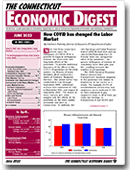


|
 |
June 2023 Connecticut Economic Digest |
 |
How COVID has changed the Labor Market
By Patrick.Flaherty, Director of Research, Department of Labor
 ow that three years have passed since the emergence of COVID-19 it is possible to begin to distinguish between the short-term and long-term effects of the pandemic. To provide additional measures of the effects of the COVID-19 pandemic on the labor market, the Bureau of Labor Statistics (BLS) conducted a series of Business Response Surveys. The initial survey was conducted in July through September 2020. Additional surveys were conducted in July to September 2021 and August to September 2022. The results of these surveys give some insights into the effects of the pandemic on the labor market nationally and here in Connecticut. In addition, the Job Openings and Labor Turnover Survey (JOLTS) from BLS and the Job-to-Job Flows from the U.S. Census show one unexpected effect of the pandemic - the greater willingness of workers to voluntarily leave their jobs and the resulting increase the number of job openings. ow that three years have passed since the emergence of COVID-19 it is possible to begin to distinguish between the short-term and long-term effects of the pandemic. To provide additional measures of the effects of the COVID-19 pandemic on the labor market, the Bureau of Labor Statistics (BLS) conducted a series of Business Response Surveys. The initial survey was conducted in July through September 2020. Additional surveys were conducted in July to September 2021 and August to September 2022. The results of these surveys give some insights into the effects of the pandemic on the labor market nationally and here in Connecticut. In addition, the Job Openings and Labor Turnover Survey (JOLTS) from BLS and the Job-to-Job Flows from the U.S. Census show one unexpected effect of the pandemic - the greater willingness of workers to voluntarily leave their jobs and the resulting increase the number of job openings.
The 2020 Business Response Survey showed that Connecticut's business response to the pandemic was similar to businesses in the nation as a whole. For example, 51.9% of establishments nation-wide told employees not to work and 51.3% of these continued to pay employees some or all of their pay while not working. In Connecticut, it was 52.8% and 48.1% respectively. Nationally, 55.6% of establishments experienced a decrease in demand for their products or services and 18.7% experienced a government-mandated closure. Connecticut's portion with decreased demand was 56.3% while the portion with a mandated closure was 17.3% in Connecticut. Only 17.8% of establishments nationally and 17.1% in Connecticut reported that they experienced no impact from the pandemic on their business operations. [ read more ]
The Unemployment Rate of All Towns Fell in 2022
By Jungmin Charles Joo, Department of Labor
 n 2022, the annual average statewide unemployment rate was 4.2%, down from 6.3% in 2021. As the labor force bounced back for the second year from the impact of the COVID-19 pandemic, all 169 municipalities experienced a decrease in their unemployment rate last year. n 2022, the annual average statewide unemployment rate was 4.2%, down from 6.3% in 2021. As the labor force bounced back for the second year from the impact of the COVID-19 pandemic, all 169 municipalities experienced a decrease in their unemployment rate last year.
2021 to 2022
The unemployment rate in all 169 cities and towns in the state fell in 2022. Roxbury had the lowest unemployment rate of 2.5%, while the residents of Hartford experienced the highest rate of 6.5% last year (see table on page 3 for the complete town data). Overall, a total of 128 cities and towns had jobless rates below the 2022 statewide figure of 4.2%, 37 had rates above it, and 4 had rates equal to it. By comparison, 134 cities and towns had rates below the 2021 statewide average of 6.3%, 30 above it, and 5 were the same.
Of the five largest cities in the state with a 2010 Census population of 100,000 or more, Stamford had the lowest unemployment rate of 3.9% in 2022. Hartford posted the highest jobless rate among the large cities at 6.5%. All five cities experienced over-the-year unemployment rate decreases. [ read more ]
|
 |
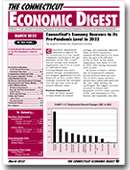

|
 |
May 2023 Connecticut Economic Digest |
 |
How Does Connecticut's Economic Growth Stack Up Against the Recent Budget Surpluses?
By Manisha Srivastava, Connecticut Office of Policy and Management
 here is a common adage that a strong stock market does not necessarily indicate a strong underlying economy, that the stock market is not the economy. What about budget surpluses - do year upon year of budget surpluses indicate a strong underlying economy? here is a common adage that a strong stock market does not necessarily indicate a strong underlying economy, that the stock market is not the economy. What about budget surpluses - do year upon year of budget surpluses indicate a strong underlying economy?
Connecticut (CT) has shifted from ongoing budget deficits during the 2010s following the Great Recession to budget surpluses, including billion plus dollar surpluses more recently. There are multiple factors responsible for these budget surpluses. As a result of the COVID-19 pandemic, the federal government stepped in with financial assistance including the Paycheck Protection Program and Enhanced Unemployment Insurance. In addition, the pandemic-mandated work from home policy (where possible) reduced state office expenses while waivers and other safety-oriented accommodations reduced the level of interactions with the public and hence expenses. And finally, certain tax revenue sources have continued to outperform and come in above projections. What do these strong revenues indicate regarding CT's economy, have CT's economic indicators similarly outperformed? Let's find out.
The primary revenue sources for the General Fund (GF) include Income Tax and Sales and Use Tax; in Fiscal Year (FY)1 2022, Income Tax made up 48.7% and Sales Tax made up 19.4% of General Fund revenues.2 There are two components to Income Tax, Withholding and Estimates & Finals, representing 31.7% and 17.1%, respectively, of General Fund revenues in FY 2022. About 20 other taxes, revenues, fees, and federal grants comprise the remaining 31.9% of the General Fund, including sources such as Corporation Tax, slot revenues, Real Estate Conveyance Tax, and the Pass-through Entity Tax. The primary drivers of the budget surpluses include Income, Sales, and the Pass-through Entity Tax. [ read more ]
|
 |
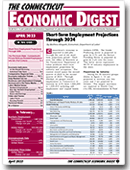


|
 |
April 2023 Connecticut Economic Digest |
 |
Short-Term Employment Projections Through 2024
By Matthew Krzyzek, Economist, Department of Labor
 onnecticut's economy is projected to add jobs through the end of the short-term projections period. Each year, the Office of Research at the Connecticut Department of Labor produces short-term employment projections by industry and occupation. The current round spans the second quarter of 2022 to the second quarter of 2024. Through 2024Q2, we project overall employment in Connecticut to increase by 2.5% from 1,800,395 to 1,845,444 including self-employment and unpaid family workers (UFW). The Goods-Producing sector is projected to grow by 3.7% and the Service-Providing Sector is projected to grow by 2.2% over two years. This latter sector represents 86.7% of industry employment in the state. onnecticut's economy is projected to add jobs through the end of the short-term projections period. Each year, the Office of Research at the Connecticut Department of Labor produces short-term employment projections by industry and occupation. The current round spans the second quarter of 2022 to the second quarter of 2024. Through 2024Q2, we project overall employment in Connecticut to increase by 2.5% from 1,800,395 to 1,845,444 including self-employment and unpaid family workers (UFW). The Goods-Producing sector is projected to grow by 3.7% and the Service-Providing Sector is projected to grow by 2.2% over two years. This latter sector represents 86.7% of industry employment in the state.
Projections by Industry
Among the 20 industry groups shown in figure 1, 16 are projected to increase over two years and 4 are projected to decline. The largest increases are expected in Health Care (+6,156), Accommodation & Food Services (+5,493), Manufacturing (+5,478), and Transportation & Warehousing (+4,643). These four industries account for more than half of the projected overall growth across all industries. The projected Health Care growth will bring that industry to early 2020 pre-pandemic employment levels. Accommodation & Food Services was one of the hardest hit industries during the COVID-19 lockdown and fell by almost 50% during the first half of 2020 from 134,000 to 71,000. That industry is projected to increase to almost 138,000 workers by the second quarter of 2024, exceeding 2020 pre-pandemic levels but still down from a series high of 144,000 reached in late 2019. The gains in Manufacturing are driven in large part by Transportation Equipment Manufacturing (NAICS 336), which is projected to account for 2,957 of the 5,478 job increase projected for the overall sector. Transportation & Warehousing quickly rebounded from the COVID-19 lockdown and added jobs throughout the recovery. The industry was up 14,500 jobs or 25% from 2020Q2 to 2022Q2 and is expected to continue to grow by 7% through 2024Q2. [ read more ]
The Provision State - Connecticut's Private Defense-Related Employment into the 21st Century
By Labor Department Research Staff Update
 he Office of Research at the Connecticut Department of Labor has been documenting and tracking industry employment in the state with our federal partners, the U.S. Bureau of Labor Statistics (BLS), since at least the late 1930's. Since the statistics began (and we have employment data back to 1939) defense-related manufacturing has been of interest to policymakers and the public. Tracking employment was a necessary endeavor during WW II for the planning of defense production in the war effort. Office of Research folklore has it rumored that future Governor Ella Grasso worked together with our office when she was assistant state director of research of the Federal War Manpower Commission during WW II.1 Consequently, the first Cold War end was expedited by a major U.S. defense industry build-up in the 1980's and supported strong statewide employment growth during that decade. Connecticut's aerospace and shipbuilding industry employment amongst other industry sectors helped the U.S. end the Cold War. [ read more ] he Office of Research at the Connecticut Department of Labor has been documenting and tracking industry employment in the state with our federal partners, the U.S. Bureau of Labor Statistics (BLS), since at least the late 1930's. Since the statistics began (and we have employment data back to 1939) defense-related manufacturing has been of interest to policymakers and the public. Tracking employment was a necessary endeavor during WW II for the planning of defense production in the war effort. Office of Research folklore has it rumored that future Governor Ella Grasso worked together with our office when she was assistant state director of research of the Federal War Manpower Commission during WW II.1 Consequently, the first Cold War end was expedited by a major U.S. defense industry build-up in the 1980's and supported strong statewide employment growth during that decade. Connecticut's aerospace and shipbuilding industry employment amongst other industry sectors helped the U.S. end the Cold War. [ read more ]
|
 |


|
 |
March 2023 Connecticut Economic Digest |
 |
Connecticut's Economy Recovers to its Pre-Pandemic Level in 2022
By Jungmin Charles Joo, Associate Research Analyst, Department of Labor
 onnecticut employment continued to improve for the second year in a row, nearly completely recovering to the pre-pandemic levels. The revised annual average total nonfarm employment rose 3.1% to a level of 1,665,600 in 2022. Correspondingly, last year's annual average unemployment rate dropped significantly to 4.2% from 6.3% in 2021. In fact, 2022 economy recovered the strongest over the last nine years as per annual diffusion index. onnecticut employment continued to improve for the second year in a row, nearly completely recovering to the pre-pandemic levels. The revised annual average total nonfarm employment rose 3.1% to a level of 1,665,600 in 2022. Correspondingly, last year's annual average unemployment rate dropped significantly to 4.2% from 6.3% in 2021. In fact, 2022 economy recovered the strongest over the last nine years as per annual diffusion index.
Nonfarm Employment
After the latest annual revision (based on annual average, not seasonally adjusted data), in 2022 Connecticut regained 49,300 jobs (3.1%), more than the gain of 45,600 jobs (2.9%) in 2021. In the nation employment rose faster at 4.3% in 2022, after having increased 2.9% in 2021.
As shown in Chart 1, all but one of Connecticut's industry sectors bounced back last year. Ten of eleven major industry sectors have added jobs back over the year, while mining was unchanged. The biggest recovery occurred in leisure and hospitality (10.9%), other services (4.8%), and information (3.7%). Leisure and hospitality was also the biggest job gainer (14,700), followed by education and health services (8,300). Financial activities (0.2%) and government (1.3%) posted the slowest job growth in 2022. [ read more ]
|
 |
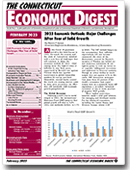

|
 |
February 2022 Connecticut Economic Digest |
 |
2023 Economic Outlook: Major Challenges After Year of Solid Growth
By Steven P. Lanza, Associate Professor-in-Residence, UConn Department of Economics
 s the Covid-19 pandemic moved to the back burner in 2022, the world, the country and the state of Connecticut wrestled with a new host of challenges that will continue to shape the economic outlook for 2023. Chief among them: the highest rates of inflation in over forty years, aggravated by Russia's war against Ukraine which has injected uncertainty in global commodity markets for energy and food. Meanwhile, central banks around the world are raising interest rates to tame price pressures-an effort that will inevitably chill economic growth going forward. s the Covid-19 pandemic moved to the back burner in 2022, the world, the country and the state of Connecticut wrestled with a new host of challenges that will continue to shape the economic outlook for 2023. Chief among them: the highest rates of inflation in over forty years, aggravated by Russia's war against Ukraine which has injected uncertainty in global commodity markets for energy and food. Meanwhile, central banks around the world are raising interest rates to tame price pressures-an effort that will inevitably chill economic growth going forward.
The Global Economy
Following a 6.0% rise in world output in 2021, the International Monetary Fund (IMF) projects that global growth will slow to 3.2% 2022, and moderate further, to 2.7% in 2023. The IMF outlook hinges on the assumptions that: inflation expectations will not become unmoored; the worst of the dislocations created by Russia's invasion of Ukraine are behind us; and monetary authorities do not tighten policy to such an extent as to engender widespread recessions and upheavals in financial markets. Though an actual decline in world output does not appear to be in the cards, IMF forecasters anticipate that more than 40 percent of the world's economies that report output data on a quarterly basis will experience a so-called "technical recession" of two or more quarters of negative GDP growth.
These topline projections, however, mask a wide gulf between the emerging and developed worlds. For the advanced economies, including the United States and Western Europe, where GDP rebounded by 5.2% in 2021 following its 4.4% plunge during the pandemic, output is expected to grow 2.4% in 2022 (slightly above its 20-year annual average of 2.1%) but by only 1.1% in 2023. High inflation will eat into purchasing power and rising interest rates will crimp consumer spending and business investment. In emerging markets, by contrast, where the toll of the pandemic was far less severe (output fell just 1.9% in 2020) and the 2021 rebound, at 6.6%, was brisker, output is expected to grow by 3.7% in 2022 and to maintain that pace in 2023. That growth rate, however, is significantly below the 20-year trend of 5.2% annually. [ read more ] |
 |
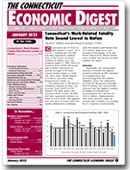

|
 |
January 2023 Connecticut Economic Digest |
 |
Connecticut's Work-Related Fatality Rate Second Lowest in Nation
By Erin C. Wilkins, Associate Research Analyst, Department of Labor
 onnecticut lost 23 lives to work injuries in 2021, for a rate of 1.4 deaths per 100,000 full-time equivalent workers. This is the lowest recorded number of deaths since the program began in 1992. This is a decrease from 2020's 29 deaths and is below Connecticut's annual average of 38 work-related deaths (Chart 1). Only one other state - Rhode Island - recorded a rate lower than Connecticut's (Table 1). onnecticut lost 23 lives to work injuries in 2021, for a rate of 1.4 deaths per 100,000 full-time equivalent workers. This is the lowest recorded number of deaths since the program began in 1992. This is a decrease from 2020's 29 deaths and is below Connecticut's annual average of 38 work-related deaths (Chart 1). Only one other state - Rhode Island - recorded a rate lower than Connecticut's (Table 1).
The nation lost 5,190 lives to workplace injuries in 2021, an increase from 2020's 4,764 deaths. The fatal injury rate increased from 3.4 per 100,000 full-time equivalent workers in 2020 to 3.6 in 2021. The highest loss was seen in Texas with 533 deaths, followed by California with 462 deaths and Florida with 315 deaths. High rates were recorded in Wyoming (10.4) and North Dakota (9.0). Rhode Island had 5 deaths, the lowest recorded number for states.
Industry
Nationally, the construction industry recorded the highest number of deaths at 986, followed by transportation and warehousing with 976 deaths. Together, these two industries account for 38 percent of deaths.
With 6 deaths, the construction industry had the highest number of deaths in Connecticut, accounting for 26.1 percent of 2021's deaths. Administrative and waste services came in second with 5 deaths, accounting for 21.7 percent of total deaths (Table 2). With an overall rate of 1.4, Connecticut saw a rate of 5.2 in construction and 2.5 in professional and business services. Rates for other industry sectors did not meet publishing criteria. [ read more ] |
 |
 |
 |
 |
|
 |
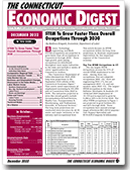

|
 |
December 2022 Connecticut Economic Digest |
 |
STEM To Grow Faster Than Overall Occupations Through 2030
By Matthew Krzyzek, Economist, Department of Labor
CURRENT SITUATION
 cience, Technology, Engineering, and Math (STEM) occupations are projected to grow faster than all occupations in Connecticut through 2030. These high-growth, good-paying occupations are distributed throughout most major industries in the state and include a variety of career opportunities for Connecticut workers. cience, Technology, Engineering, and Math (STEM) occupations are projected to grow faster than all occupations in Connecticut through 2030. These high-growth, good-paying occupations are distributed throughout most major industries in the state and include a variety of career opportunities for Connecticut workers.
The Connecticut Department of Labor discussed our 2020-2030 long-term projections in the September 2022 edition of the Connecticut Economic Digest. That article noted expectations of employment increasing by 201,000 jobs in Connecticut from 2020 to 2030. The industries projected to drive this overall growth include Accommodation & Food Services, Health Care, Transportation & Warehousing, and Professional, Scientific, & Technical Services. The long-term projections are conducted every two years by all 50 states and major territories at the industry and occupational level. This article focuses on STEM occupations within the long-term projections to illustrate employment expectations for this important segment of the Connecticut economy.
Top Ten STEM Occupations in CT
The ten largest STEM occupations account for 57% of overall STEM employment in the state. Among these ten occupations, four are computer occupations (SOC-15), three are engineering (SOC-17), two are management (SOC-11), and one involves sales (SOC-41). The largest STEM occupation in the state, Software Developers & Analysts (15-1256) had 2020 employment of 19,130 and is expected to grow by 5,280 or 28% to 24,410 by 2030. The other STEM occupations in Figure 1 are projected to grow between 8% and 22% through 2030. These occupations have annual average wages of between $63,380 (Computer User Support Specialist) and $150,629 (Computer & Information Systems Managers). STEM occupations earned an average of $103,214 overall in 2021, which compares favorably to $67,169 earned on average for all employment in the state [ read more ]
|  |
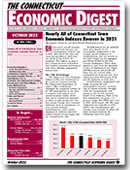

 |
 |
October 2022 Connecticut Economic Digest |
 |
Nearly All of Connecticut Town Economic Indexes Recover in 2021
By Jungmin Charles Joo, Department of Labor and Dana Placzek, Research, Department of Labor
 onnecticut's overall economy bounced back last year, as 99% of municipalities' indexes rose in 2021, after all of 169 cities and towns having fallen in 2020 from the effects of the COVID-19 pandemic. The indexes on page 3 give a broad measure of business and resident economic well-being of each town, allowing comparisons among them. onnecticut's overall economy bounced back last year, as 99% of municipalities' indexes rose in 2021, after all of 169 cities and towns having fallen in 2020 from the effects of the COVID-19 pandemic. The indexes on page 3 give a broad measure of business and resident economic well-being of each town, allowing comparisons among them.
The CTEI Methodology
The Connecticut Town Economic Indexes (CTEI) were introduced in 2015 and are released annually. The Connecticut Department of Labor's Office of Research developed the composite indexes of all 169 municipalities in the state to measure each town or city's overall economic health, which then can be ranked and compared to others to gain perspective. The four annual average town economic indicators used as components are total covered business establishments, total covered employment, inflation-adjusted covered annual average wages, and the unemployment rate.
Establishments are the physical work units located in the municipality. Employment is the number payroll employees in establishments that are located in the town. Wages are the aggregate payroll pay divided by the total average employment. These three measures come from the Quarterly Census of Employment and Wages (QCEW) program and include all those who are covered under unemployment insurance law, thus capturing nearly 100 percent of all payroll employees in each town. [ read more ]
Download CTEI 2005-2021 data.xlsx |
 |
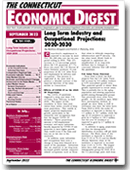

|
 |
September 2022 Connecticut Economic Digest |
 |
Long Term Industry and Occupational Projections: 2020-2030
By Matthew Krzyzek, Economist, and Patrick.Flaherty, Director of Research, Department of Labor
 onnecticut's employment is projected to increase by more than 201,000 jobs over the ten-year period ending in 2030. This 12% increase is 4.3 percentage points above the U.S. projection of 7.7%. Every two years, the U.S. Bureau of Labor Statistics produces 10-year projections of the U.S. labor force and employment by industry and occupation. This process is replicated at the state level to produce a detailed overview of the expected direction of the labor market in Connecticut. onnecticut's employment is projected to increase by more than 201,000 jobs over the ten-year period ending in 2030. This 12% increase is 4.3 percentage points above the U.S. projection of 7.7%. Every two years, the U.S. Bureau of Labor Statistics produces 10-year projections of the U.S. labor force and employment by industry and occupation. This process is replicated at the state level to produce a detailed overview of the expected direction of the labor market in Connecticut.
Effects of COVID-19 on the 2020-30 Projections
The COVID-19 pandemic triggered a steep and short U.S. recession from February to April 2020.1 The impact of this translates to lower base-year values than earlier rounds of long-term projections. This results in higher projected employment growth, particularly in the industries and occupations that had the largest COVID-19 declines.2 These projections assume a full-employment economy, and many industries heavily impacted by COVID-19 are projected to have higher growth than would occur if the base year was not so low due to the recession.
In addition, some industries and occupations have seen a change in long-term demand as a result of the pandemic. Industries that are expected to see long-term increased growth include computer-related occupations such as those that relate to telework computing infrastructure and IT security. On the other hand, Retail Trade is expected to experience an amplification of its long-term declines due to changes in consumer behavior that will outlast the pandemic. [ read more ] |
 |
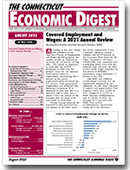

|
 |
August 2022 Connecticut Economic Digest |
 |
Covered Employment and Wages: A 2021 Annual Review
By Jonathan Kuchta, Research Analyst, Department of Labor
 ccording to the most recent data published by the Quarterly Census of Employment and Wages (QCEW) program, the number of jobs in Connecticut increased by 3.0 percent during 2021. The return of employees to work after the COVID shutdowns of 2020 was the primary cause for the increase. Total private industry employment, constituting 86.7 percent of the state's employment total, increased by 3.5 percent. Total government employment was relatively flat, declining 0.3 percent. It is important to note that this is a historical look at 2021 and it paints a less rosy picture of the economy than we know to be true based on 2022 data. ccording to the most recent data published by the Quarterly Census of Employment and Wages (QCEW) program, the number of jobs in Connecticut increased by 3.0 percent during 2021. The return of employees to work after the COVID shutdowns of 2020 was the primary cause for the increase. Total private industry employment, constituting 86.7 percent of the state's employment total, increased by 3.5 percent. Total government employment was relatively flat, declining 0.3 percent. It is important to note that this is a historical look at 2021 and it paints a less rosy picture of the economy than we know to be true based on 2022 data.
Average annual wages for all Connecticut jobs increased by 3.2 percent, to $77,839. Given the nation experienced a non-seasonally adjusted annual inflation rate of 4.7 percent in the Consumer Price Index for All Urban Consumers: All Items (CPIAUCNS), most employees lost purchasing power even with the nominal wage increase. In 2021, private sector wages increased by 3.2 percent to $78,820; government wages increased 2.7 percent to $71,462.
Like 2020, new business establishment creation was up significantly compared to pre-pandemic, as new firms continue to explore new opportunities. New business starts were 15,292 in 2021, compared to 12,747 in 2020. Overall, establishments rose to 133,921 in 2021, an increase of 5.4 percent over 2020. Total private establishments represented nearly all of the increase, reaching 130,547 in 2021. Government worksites increased 0.2 percent in the state, from 3,368 in 2020 to 3,374 in 2021 [ read more ] |
 |
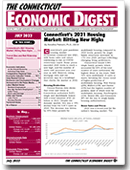


|
 |
July 2022 Connecticut Economic Digest |
 |
Connecticut's 2021 Housing Market: Hitting New Highs
By Nandika Prakash, Ph.D., DECD
 onnecticut's post-pandemic housing market momentum continued into 2021, with home sales and values continuing to rise as COVID restrictions eased. Home prices exceeded 2020 levels to reach a new high, and the number of units sold increased year over year as well. However, rising mortgage rates and low inventory may be a headwind that checks the market in 2022. onnecticut's post-pandemic housing market momentum continued into 2021, with home sales and values continuing to rise as COVID restrictions eased. Home prices exceeded 2020 levels to reach a new high, and the number of units sold increased year over year as well. However, rising mortgage rates and low inventory may be a headwind that checks the market in 2022.
Housing Production
Census Bureau data shows that cities and towns in Connecticut authorized 4,651 single and multifamily homes with a total valuation of $1.22 billion in 2021. Despite the dynamic market, this was a 15% decline from the 5,471 units in 2020. The decrease was driven by 45% fewer permits for multifamily housing compared to 2020 levels; permits for single family structures increased by 17% over 2020, perhaps reflecting changing living preferences.
Connecticut issued 2,941 single family permits which accounted for 63% of the total number of units authorized, the highest share in ten years. Only 32% were multifamily (5 units or more), breaking the recent trend of higher production of multifamily housing. New Haven (299), Milford (199), and Darien (159) had the highest number of permits, most of which were for multifamily housing. Southington (104), Bristol (94), and Greenwich (87) led the way in single family housing authorizations. [ read more ]
Transit Bus and Rail Ridership Trends
By Al Sylvestre, Research Analyst, Department of Labor
 ith transit bus and rail ridership nearing pre-pandemic levels, the return of passengers to Connecticut's public transportation systems is on an upward trajectory. This stands in contrast to ridership trends from 2017 to 2020 shown in Charts 1 and 2. Chart 1 shows the number of unlinked passenger trips1 for each of CT Transit's2 divisions. Passenger trip decreases from 2019 to 2020 range from 7.2% in Waterbury to 17% in the New Britain division. The Hartford division that operates and manages 30% of the state's transit buses experienced a 17% ridership reduction. Pandemic-induced ridership declines in the nine transit districts outside of CT Transit's divisions (Chart 2) ranged from 63.3% for the Mashantucket-Pequot system to a low of 3.9% in the Northwestern Transit District (NWCTD). The two highest ridership districts, the Greater Bridgeport Transit Authority (GBT) with 4.2 million boardings in 2020, and the Norwalk Transit District with 1.1 million boardings had 20.2% and 18.1% fewer riders than in 2019. The outlier among these regions is the Windham Region Transit District whose nearly 25% ridership increase may be attributable to its concentration of employers whose operations depend on in-person work. [ read more ] ith transit bus and rail ridership nearing pre-pandemic levels, the return of passengers to Connecticut's public transportation systems is on an upward trajectory. This stands in contrast to ridership trends from 2017 to 2020 shown in Charts 1 and 2. Chart 1 shows the number of unlinked passenger trips1 for each of CT Transit's2 divisions. Passenger trip decreases from 2019 to 2020 range from 7.2% in Waterbury to 17% in the New Britain division. The Hartford division that operates and manages 30% of the state's transit buses experienced a 17% ridership reduction. Pandemic-induced ridership declines in the nine transit districts outside of CT Transit's divisions (Chart 2) ranged from 63.3% for the Mashantucket-Pequot system to a low of 3.9% in the Northwestern Transit District (NWCTD). The two highest ridership districts, the Greater Bridgeport Transit Authority (GBT) with 4.2 million boardings in 2020, and the Norwalk Transit District with 1.1 million boardings had 20.2% and 18.1% fewer riders than in 2019. The outlier among these regions is the Windham Region Transit District whose nearly 25% ridership increase may be attributable to its concentration of employers whose operations depend on in-person work. [ read more ]
|
 |
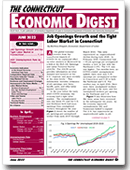


|
 |
June 2022 Connecticut Economic Digest |
 |
2021 Unemployment Rate by Town
By Jungmin Charles Joo, Department of Labor
 n 2021, the annual average statewide unemployment rate was 6.3%, down from 7.8% in 2020. As the labor force bounced back from the impact of the COVID-19 pandemic, all 169 municipalities experienced a decrease in their unemployment rate last year. n 2021, the annual average statewide unemployment rate was 6.3%, down from 7.8% in 2020. As the labor force bounced back from the impact of the COVID-19 pandemic, all 169 municipalities experienced a decrease in their unemployment rate last year.
2020 to 2021
The unemployment rate in all 169 cities and towns in the state fell in 2021. Cornwall had the lowest unemployment rate of 3.7%, while the residents of Hartford experienced the highest rate of 11.0% last year (see table on page 3 for the complete town data). Overall, a total of 134 cities and towns had jobless rates below the 2021 statewide figure of 6.3%, 31 had rates above it, and 4 had rates equal to it. By comparison, 127 cities and towns had rates below the 2020 statewide average of 7.8%, 39 above it, and 3 were the same.
Of the five largest cities in the state with a 2010 Census population of 100,000 or more, Stamford had the lowest unemployment rate of 5.7% in 2021. Hartford posted the highest jobless rate among the large cities at 11.0%. All five cities experienced over-the-year unemployment rate decreases. [ read more ]
Job Openings Growth and the Tight Labor Market in Connecticut
By Matthew Krzyzek, Economist, Department of Labor
 s the global economy recovers from the tumultuous impacts of COVID-19, its continued effect on labor markets is illustrated by a look at the BLS Job Openings and Labor Turnover Survey (JOLTS). The JOLTS survey provides information on labor demand and turnover at the U.S., regional, and most recently at the state levels.1 This information includes estimates of job openings, new hires, layoffs, quits, and other labor market movements. s the global economy recovers from the tumultuous impacts of COVID-19, its continued effect on labor markets is illustrated by a look at the BLS Job Openings and Labor Turnover Survey (JOLTS). The JOLTS survey provides information on labor demand and turnover at the U.S., regional, and most recently at the state levels.1 This information includes estimates of job openings, new hires, layoffs, quits, and other labor market movements.
In the year before the early 2020 COVID-recession, the economy had a tight labor market. The unemployment rate was below 4% and the U.S. and Northeast both had more openings than unemployed workers throughout the year. Figure 1 shows the number of job openings per unemployed worker from early 2019 through March 2022. This ratio experienced an unprecedented decline during early 2020. In February 2020, Connecticut had 1.05 job openings per unemployed worker, a level in line with the Northeast (1.07). The U.S. rate was higher. Two months later, as COVID-related unemployment spiked, there were only 0.33 openings per unemployed worker in Connecticut and 0.20 in both the Northeast and U.S. Put another way, in April 2020, there were three unemployed workers per opening in the state, and five unemployed workers per opening in the Northeast and U.S. [ read more ]
|
 |
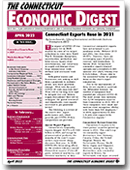

|
 |
May 2022 Connecticut Economic Digest |
 |
Short-Term Employment Projections Through 2023
By Matthew Krzyzek, Economist, Department of Labor
CURRENT SITUATION
 he past two years have been a period of unprecedented economic change during which labor markets adapted to COVID-19 mitigation. In early 2020, the US economy had a 2-month recession, the shortest on record.1 Employment peaked in February at 152.5 million and fell by 22 million two months later. Employment began to quickly rebound and more than half of the 22 million jobs lost were recovered by September 2022. The most recent month of data marks two years from the February 2020 pre-COVID employment peak and show that the current employment level has recovered 92.8% of jobs lost nationwide during the recession. he past two years have been a period of unprecedented economic change during which labor markets adapted to COVID-19 mitigation. In early 2020, the US economy had a 2-month recession, the shortest on record.1 Employment peaked in February at 152.5 million and fell by 22 million two months later. Employment began to quickly rebound and more than half of the 22 million jobs lost were recovered by September 2022. The most recent month of data marks two years from the February 2020 pre-COVID employment peak and show that the current employment level has recovered 92.8% of jobs lost nationwide during the recession.
Figure 1 shows the impact of the COVID-19 recession and recovery on northeast states through March 2022. Every northeast state had 2020 percent losses that were steeper than the U.S. Connecticut's 17% decline was the second lowest in the Northeast. Adjacent states of Massachusetts, New York, and Rhode Island had respective drops of 18.4%, 20.2%, and 21.3%. In the two years since the February 2020 peak, Connecticut has recovered 81.8% of the jobs lost during the COVID-recession, more than New York (76.4%), but less than Massachusetts (87.1%) and Rhode Island (85.1%). [ read more ] |
 |



|
 |
April 2022 Connecticut Economic Digest |
 |
Connecticut Exports Rose in 2021
By Laura Jaworski, Office of International and Domestic Business Development, Department of Economic and Community Development
 he impact of COVID-19 was greatly felt in 2020, marked by some of the largest reductions in trade since World War II. Economic disruptions, uncertainties, production and labor issues, supply chain reverberations, and reductions in supply and demand drove large international trade declines and increased trade costs. he impact of COVID-19 was greatly felt in 2020, marked by some of the largest reductions in trade since World War II. Economic disruptions, uncertainties, production and labor issues, supply chain reverberations, and reductions in supply and demand drove large international trade declines and increased trade costs.
With global leaders and businesses now looking to shift from a pandemic to endemic phase, new trade questions emerge. What does the post-COVID-19 trade map look like? What will be the long-term shift to mitigate risk and address supply disruptions? How will we reimagine the global economy? And importantly, have exports recovered to pre-pandemic levels?
The following is a review of the state's 2021 export performance and, where possible, pre-COVID-19 data comparisons are provided. [ read more ]
Much Ado About Traffic Safety
By Al Sylvestre, Research Analyst, Department of Labor
 n the fifth day of spring 2020, Connecticut's roads became nearly deserted as the governor ordered that all but essential businesses and institutions stop in-person operations as a world-wide pandemic took hold. Despite near-universal compliance with the stay-at-home order, 301 people-the most since 2016-would die in motor vehicle crashes by year's end. The upward trend shown in the Crash Data Table continued through 2021 with traffic fatalities rising to 323. Connecticut's experience reflects the national trend in which motor-vehicle crashes killed 38,680 people in 2020. While traffic deaths across the US fell by 8% in the 2010's, pedestrian fatalities spiked by 42%. [ read more ] n the fifth day of spring 2020, Connecticut's roads became nearly deserted as the governor ordered that all but essential businesses and institutions stop in-person operations as a world-wide pandemic took hold. Despite near-universal compliance with the stay-at-home order, 301 people-the most since 2016-would die in motor vehicle crashes by year's end. The upward trend shown in the Crash Data Table continued through 2021 with traffic fatalities rising to 323. Connecticut's experience reflects the national trend in which motor-vehicle crashes killed 38,680 people in 2020. While traffic deaths across the US fell by 8% in the 2010's, pedestrian fatalities spiked by 42%. [ read more ]
|
 |
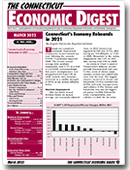

|
 |
March 2022 Connecticut Economic Digest |
 |
Connecticut's Economy Rebounds in 2021
By Jungmin Charles Joo, Associate Research Analyst, Department of Labor
 hough not completely recovered, Connecticut employment turned around last year following the severely COVID-19 pandemic-impacted 2020. The revised annual average total nonfarm employment rose 2.7% to a level of 1,613,000. Correspondingly, last year's unemployment rate dropped to 6.3% from 7.8% in 2020. Overall, 2021 economy recovered to a similar strength of 2018, as per annual diffusion index. hough not completely recovered, Connecticut employment turned around last year following the severely COVID-19 pandemic-impacted 2020. The revised annual average total nonfarm employment rose 2.7% to a level of 1,613,000. Correspondingly, last year's unemployment rate dropped to 6.3% from 7.8% in 2020. Overall, 2021 economy recovered to a similar strength of 2018, as per annual diffusion index.
Nonfarm Employment
After the latest annual revision (based on annual average, not seasonally adjusted data), in 2021 Connecticut regained 42,300 jobs (2.7%), after having lost 125,400 jobs, or -7.4% in 2020. Meanwhile in the nation employment rose 2.8% in 2021, after having shed 5.8% in 2020.
As shown in Chart 1, most of Connecticut's industry sectors partially bounced back last year. In fact, seven of eleven major industry sectors have added jobs back over the year. The biggest recovery occurred in leisure and hospitality (14.1%), construction (4.6%), and trade, transportation and utilities (4.4%). Leisure and hospitality was also the biggest job gainer (16,500), followed by trade, transportation, and utilities (12,100). On the other hand, manufacturing (-0.3%) and government (-0.3%) lost jobs over the year. The biggest job loss was in financial activities (-2,500, -2.1%). [ read more ]
|
 |
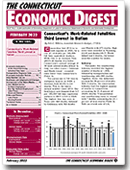

|
 |
February 2022 Connecticut Economic Digest |
 |
Connecticut's Work-Related Fatalities Third Lowest in Nation
By Erin C. Wilkins, Associate Research Analyst, Department of Labor
 onnecticut lost 29 lives to work injuries in 2020, for a rate of 1.8 deaths per 100,000 full-time equivalent workers. While this is an increase from 2019's 26 deaths, it is below Connecticut's annual average of 38 work-related deaths. Only two other states - Delaware and Rhode Island - recorded rates lower than Connecticut's onnecticut lost 29 lives to work injuries in 2020, for a rate of 1.8 deaths per 100,000 full-time equivalent workers. While this is an increase from 2019's 26 deaths, it is below Connecticut's annual average of 38 work-related deaths. Only two other states - Delaware and Rhode Island - recorded rates lower than Connecticut's
The nation lost 4,764 lives to workplace injuries in 2020, a decrease from 2019's 5,333 deaths. This is the lowest annual number since 2013. The fatal injury rate dropped from 3.5 per 100,000 full-time equivalent workers in 2019 to 3.4 in 2020. The highest loss was seen in Texas with 469 deaths, followed by California with 463 deaths and Florida with 275 deaths. High rates were recorded in Wyoming (13.0) and Alaska (10.7). Rhode Island had 5 deaths, the lowest recorded number for states.
Industry
Nationally, the construction industry recorded the highest number of deaths at 1,008, followed by transportation and warehousing with 805 deaths. Together, these two industries account for 38 percent of deaths.
With 9 deaths, the construction industry had the highest number of deaths in Connecticut, accounting for 31.0 percent of 2020's deaths. Transportation and warehousing came in second with 7 deaths, accounting for 24.1 percent of total deaths. With an overall rate of 1.8, Connecticut saw a rate of 8.3 in construction. Rates for other industry sectors did not meet publishing criteria. [ read more ] |
 |
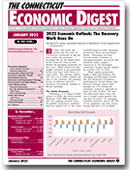

|
 |
January 2022 Connecticut Economic Digest |
 |
2022 Economic Outlook: The Recovery Work Goes On
By Steven P. Lanza, Associate Professor-in-Residence, UConn Department of Economics
 n 2021, the world, the country and the state of Connecticut continued to dig out from under the economic wreckage left by the Alpha wave of the Covid-19, even as they fended off emerging mutations of the virus. While production has largely returned to pre-pandemic levels, jobs have been slower to come back. The recovery efforts will carry on in 2022, despite the rise of new variants, the growing threat of inflation, and the hesitancy of would-be workers to fill job openings. n 2021, the world, the country and the state of Connecticut continued to dig out from under the economic wreckage left by the Alpha wave of the Covid-19, even as they fended off emerging mutations of the virus. While production has largely returned to pre-pandemic levels, jobs have been slower to come back. The recovery efforts will carry on in 2022, despite the rise of new variants, the growing threat of inflation, and the hesitancy of would-be workers to fill job openings.
The Global Economy
Following a 3.1% drop in world output in 2020, the International Monetary Fund (IMF) projects that the ongoing recovery from the global coronavirus epidemic will have added 5.9% to the value of world output in 2021, boosting production above pre-pandemic levels. Assuming vaccines become widely available in emerging markets and fiscal and monetary policy support continues in the developed economies, output should expand by another 4.9% in 2022.
These topline projections mask a wide gulf between the emerging and developed worlds. For the advanced economies, including the United States and Western Europe, where GDP plunged by 4.5% during the pandemic, output is expected to grow by 4.9% in 2022-two and one-half times faster than the rate of trend output growth over the past 20 years. In emerging markets, however, where the toll of the pandemic was less severe (output fell just 2.1% in 2020) growth rates in 2022 are expected to reach 5.1%, but that is below the 5.4% 20-year average for this group of economies. [ read more ] |
 |
 |
 |
 |
|
 |
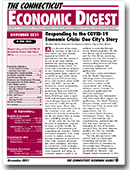

|
 |
November 2021 Connecticut Economic Digest |
 |
Responding to the COVID-19 Economic Crisis: One City's Story
By Dean Mack, Economic Development Officer, City of New Haven
 s in the rest of the world, the economy in the City of New Haven has been heavily impacted by COVID 19. Quantitative data has proven to be one of our most reliable methods for understanding the development of the COVID 19 crisis and especially its impacts on our businesses. Continued unemployment claims topped out at 10,000 in April 2020, which made up over 15% of our labor force, and remained above 6,000 until July 2021. At least 66 businesses closed permanently, City parking revenues plummeted from over $100,000 per week in February 2020 to below $5,000 per week in April 2020, and downtown pedestrian counts dropped from over 65,000 per week to 11,000 during the same time span. These data points help us review the arch of the economic crisis with an added level of understanding that we did not always have as events were unfolding around us. s in the rest of the world, the economy in the City of New Haven has been heavily impacted by COVID 19. Quantitative data has proven to be one of our most reliable methods for understanding the development of the COVID 19 crisis and especially its impacts on our businesses. Continued unemployment claims topped out at 10,000 in April 2020, which made up over 15% of our labor force, and remained above 6,000 until July 2021. At least 66 businesses closed permanently, City parking revenues plummeted from over $100,000 per week in February 2020 to below $5,000 per week in April 2020, and downtown pedestrian counts dropped from over 65,000 per week to 11,000 during the same time span. These data points help us review the arch of the economic crisis with an added level of understanding that we did not always have as events were unfolding around us.
As the crisis hit, the City was focused on immediate response in terms of public health, the continuity of government and supporting our economy. Federal assistance programs were being created to replace income or provide temporary or permanent relief from required payments like taxes, mortgage, and loans to businesses. Local economic development activities shifted to crisis response and triage as economic impacts rolled in. In addition to assisting through locally-funded programs, like the New Haven digital marketplace and Eat New Haven marketing program, the City also became a resource center, identifying and understanding Federal and State assistance programs and connecting businesses with applications. [ read more ] |
 |
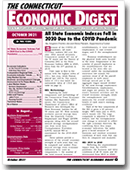

 |
 |
October 2021 Connecticut Economic Digest |
 |
All State Economic Indexes Fell in 2020 Due to the COVID Pandemic
By Jungmin Charles Joo, Department of Labor and Dana Placzek, Research, Department of Labor
 ecause of the COVID-19 pandemic, all state economic indexes fell over the year. After annual revisions, Connecticut ranked 35th out of the 50 states and the District of Columbia (DC) in the State Economic Indexes (SEI) in 2020, down from the 25th position in 2019. ecause of the COVID-19 pandemic, all state economic indexes fell over the year. After annual revisions, Connecticut ranked 35th out of the 50 states and the District of Columbia (DC) in the State Economic Indexes (SEI) in 2020, down from the 25th position in 2019.
Utah came in first in the nation with the highest index of 143.1 last year, while Hawaii placed last (103.3). Our state's index of 114.2 was below the nationwide value of 119.8
SEI: Methodology
Applying the same components and methodology of the Connecticut Town Economic Indexes (See September 2021 issue), the Connecticut Department of Labor's Office of Research also developed the State Economic Indexes for all 50 states and DC. With recently available annual average data from the Quarterly Census Employment and Wages (QCEW) program, along with the revised annual average unemployment rate from Local Area Unemployment Statistics (LAUS), annual SEI is reestimated for the 2010-2020 period.
These indexes provide a measure of the overall economic strength of each state that can be compared and ranked. Four annual average state economic indicators were used as components: 1. the number of the total covered business establishments, 2. total covered employment, 3. real covered wages, and 4. the unemployment rate. [ read more ]
Download SEI 2010-2020 data.xlsx |
 |
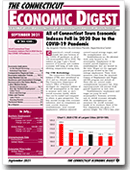

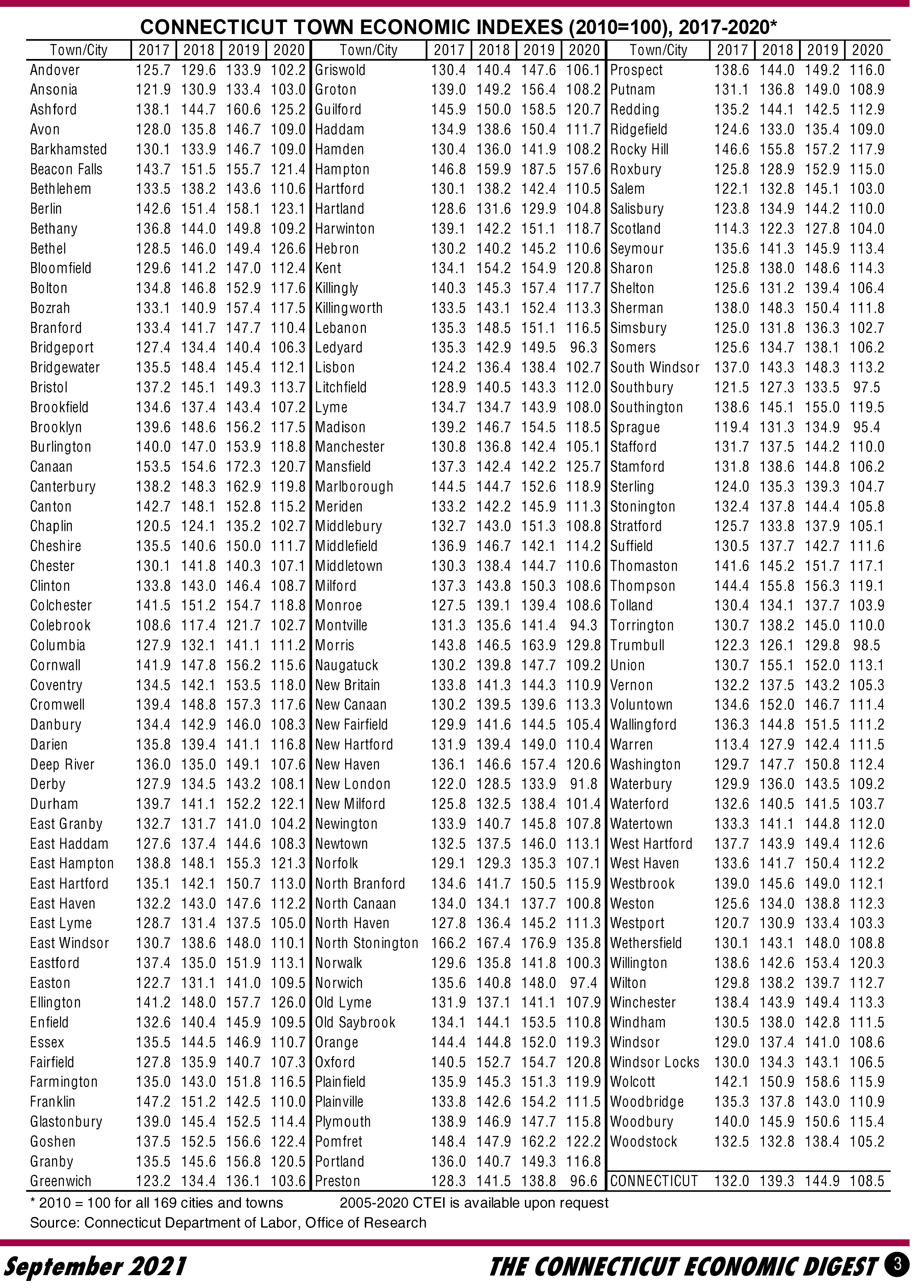 |
 |
September 2021 Connecticut Economic Digest |
 |
All of Connecticut Town Economic Indexes Fell in 2020 Due to the COVID-19 Pandemic
By Jungmin Charles Joo, Department of Labor and Dana Placzek, Research, Department of Labor
 onnecticut's overall economy shrank last year because of the COVID-19 pandemic, as all of 169 municipalities' fell in 2020. The indexes on page 3 give a broad measure of business and resident economic well-being of each town, allowing comparisons among them. onnecticut's overall economy shrank last year because of the COVID-19 pandemic, as all of 169 municipalities' fell in 2020. The indexes on page 3 give a broad measure of business and resident economic well-being of each town, allowing comparisons among them.
The CTEI Methodology
The Connecticut Town Economic Indexes (CTEI) were introduced in 2015 and are released annually. The Connecticut Department of Labor's Office of Research developed the composite indexes of all 169 municipalities in the state to measure each town or city's overall economic health, which then can be ranked and compared to others to gain perspective. The four annual average town economic indicators used as components are total covered business establishments, total covered employment, inflation-adjusted covered annual average wages, and the unemployment rate.
Establishments are the physical work units located in the municipality. Employment is the number payroll employees in establishments that are located in the town. Wages are the aggregate payroll pay divided by the total average employment. These three measures come from the Quarterly Census of Employment and Wages (QCEW) program and include all those who are covered under unemployment insurance law, thus capturing nearly 100 percent of all payroll employees in each town. [ read more ]
Download CTEI 2005-2020 data.xlsx |
 |
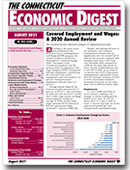

|
 |
August 2021 Connecticut Economic Digest |
 |
Covered Employment and Wages: A 2020 Annual Review
By Jonathan Kuchta, Research Analyst, Department of Labor
 ccording to the most recent data published by the Quarterly Census of Employment and Wages (QCEW) program, the number of jobs in Connecticut decreased by 7.5 percent during 2020. The impact of the Coronavirus pandemic was the primary driver of employment and wage changes in 2020. Total private industry employment, constituting 86.2 percent of the state's employment total, decreased by 7.8 percent. Total government employment was also down 5.3 percent. ccording to the most recent data published by the Quarterly Census of Employment and Wages (QCEW) program, the number of jobs in Connecticut decreased by 7.5 percent during 2020. The impact of the Coronavirus pandemic was the primary driver of employment and wage changes in 2020. Total private industry employment, constituting 86.2 percent of the state's employment total, decreased by 7.8 percent. Total government employment was also down 5.3 percent.
Average annual wages for all Connecticut jobs increased by 8.1 percent, to $75,411. One must keep in mind that this increase is mostly due to lower wage earners no longer being employed, raising the average. In 2020, private sector wages increased by 8.2 percent to $76,341; government wages increased 7.3 percent to $69,594.
Despite, and perhaps because of the pandemic, new business establishment creation was up significantly over the second half of 2020 as the economy reopened. New business starts were 5,927 from July-December 2020, compared to 4,908 for the same time period in 2019. Overall, establishments rose to 127,003 in 2020, an increase of 2.6 percent over 2019. Total private establishments represented nearly all of the increase, reaching 123,635 in 2020. Government worksites increased 0.6 percent in the state, from 3,347 in 2019 to 3,368 in 2020. [ read more ] |
 |
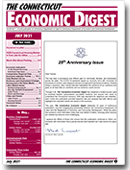


|
 |
July 2021 Connecticut Economic Digest |
 |
2020 Connecticut Housing Market: A Year Like No Other
By Kolie Sun, Senior Research Analyst, Department of Economic and Community Development
 onnecticut's housing market saw notable gains last year due in part to COVID-19, which spurred an outmigration from large urban areas like New York City. For example, home prices hit an all-time high and sales surged to their highest levels in sixteen years. This article examines these and other factors that contributed to a strong housing market in 2020. onnecticut's housing market saw notable gains last year due in part to COVID-19, which spurred an outmigration from large urban areas like New York City. For example, home prices hit an all-time high and sales surged to their highest levels in sixteen years. This article examines these and other factors that contributed to a strong housing market in 2020.
Housing Production
According to data released from the Bureau of the Census, cities and towns in Connecticut authorized 5,471 single and multifamily homes with a total valuation of $1.061 billion in 2020. This level of production represented a 6.5% decrease from 5,854 in 2019, but an 13.6% increase from 4,815 in 2018.
In 2020, Fairfield County authorized the most permits (34.0%), followed by New Haven County (25.1%) and Hartford County (15.5%). Windham County had the smallest share (2.7%). Connecticut issued 2,512 single family permits which accounted for 45.9% of the total number of housing units authorized, while 48.9% were multifamily (5 units or more), continuing the recent trend of higher demand for multifamily housing-especially in urban areas. [ read more ]
Much Ado About Parking
By Al Sylvestre, Research Analyst, Department of Labor
 ith more parking space than public parkland in its downtown, Hartford's planners are considering the role parking plays in city life. The 435.2 acres of parking in downtown's two square miles would cover the University of Hartford campus, Bushnell Park, and the entire river-front park system in Hartford and East Hartford combined. Comparable cities such as Cambridge, MA and Arlington, VA dedicate 80% less land to parking than our capital city. This article looks at the challenges excess parking brings to Hartford; the ambitious measure taken by the city to integrate parking with development to attract new residents; and a new downtown development that applies design principles prioritizing vibrant street life over storing cars. ith more parking space than public parkland in its downtown, Hartford's planners are considering the role parking plays in city life. The 435.2 acres of parking in downtown's two square miles would cover the University of Hartford campus, Bushnell Park, and the entire river-front park system in Hartford and East Hartford combined. Comparable cities such as Cambridge, MA and Arlington, VA dedicate 80% less land to parking than our capital city. This article looks at the challenges excess parking brings to Hartford; the ambitious measure taken by the city to integrate parking with development to attract new residents; and a new downtown development that applies design principles prioritizing vibrant street life over storing cars.
From 1960 to 2000, Hartford's parking-to-building-area ratio more than doubled because of its desire to emulate suburbs' easy access to parking. Map 1 shows the results of this trend. The city's 21st century development priorities are evolving from its pursuit of Class A office space1 to adding housing that would transform downtown from a briefcase town to a vibrant and diverse 24-hour community with active street life. Since 2014, 881 apartments have been added downtown, with 477 more under construction, and 188 units in planning or design phases. [ read more ] |
 |
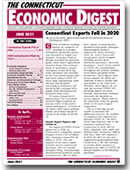


|
 |
June 2021 Connecticut Economic Digest |
 |
Connecticut Exports Fell in 2020
By Laura Jaworski, Office of International and Domestic Business Development, Department of Economic and Community Development
 OVID-19 had far-reaching impacts on commerce in 2020, resulting in economic disruptions, production issues, and reductions in supply and demand. Consumer demand sharply increased for particular goods, while others experienced dramatic drops. Extraordinary levels of uncertainty caused consumers to hold off on big ticket purchases and durables. As the virus spread along trade and travel routes, COVID-19 drove large international trade declines and disrupted everything as lockdowns and slowed border crossings led to supply chain disruptions and increased trade costs. OVID-19 had far-reaching impacts on commerce in 2020, resulting in economic disruptions, production issues, and reductions in supply and demand. Consumer demand sharply increased for particular goods, while others experienced dramatic drops. Extraordinary levels of uncertainty caused consumers to hold off on big ticket purchases and durables. As the virus spread along trade and travel routes, COVID-19 drove large international trade declines and disrupted everything as lockdowns and slowed border crossings led to supply chain disruptions and increased trade costs.
To assess Connecticut's export status, The Connecticut Economic Digest conducts an annual review of the state's export performance. A review of the state's 2020 export position follows, all of which should be viewed in the frame of COVID-19. [ read more ]
2020 Unemployment Rate by Town
By Jungmin Charles Joo, Department of Labor
 n 2020, the annual average statewide unemployment rate was 7.9%, up from 3.6% in 2019. Due to the COVID-19 pandemic, all 169 municipalities experienced an increase in their unemployment rate last year. n 2020, the annual average statewide unemployment rate was 7.9%, up from 3.6% in 2019. Due to the COVID-19 pandemic, all 169 municipalities experienced an increase in their unemployment rate last year.
2019 to 2020
The unemployment rate in all 169 cities and towns in the state rose in 2020. Sharon had the lowest unemployment rate of 4.4%, while the residents of Norwich experienced the highest rate of 14.0% last year (see table on page 3 for the complete town data). Overall, a total of 127 cities and towns had jobless rates below the 2020 statewide figure of 7.9%, 40 had rates above it, and 2 had rates equal to it. By comparison, 126 cities and towns had rates below the 2019 statewide average of 3.6%, 31 above it, and 12 were the same.
Of the five largest cities in the state with a 2010 Census population of 100,000 or more, Stamford had the lowest unemployment rate of 8.1% in 2020. Hartford posted the highest jobless rate among the large cities at 13.3%. All five cities experienced over-the-year unemployment rate increases. [ read more ]
|
 |
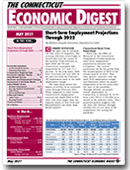 |
 |
May 2021 Connecticut Economic Digest |
 |
Short-Term Employment Projections Through 2022
By Matthew Krzyzek, Economist, Department of Labor
 he past year is certainly one that won't be forgotten. The economy fell from record highs to record lows over the course of two months. From February to April 2020, the US and Connecticut economies fell respectively by 14.7 and 17.2 percent. In the year since, both have recovered just over 58% of the jobs lost from the February US employment peak to the April employment trough. When compared to other states, Connecticut's employment recovery rate (April 2020 to Feb. 2021) has been larger than the adjacent states of New York and Massachusetts but lower than Rhode Island's. he past year is certainly one that won't be forgotten. The economy fell from record highs to record lows over the course of two months. From February to April 2020, the US and Connecticut economies fell respectively by 14.7 and 17.2 percent. In the year since, both have recovered just over 58% of the jobs lost from the February US employment peak to the April employment trough. When compared to other states, Connecticut's employment recovery rate (April 2020 to Feb. 2021) has been larger than the adjacent states of New York and Massachusetts but lower than Rhode Island's.
Connecticut Short-Term Projections
Each year, the Office of Research at the Connecticut Department of Labor produces short-term employment projection by industry and occupation. The current projections are for the period from the second quarter of 2020 to the second quarter of 2022. This base quarter coincides with the April 2020 employment trough and illustrates where we project employment to be two years after the start of the pandemic. Through 2022Q2, we project overall employment in Connecticut to increase by 13.5% from 1,541,793 to 1,750,039, as is shown in the industry table. This projected growth suggests that the state will rebound through 2022Q2 and recover most of the employment lost during the pandemic. [ read more ]
|
 |
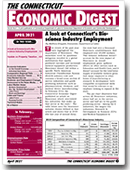 |
 |
April 2021 Connecticut Economic Digest |
 |
A look at Connecticut's Bioscience Industry Employment
By Matthew Krzyzek, Economist, Department of Labor
 he events of the past year have highlighted the importance of Bioscience. The immediate need for pandemic mitigation resulted in a global mobilization that rapidly produced vaccines and increased medical equipment production. Bioscience Doesn't fall within a specific North American Industrial Classification System (NAICS) industry code and contains a broad cross-section of service industries and goods producing industries such as pharmaceutical, chemical, and medical device manufacturing.1 In February 2012, the Connecticut Economic Digest published an article on Bioscience which overviewed key industries that make up that sector in the state.2 The table below uses the bioscience industry cluster defined in that article and shows that in 2019 (the last year of annual data), the state had over a thousand Bioscience establishments that employed over 23,000 workers. This industry definition Doesn't account for the total impact of Bioscience on overall employment given spillover effects on other sectors such as Education and Health Care, and it Doesn't account for the total labor supply of available workers given that many employed in other forms of manufacturing or research & development have compatible occupational skills that would be relevant to an employer looking to expand in the state. he events of the past year have highlighted the importance of Bioscience. The immediate need for pandemic mitigation resulted in a global mobilization that rapidly produced vaccines and increased medical equipment production. Bioscience Doesn't fall within a specific North American Industrial Classification System (NAICS) industry code and contains a broad cross-section of service industries and goods producing industries such as pharmaceutical, chemical, and medical device manufacturing.1 In February 2012, the Connecticut Economic Digest published an article on Bioscience which overviewed key industries that make up that sector in the state.2 The table below uses the bioscience industry cluster defined in that article and shows that in 2019 (the last year of annual data), the state had over a thousand Bioscience establishments that employed over 23,000 workers. This industry definition Doesn't account for the total impact of Bioscience on overall employment given spillover effects on other sectors such as Education and Health Care, and it Doesn't account for the total labor supply of available workers given that many employed in other forms of manufacturing or research & development have compatible occupational skills that would be relevant to an employer looking to expand in the state.
The pie chart illustrates that across all Bioscience industries, about half are in the service sector and half are in the goods producing sector. Among the 8 industries, the largest two industries, Research & Development in Sciences (32%) and Medical Equipment & Supplies Manufacturing (28%) account for about half of Bioscience employment in the state. [ read more ]
Update on Property Taxation
By Al Sylvestre, Research Analyst, Department of Labor
 rom the Lake Chaffee Improvement Association (Ashford) to the Borough of Jewett City (Griswold) to sandy Miami Beach (Old Lyme), property taxes1 levied by Connecticut's 169 municipalities and 310 taxing districts finance public education, safety, and infrastructure as well as some private roads and security. Real estate, motor vehicle, and personal property taxes constitute more than half of city, town, and district revenue and 98.5% of local tax collection to finance services provided by jurisdictions shown in Table 1. This article outlines local tax-assessment structures and describes novel solutions the city of Hartford developed to balance taxation among homeowners and commercial property owners. The Hartford example was chosen because its methods affect a broad cross section of property-tax payers rather than targeted relief offered by many of Connecticut's municipalities. The article concludes by describing the Massachusetts and New York experiences with property taxation limits. rom the Lake Chaffee Improvement Association (Ashford) to the Borough of Jewett City (Griswold) to sandy Miami Beach (Old Lyme), property taxes1 levied by Connecticut's 169 municipalities and 310 taxing districts finance public education, safety, and infrastructure as well as some private roads and security. Real estate, motor vehicle, and personal property taxes constitute more than half of city, town, and district revenue and 98.5% of local tax collection to finance services provided by jurisdictions shown in Table 1. This article outlines local tax-assessment structures and describes novel solutions the city of Hartford developed to balance taxation among homeowners and commercial property owners. The Hartford example was chosen because its methods affect a broad cross section of property-tax payers rather than targeted relief offered by many of Connecticut's municipalities. The article concludes by describing the Massachusetts and New York experiences with property taxation limits.
While local officials administer property assessment and taxation, state law governs the manner in which municipal assessors determine property value, assessment ratios,2 and tax-collection procedures. Additionally, state statute authorizes tax exemptions, credits, and abatements. Despite extensive public discussion about property tax reduction, state law has changed little beyond mandating abatements for veterans and offering municipalities tax relief options for people with disabilities and the elderly as well as permitting the phase-in of assessment increases over as many as five years to delay property tax increases resulting from reassessment. [ read more ]
|
 |
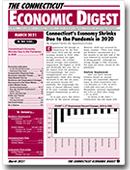 |
 |
March 2021 Connecticut Economic Digest |
 |
Connecticut's Economy Shrinks Due to the Pandemic in 2020
By Jungmin Charles Joo, Associate Research Analyst, Department of Labor
 mployment fell sharply in Connecticut for the first time since 2010 and the overall economy shrank in 2020. After having increased for eight straight years, the revised annual average total nonfarm employment fell slightly in 2019, and drastically last year, due to the impact from the pandemic. Correspondingly, last year's unemployment rate rose significantly, while after having increased in the last six years, real personal income fell markedly. Not surprisingly the value of annual diffusion index of 58 state economic indicators dropped dramatically as well in 2020. mployment fell sharply in Connecticut for the first time since 2010 and the overall economy shrank in 2020. After having increased for eight straight years, the revised annual average total nonfarm employment fell slightly in 2019, and drastically last year, due to the impact from the pandemic. Correspondingly, last year's unemployment rate rose significantly, while after having increased in the last six years, real personal income fell markedly. Not surprisingly the value of annual diffusion index of 58 state economic indicators dropped dramatically as well in 2020.
As in past years, this article focuses on the annual average. However, 2020 was unusual for many reasons. There were sharp job declines concentrated in a few months in the first half of the year followed by several months of strong growth - although not strong enough to fully overcome the large job losses caused by the pandemic. [ read more ]
|
 |
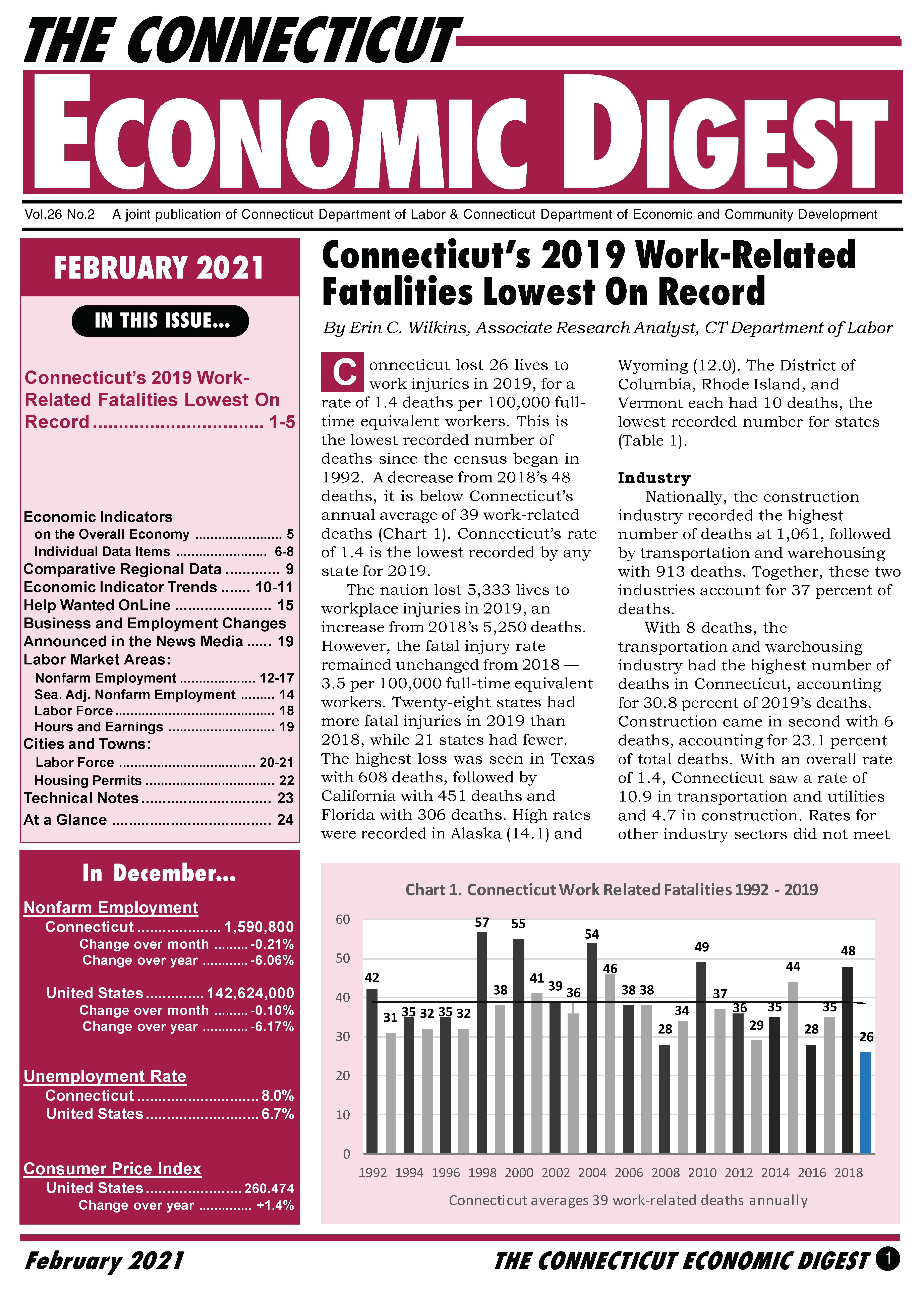 |
 |
February 2021 Connecticut Economic Digest |
 |
Connecticut's 2019 Work-Related Fatalities Lowest On Record
By Erin C. Wilkins, Associate Research Analyst, Department of Labor
 onnecticut lost 26 lives to work injuries in 2019, for a rate of 1.4 deaths per 100,000 full-time equivalent workers. This is the lowest recorded number of deaths since the census began in 1992. A decrease from 2018's 48 deaths, it is below Connecticut's annual average of 39 work-related deaths (Chart 1). Connecticut's rate of 1.4 is the lowest recorded by any state for 2019. onnecticut lost 26 lives to work injuries in 2019, for a rate of 1.4 deaths per 100,000 full-time equivalent workers. This is the lowest recorded number of deaths since the census began in 1992. A decrease from 2018's 48 deaths, it is below Connecticut's annual average of 39 work-related deaths (Chart 1). Connecticut's rate of 1.4 is the lowest recorded by any state for 2019.
The nation lost 5,333 lives to workplace injuries in 2019, an increase from 2018's 5,250 deaths. However, the fatal injury rate remained unchanged from 2018 - 3.5 per 100,000 full-time equivalent workers. Twenty-eight states had more fatal injuries in 2019 than 2018, while 21 states had fewer. The highest loss was seen in Texas with 608 deaths, followed by California with 451 deaths and Florida with 306 deaths. High rates were recorded in Alaska (14.1) and Wyoming (12.0). The District of Columbia, Rhode Island, and Vermont each had 10 deaths, the lowest recorded number for states.
Industry
Nationally, the construction industry recorded the highest number of deaths at 1,061, followed by transportation and warehousing with 913 deaths. Together, these two industries account for 37 percent of deaths.
With 8 deaths, the transportation and warehousing industry had the highest number of deaths in Connecticut, accounting for 30.8 percent of 2019's deaths. Construction came in second with 6 deaths, accounting for 23.1 percent of total deaths. With an overall rate of 1.4, Connecticut saw a rate of 10.9 in transportation and utilities and 4.7 in construction. Rates for other industry sectors did not meet publishing criteria. The government sector recorded 2 deaths. [ read more ] |
 |
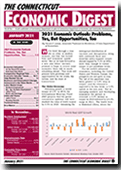 |
 |
January 2021 Connecticut Economic Digest |
 |
2021 Economic Outlook: Problems, Yes, But Opportunities, Too
By Steven P. Lanza, Associate Professor-in-Residence, UConn Department of Economics
 e've lived through a year like no other in modern memory, one that has turned lives and economies upside down. But as we look forward to a new year where vaccines promise to begin to restore some normalcy, there will be much rebuilding ahead. That work will present both problems and opportunities for the world, the nation, and the state of Connecticut. e've lived through a year like no other in modern memory, one that has turned lives and economies upside down. But as we look forward to a new year where vaccines promise to begin to restore some normalcy, there will be much rebuilding ahead. That work will present both problems and opportunities for the world, the nation, and the state of Connecticut.
Global and U.S. Overview
Following growth in world output of 2.4% in 2019, the International Monetary Fund (IMF) projects that the global coronavirus epidemic will have slashed the value of world output by 4.4% in 2020. Assuming the widespread distribution of vaccines and therapeutics, along with continued fiscal and monetary policy support, output should expand by 5.2% in 2021, more than enough to restore output to pre-pandemic levels.
For the world's advanced economies, including the United States and Western Europe, the prospects are not quite so rosy. The toll of the pandemic was likely greater - a 5.8% drop in output - and the rebound is expected to be less brisk - a 3.9% uptick in the new year. But in emerging markets and developing economies the picture is reversed: a 3.3% decline in output in 2020 followed by a 6.0% surge in 2021. The leader here is Mainland China, where the virus originated. A swift and severe lockdown allowed the country to check the spread of infection and to preserve a modicum of positive, 1.9%, growth for the year. China's economy is expected to swell by more than 8% in 2021. [ read more ] |
 |
 |
 |
 |
|
 |
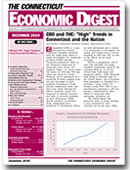 |
 |
December 2020 Connecticut Economic Digest |
 |
CBD and THC: "High" Trends in Connecticut and the Nation
By Caroline Czajkowski, Department of Labor
 annabidiol (CBD) is a non-psychoactive natural compound primarily extracted from the hemp plant which is being investigated for numerous potential health benefits. Tetrahydrocannabinol (THC) is the chemical component in marijuana that causes the euphoric "high." In recent years the debate on CBD and THC has taken the nation by storm. Products can be purchased in a multitude of forms ranging from oils and cartridges to bath products. Proponents of both natural compounds claim that they have many therapeutic effects. However, critics are skeptical as limited research and data is currently available on both substances. With divided opinions on whether these compounds have beneficial or detrimental effects on both individuals and a society, it is noteworthy to investigate our nation and Connecticut's current standing on CBD and THC as well as the effects on our local economy. annabidiol (CBD) is a non-psychoactive natural compound primarily extracted from the hemp plant which is being investigated for numerous potential health benefits. Tetrahydrocannabinol (THC) is the chemical component in marijuana that causes the euphoric "high." In recent years the debate on CBD and THC has taken the nation by storm. Products can be purchased in a multitude of forms ranging from oils and cartridges to bath products. Proponents of both natural compounds claim that they have many therapeutic effects. However, critics are skeptical as limited research and data is currently available on both substances. With divided opinions on whether these compounds have beneficial or detrimental effects on both individuals and a society, it is noteworthy to investigate our nation and Connecticut's current standing on CBD and THC as well as the effects on our local economy.
CBD is a cannabinoid, one of over 100 naturally occurring chemical compounds found in the cannabis plant. It can be derived from both hemp and marijuana plants. CBD extracted from hemp is federally legal in the United States, but if acquired from marijuana is classified as a schedule 1 drug. Unlike it's distant cousin THC, CBD is non-psychoactive, meaning it will not provide a hallucinatory effect which is associated with marijuana utilization. [ read more ]
|
 |
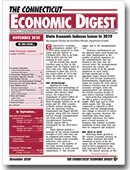
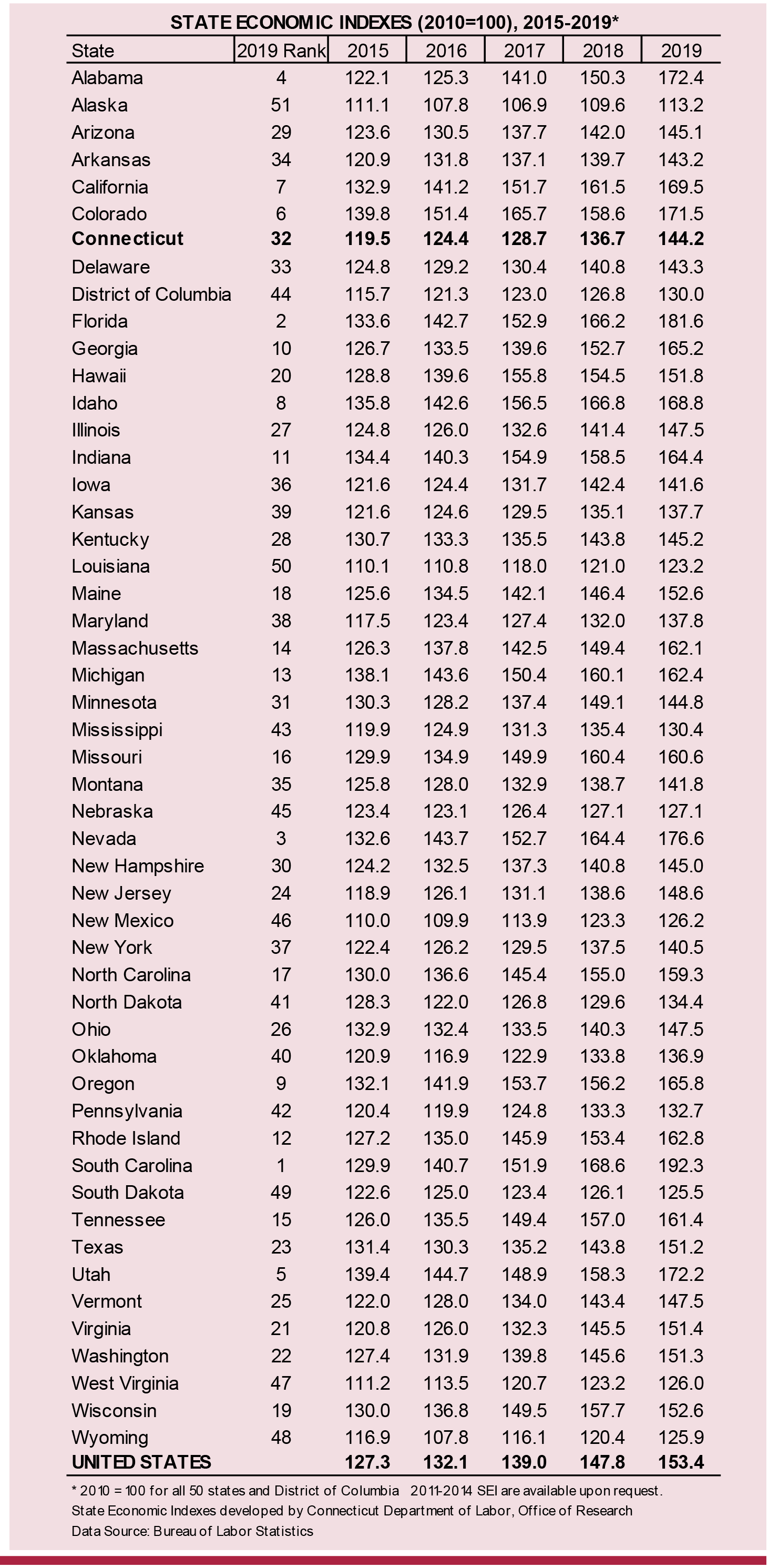 |
 |
November 2020 Connecticut Economic Digest |
 |
State Economic Indexes Lower in 2019
By Jungmin Charles Joo, Department of Labor and Dana Placzek, Research, Department of Labor
 onnecticut's economic performance ranked 32nd in 2019 when compared to other states and the District of Columbia (DC). This is up from 37th in 2018 and the best ranking in nine years. onnecticut's economic performance ranked 32nd in 2019 when compared to other states and the District of Columbia (DC). This is up from 37th in 2018 and the best ranking in nine years.
For the second time, South Carolina came in first in the nation with the highest index of 192.3 last year, while Alaska continued to place last (113.2). Our state's index of 144.2 was below the nationwide value of 153.4.
SEI: Methodology
Applying the same components and methodology of the Connecticut Town Economic Indexes (See October 2020 issue), the Connecticut Department of Labor's Office of Research also developed the State Economic Indexes for all 50 states and DC. With recently available annual average data from the Quarterly Census Employment and Wages (QCEW) program, along with the revised annual average unemployment rate from Local Area Unemployment Statistics (LAUS), annual SEI is reestimated for the 2010-2019 period.
These indexes provide a measure of the overall economic strength of each state that can be compared and ranked. Four annual average state economic indicators were used as components: 1. the number of the total covered business establishments, 2. total covered employment, 3. real covered wages, and 4. the unemployment rate. [ read more ]
Download SEI 2010-2019 data.xlsx |
 |
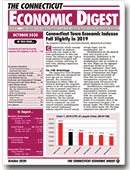
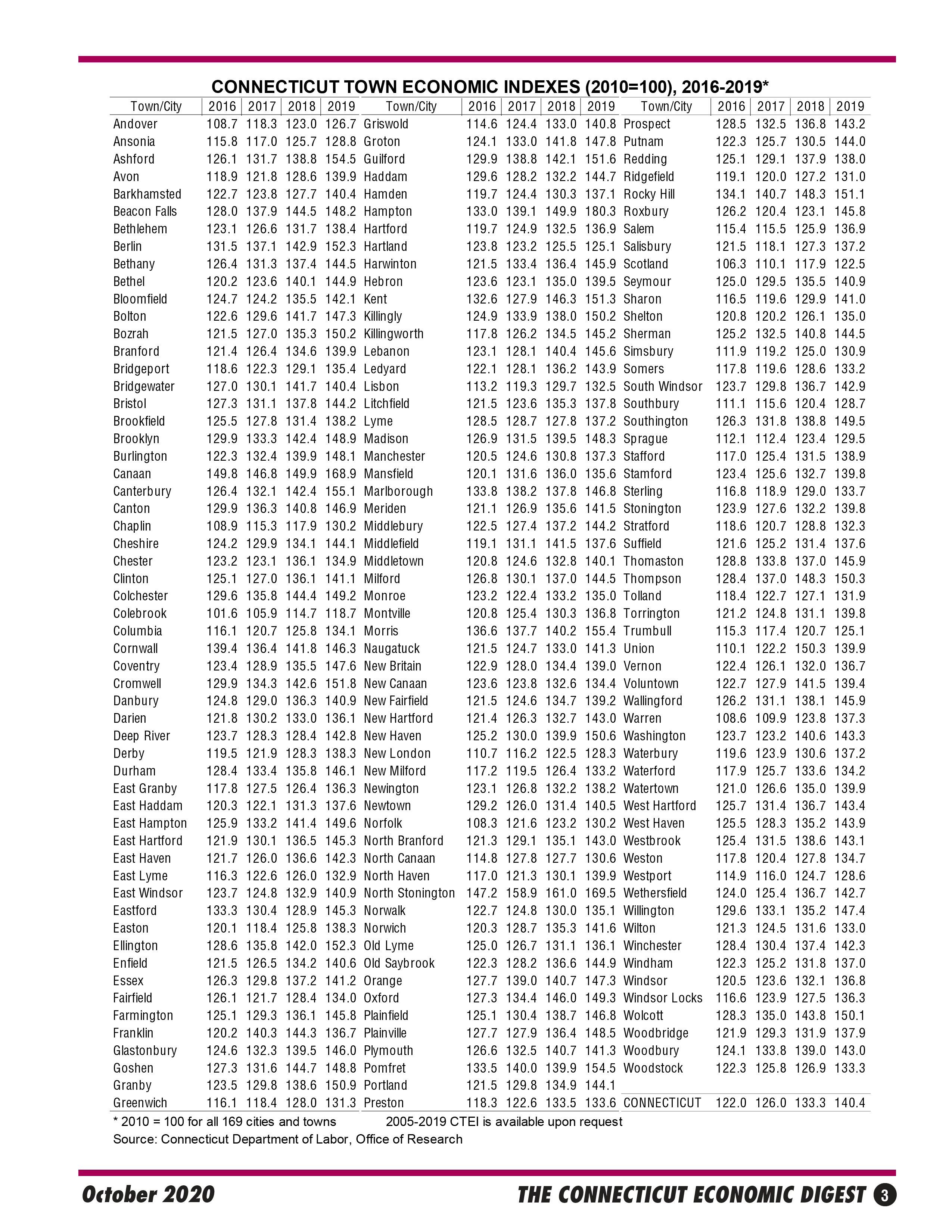 |
 |
October 2020 Connecticut Economic Digest |
 |
Connecticut Town Economic Indexes Fell Slightly in 2019
By Jungmin Charles Joo, Department of Labor and Dana Placzek, Research, Department of Labor
 onnecticut's overall economy continued its moderate growth last year, based on the index performances of cities and towns. The indexes on page 3 give a broad measure of business and resident economic well-being of each town, allowing comparisons among them. onnecticut's overall economy continued its moderate growth last year, based on the index performances of cities and towns. The indexes on page 3 give a broad measure of business and resident economic well-being of each town, allowing comparisons among them.
The CTEI Methodology
The Connecticut Town Economic Indexes (CTEI) were introduced five years ago and are released annually. The Connecticut Department of Labor's Office of Research developed the composite indexes of all 169 municipalities in the state to measure each town or city's overall economic health, which then can be ranked and compared to others to gain perspective. The four annual average town economic indicators used as components are total covered business establishments, total covered employment, inflation-adjusted covered annual average wages, and the unemployment rate.
Establishments are the physical work units located in the municipality. Employment is the number payroll employees in establishments that are located in the town. Wages are the aggregate payroll pay divided by the total average employment. These three measures come from the Quarterly Census of Employment and Wages (QCEW) program and include all those who are covered under unemployment insurance law, thus capturing nearly 100 percent of all payroll employees in each town. [ read more ]
Download CTEI 2005-2019 data.xlsx |
 |
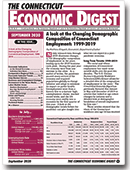 |
 |
September 2020 Connecticut Economic Digest |
 |
A look at the Changing Demographic Composition of Connecticut Employment: 1999-2019
By Matthew Krzyzek, Economist, Department of Labor
 ewly released data through 2019 illustrates changes in the demographic composition of employment in the years leading up to the 2019 business cycle peak. During the past year the economy went from one extreme to the other. In a matter of weeks, the pandemic paused many sectors of the economy and required populations globally to change behavior and adapt to minimize its impact on public health. Unemployment went from a historic low to a historic high, unemployment claims reached record levels, and the US economy went swiftly into a recession by the first quarter of this year. A look at the demographic trends before the pandemic can give insight into what we can expect in a post-pandemic economy. ewly released data through 2019 illustrates changes in the demographic composition of employment in the years leading up to the 2019 business cycle peak. During the past year the economy went from one extreme to the other. In a matter of weeks, the pandemic paused many sectors of the economy and required populations globally to change behavior and adapt to minimize its impact on public health. Unemployment went from a historic low to a historic high, unemployment claims reached record levels, and the US economy went swiftly into a recession by the first quarter of this year. A look at the demographic trends before the pandemic can give insight into what we can expect in a post-pandemic economy.
Long Term Trends: 1999-2019
The racial and ethnic composition of Connecticut employment has made some notable shifts over the past two decades. The U.S. Census Bureau's Quarterly Workforce Indicators (QWI) dataset allows for a detailed view of the composition of employment in the state. The Connecticut Economic Digest has previously featured this dataset in May and December of 2019 in articles that looked at age cohort changes by industry and a detailed look at demographic breakdown of overall employment by firm size.
Those articles showed that the share of the Connecticut workforce over age 54 has doubled over twenty years with pronounced increases in major sectors such as Manufacturing and Healthcare & Social Assistance. The December 2019 article illustrated how cyclical employment changes and the demographic composition of employment vary by firm size. [ read more ]
|
 |
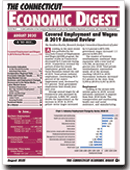 |
 |
August 2020 Connecticut Economic Digest |
 |
Covered Employment and Wages: A 2019 Annual Review
By Jonathan Kuchta, Research Analyst, Department of Labor
 ccording to the most recent data published by the Quarterly Census of Employment and Wages (QCEW) program, the number of jobs in Connecticut decreased by 0.2 percent during 2019. Connecticut reversed the pattern of slow but steady employment growth since the Great Recession toward the end of 2019. Total private industry employment, constituting 86.5 percent of the state's employment total, decreased by 0.2 percent. Total government employment held steady year-over-year. ccording to the most recent data published by the Quarterly Census of Employment and Wages (QCEW) program, the number of jobs in Connecticut decreased by 0.2 percent during 2019. Connecticut reversed the pattern of slow but steady employment growth since the Great Recession toward the end of 2019. Total private industry employment, constituting 86.5 percent of the state's employment total, decreased by 0.2 percent. Total government employment held steady year-over-year.
Average annual wages for all Connecticut jobs increased by 3.0 percent, to $69,787, nearly double the improvement on the increase in 2018. In 2019, private sector wages increased by 3.3 percent to $70,554; government wages increased 1.1 percent to $64,855.
The number of business establishments continued their expansion, with a new total of 123,766, an increase of 1.4 percent over 2018. Total private establishments represented nearly all of the increase, reaching 120,419 in 2019. Government worksites increased 0.2 percent in the state, from 3,340 in 2018 to 3,347 in 2019. [ read more ] |
 |
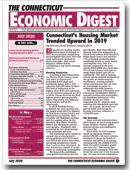 |
 |
July 2020 Connecticut Economic Digest |
 |
Connecticut's Housing Market Trended Upward in 2019
By Kolie Sun, Senior Research Analyst, Department of Economic and Community Development
 onnecticut's housing market showed signs of strength in 2019 as new permits reached their second highest level since 2007 and home sales prices reached an eleven-year high. This article examines several factors contributing to the state's housing rebound. onnecticut's housing market showed signs of strength in 2019 as new permits reached their second highest level since 2007 and home sales prices reached an eleven-year high. This article examines several factors contributing to the state's housing rebound.
Housing Production
According to data release from the Bureau of the Census, cities and towns in Connecticut authorized 5,854 single and multifamily homes with a total valuation of $1.354 billion in 2019. The level of production is the highest since 2015 and represents a 21.6% increase compared to 4,815 in 2018. Connecticut had the third highest percent gain among fifty states: New Jersey and Arkansas led with 30.6% and 25.0%, respectively.
In 2019, Fairfield County authorized the most permits with the largest share (39.7%), followed by New Haven County (24.8%) and Hartford County (13.5%). Both Litchfield and Middlesex counties had the smallest share (2.3%). Stamford, New Haven, Fairfield, Milford and Norwalk issued the most permits. Combined, they accounted for 42% of all housing units authorized last year. [ read more ]
What Commuter Rail Brings to Central Connecticut
By Al Sylvestre, Research Analyst, Department of Labor
 enerational change for commuters arrived on June 18, 2018 as the Hartford Line passenger railroad, also known as CT Rail, began daily service between New Haven and Springfield, MA. Official rollout of the service began after a preview weekend so popular that trains had to intermittently stop taking passengers. The $768 million project came to life through a partnership among the Connecticut and Massachusetts state transportation departments, Amtrak, and several federal agencies. This article offers a brief look at CT Rail's vision and origin, its ridership, and development plans in various stages of completion since CT Rail's inception two summers ago. [ read more ] enerational change for commuters arrived on June 18, 2018 as the Hartford Line passenger railroad, also known as CT Rail, began daily service between New Haven and Springfield, MA. Official rollout of the service began after a preview weekend so popular that trains had to intermittently stop taking passengers. The $768 million project came to life through a partnership among the Connecticut and Massachusetts state transportation departments, Amtrak, and several federal agencies. This article offers a brief look at CT Rail's vision and origin, its ridership, and development plans in various stages of completion since CT Rail's inception two summers ago. [ read more ]
|
 |
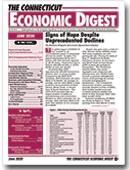 |
 |
June 2020 Connecticut Economic Digest |
 |
Signs of Hope Despite Unprecedented Declines
By Matthew Krzyzek, Economist, Department of Labor
 he global impact of COVID-19 has resulted in an unprecedented pause to economies all over the world. In April, U.S. payroll employment fell by 20.5 million jobs with declines reported in all 50 states. Connecticut lost a historic 266,300 net jobs, a -15.9% decline in just one month. he global impact of COVID-19 has resulted in an unprecedented pause to economies all over the world. In April, U.S. payroll employment fell by 20.5 million jobs with declines reported in all 50 states. Connecticut lost a historic 266,300 net jobs, a -15.9% decline in just one month.
As of early May 2020, approximately 300,000 Connecticut workers were receiving benefits. Compared to the 2009-2010 recession, 2020 claimants are more likely to be female, are younger on average, and are more likely to have worked in Accommodation & Food Service, Retail Trade, or Health Care & Social Assistance. The 2009-2010 recession saw the largest number of claims in manufacturing and construction. Workers in these industries are, on average, older and more likely to be male than workers in the economy as a whole. [ read more ]
2018 Unemployment Rate by Town
By Jungmin Charles Joo, Department of Labor and Dana Placzek, Research, Department of Labor
 n 2019, the annual average statewide unemployment rate was 3.7%, down from 4.1% in 2018. For the ninth year, most municipalities experienced a decline in their unemployment rate, although a little fewer than fell in 2018. n 2019, the annual average statewide unemployment rate was 3.7%, down from 4.1% in 2018. For the ninth year, most municipalities experienced a decline in their unemployment rate, although a little fewer than fell in 2018.
2018 to 2019
Of 169 cities and towns in the state, the unemployment rate fell in 162, rose in 5, while 2 were unchanged in 2019. On the other hand, 164 were down, 1 was up, and 4 remained the same in 2018. Roxbury had the lowest unemployment rate of 2.1%, while the residents of Hartford experienced the highest rate of 6.6% last year (see table on page 3 for the complete town data). Overall, a total of 124 cities and towns had jobless rates below the 2019 statewide figure of 3.7%, 35 had rates above it, and 10 had rates equal to it. By comparison, 128 cities and towns had rates below the 2018 statewide average of 4.1%, 35 above it, and 6 were the same.
Of the five largest cities in the state with a 2010 Census population of 100,000 or more, Stamford had the lowest unemployment rate of 3.3% in 2019. Hartford posted the highest jobless rate among the large cities at 6.6%. All five cities experienced over-the-year unemployment rate decreases. The map on page 4 also shows the unemployment rates for each town in 2019. [ read more ]
|
 |
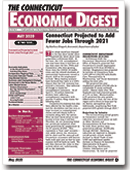 |
 |
May 2020 Connecticut Economic Digest |
 |
Connecticut Projected to Add Fewer Jobs Through 2021
By Matthew Krzyzek, Economist, Department of Labor
 he whole world has changed in the few short weeks since we completed the latest short term projections in February 2020. At the time, the U.S. unemployment rate was lower than it had been at any time since the late 1960s and Connecticut jobs were growing. Since then the COVID-19 health crisis and the related shutdown of nonessential businesses caused a drastic shift in the employment outlook. Many leading analysts1 have declared that there is a 100% chance that the U.S. economy has entered a recession. One indicator of change is claims for unemployment insurance. As of April 11, 16 million American workers were collecting unemployment insurance with another 4 million filing claims the following week. he whole world has changed in the few short weeks since we completed the latest short term projections in February 2020. At the time, the U.S. unemployment rate was lower than it had been at any time since the late 1960s and Connecticut jobs were growing. Since then the COVID-19 health crisis and the related shutdown of nonessential businesses caused a drastic shift in the employment outlook. Many leading analysts1 have declared that there is a 100% chance that the U.S. economy has entered a recession. One indicator of change is claims for unemployment insurance. As of April 11, 16 million American workers were collecting unemployment insurance with another 4 million filing claims the following week.
Connecticut's economy has also been affected by the health crisis and the shutdowns and has seen a large increase in unemployment claims and will clearly suffer a recession along with the nation. What we don't know (what no one knows) is how long it will last. Therefore, we are presenting below our previously-completed short term projections for employment in the 2nd quarter of 2021. This represents a "best case" scenario - that while severe, the recession will be short and the national and Connecticut economies will bounce back early next year so that by next summer we'll be back on track. We will then discuss the risks to this outlook which are, unfortunately, all on the downside.
Connecticut Employment Projections 2019-2021
In February 2020, the Connecticut Department of Labor's Office of Research projected that Connecticut's overall employment increase by 0.4% from 2019Q2 to 2021Q2. Employment was projected to increase in Connecticut from 1,815,649 to 1,822,595 with Health Care, Transportation & Warehousing, and Social Assistance adding the most jobs.
The projected two year employment growth of 6,950 jobs is comparable to many northeast states. Almost every other New England state had projected growth of 1.5% or less. Massachusetts' 2.3% projected two-year growth differentiates it from the rest of the region and is driven in large part by its Boston metropolitan area. Additionally, neighboring New York projected 2.0% growth through 2021. [ read more ]
|
 |
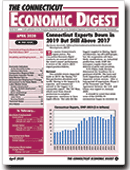 |
 |
April 2020 Connecticut Economic Digest |
 |
Connecticut Exports Down in 2019 But Still Above 2017
By Laura Jaworski, Office of International and Domestic Business Development, Department of Economic and Community Development
 o assess Connecticut's export status, The Connecticut Economic Digest conducts an annual review of the state's export performance. A review of the state's 2019 export position follows. o assess Connecticut's export status, The Connecticut Economic Digest conducts an annual review of the state's export performance. A review of the state's 2019 export position follows.
National
Two notable events impacted trade in 2019: the Boeing 737 Max production shutdown and tariffs. Boeing is the largest U.S. exporter, and commercial aircraft is the biggest U.S. commodity export. The 737 Max, which went from slowed production to complete suspension, continues to have ripple effects. Not only did the biggest supplier to Boeing, Spirit AeroSystems, lay off 2,800 people, but the suspension will have likely ramifications on industrial production, trade, GDP, the aerospace supply chain and delivery of parts and inventory.
U.S.-China trade friction dominated the headlines for a good part of 2019. The back and forth imposition of tariffs clearly impacted certain sectors. After a long period of negotiation, Phase I of the Economic and Trade Agreement between the U.S. and China was signed in January 2020.
It should be noted that while news of the COVID-19 coronavirus began to circulate in late 2019, its impact is expected to be reflected in 2020 data. [ read more ]
Disability and Employment
By Al Sylvestre, Research Analyst, Department of Labor
 s the private-sector labor market has recovered more jobs than it lost in the 2008-2010 recession, people with disabilities, who comprise five percent of the state workforce, continue integrating with the labor market. This article takes a brief look at the economic geography of people with disabilities showing where they live, the economic sectors in which they work, and how their earnings compare with those of their non-disabled peers. Programs and services that provide opportunities for people with disabilities to attach to the labor force and retain employment are briefly discussed as well. s the private-sector labor market has recovered more jobs than it lost in the 2008-2010 recession, people with disabilities, who comprise five percent of the state workforce, continue integrating with the labor market. This article takes a brief look at the economic geography of people with disabilities showing where they live, the economic sectors in which they work, and how their earnings compare with those of their non-disabled peers. Programs and services that provide opportunities for people with disabilities to attach to the labor force and retain employment are briefly discussed as well.
Population and Geography
The US Census Bureau's American Community Survey (ACS) 2017 five-year average statistics show that 3.43% of working people with disabilities have one or more disabilities. This includes 0.71% of the employed work force with a vision impairment or legal blindness. About 86% of people with disabilities have a physical impairment including hearing loss or an ambulatory disability. People with one or more disabilities have self-care difficulties (6.5% of disabled workers), independent living difficulty (16.7%), or cognitive difficulty (33.1%). [ read more ]
|
 |
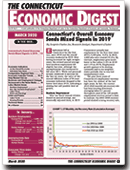 |
 |
March 2020 Connecticut Economic Digest |
 |
Connecticut's Overall Economy Sends Mixed Signals in 2019
By Jungmin Charles Joo, Associate Research Analyst, Department of Labor
 mployment fell in Connecticut for the first time since 2010 and the overall economy weakened in 2019. After having increased for eight straight years, the revised annual average total nonfarm employment fell slightly last year, although the unemployment rate continued to fall since 2011. While real personal income continued to increase for the last six years, the value of the annual diffusion index of 58 state economic indicators dropped to the lowest level since 2010, indicating a slowing but still positive level of growth. mployment fell in Connecticut for the first time since 2010 and the overall economy weakened in 2019. After having increased for eight straight years, the revised annual average total nonfarm employment fell slightly last year, although the unemployment rate continued to fall since 2011. While real personal income continued to increase for the last six years, the value of the annual diffusion index of 58 state economic indicators dropped to the lowest level since 2010, indicating a slowing but still positive level of growth.
Nonfarm Employment
After our latest annual revision (based on annual average, not seasonally adjusted data), in 2019 Connecticut actually lost employment for the first time since 2010 (-3,300 jobs, -0.2%). In 2018, 2,600 jobs were created (+0.2%). By contrast, employment grew much faster in the nation (1.6% in 2018 and 1.4% in 2019). Employment growth appears to be slowing nationally and in our neighbor states partially due to very low unemployment rates.
The past three years of Connecticut's employment recovery has been the slowest of the last eight years. In fact, the current 2010-2020 monthly job recovery rate has been trending downward, averaging below 0.1 percent throughout most of the 120-month employment recovery period to date. In contrast, the 2003-2008 recovery period showed a rising recovery rate, and during the 1993-2000 period, the monthly job growth rate rose steadily, increasing above the 0.1 percent threshold in later years of its employment recovery. Slowing growth rates should be expected this long into a recovery. [ read more ]
|
 |
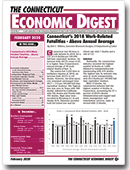 |
 |
February 2020 Connecticut Economic Digest |
 |
Connecticut's 2018 Work-Related Fatalities - Above Annual Average
By Erin C. Wilkins, Associate Research Analyst, Department of Labor
 onnecticut lost 48 lives to work injuries in 2018, for a rate of 2.8 deaths per 100,000 full-time equivalent workers. An increase from 2017's count of 35, it is higher than Connecticut's annual average of 39 work-related deaths. onnecticut lost 48 lives to work injuries in 2018, for a rate of 2.8 deaths per 100,000 full-time equivalent workers. An increase from 2017's count of 35, it is higher than Connecticut's annual average of 39 work-related deaths.
The nation lost 5,250 lives to workplace injuries in 2018, an increase from 2017's 5,147 deaths. However, the fatal injury rate remained unchanged from 2017 - 3.5 per 100,000 full-time equivalent workers. The highest loss was seen in Texas with 488 deaths, followed by California with 422 deaths and Florida with 332 deaths. High rates were recorded in Wyoming (11.5) and Alaska (9.9). Delaware recorded both the lowest loss and the lowest rate with 7 deaths and a rate of 1.6.
Industry
Nationally, the construction industry recorded the highest number of deaths at 1,008, followed by transportation and warehousing with 874 deaths. The highest rate by industry was seen in truck transportation, with 28.3 deaths per 100,000 full time equivalent workers.
With 13 deaths, the construction industry had the highest number of deaths in Connecticut, accounting for 27.1 percent of 2018's deaths. Administration and support and waste management and remediation services came in second with 12 deaths, accounting for 25.0 percent of total deaths. With an overall rate of 2.8, Connecticut saw a rate of 10.9 in construction, 10.2 in transportation and utilities, and 5.4 in professional and business services. Rates for other industry sectors did not meet publishing criteria. The government sector recorded 2 deaths. [ read more ]
|
 |
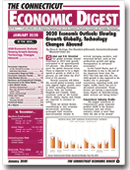 |
 |
January 2020 Connecticut Economic Digest |
 |
2020 Economic Outlook: Steady Growth Globally, Slower Growth Yet Positive Potential for Connecticut
By Alissa K. DeJonge, Vice President of Research, Connecticut Economic Resource Center, Inc.
 lobal and U.S. Overview lobal and U.S. Overview
The global economy slowed somewhat in 2019 with growth anticipated to be approximately 3.0 percent - the slowest pace since the global financial crisis. There is expected to be a slight uptick in growth in 2020 to 3.4 percent, yet still below the 2017 level of 3.6 percent.
Several countries will follow the overall global economic trend with slightly higher growth rates in 2020, including Germany, France, Italy, the United Kingdom and Canada. Other countries, such as the United States, Spain, Japan, and China, are expected to continue to soften.
There are several factors contributing to this economic deceleration, including prolonged trade tensions; macroeconomic strains in several emerging markets; and structural factors, such as low productivity growth and aging demographics in advanced economies.
In the United States, part of the slowdown is due to the end of the temporary boost from the 2017 Tax Cuts and Jobs Act, but 2020 growth is also expected to be weaker due to prolonged uncertainty regarding trade and higher tariffs, which has led to decreased investment. These factors are having a particularly heavy impact on manufacturing, while services are faring better. [ read more ] |
 |
 |
 |
 |
|
 |
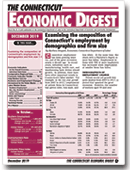 |
 |
December 2019 Connecticut Economic Digest |
 |
Examining the composition of Connecticut's employment by demographics and firm size
By Matthew Krzyzek, Economist, Department of Labor
 onnecticut employment has been growing since the end of the great recession nearly a decade ago. In recent years, industries such as manufacturing, health care, and warehousing have driven overall growth. In addition, there have been other important trends in Connecticut's labor market. For example, in the ten year period from 2007 to 2017, employment at private firms in Connecticut has gotten older, less male, and less white. At the same time, the share with a Bachelor's degree or more has fallen. Employment in firms with 500 or more employees has increased while employment at smaller firms has fallen. onnecticut employment has been growing since the end of the great recession nearly a decade ago. In recent years, industries such as manufacturing, health care, and warehousing have driven overall growth. In addition, there have been other important trends in Connecticut's labor market. For example, in the ten year period from 2007 to 2017, employment at private firms in Connecticut has gotten older, less male, and less white. At the same time, the share with a Bachelor's degree or more has fallen. Employment in firms with 500 or more employees has increased while employment at smaller firms has fallen.
DEMOGRAPHICS OF EMPLOYMENT CHANGE
Private sector job growth was quite modest from 2007 to 2017, a period that spanned the great recession. However, the number of workers aged 55 and over increased 37% in that ten year period. The portion aged 55 and over increased from less than 20% to more than 25% of all workers. The number of workers aged 25 to 54 declined as the last of the baby boom aged into the 55 and over group while the number under age 25 declined due to lower birthrates in recent decades and a drop in labor force participation for those aged 16 to 18.
Looking at other demographic factors, in each of the past two decades, the number of males employed has decreased slightly while the number of females increased a bit. By 2017 the number of females employed slightly outnumbered the number of males employed in private sector payroll jobs. At the same time, the number of white and not Hispanic or Latino workers has declined while all other groups have seen increases with Black or African-American employment up 18% and employment of Hispanic or Latino workers up 28% in the ten years from 2007 to 2017. [ read more ]
|
 |
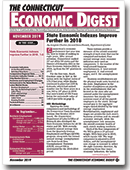
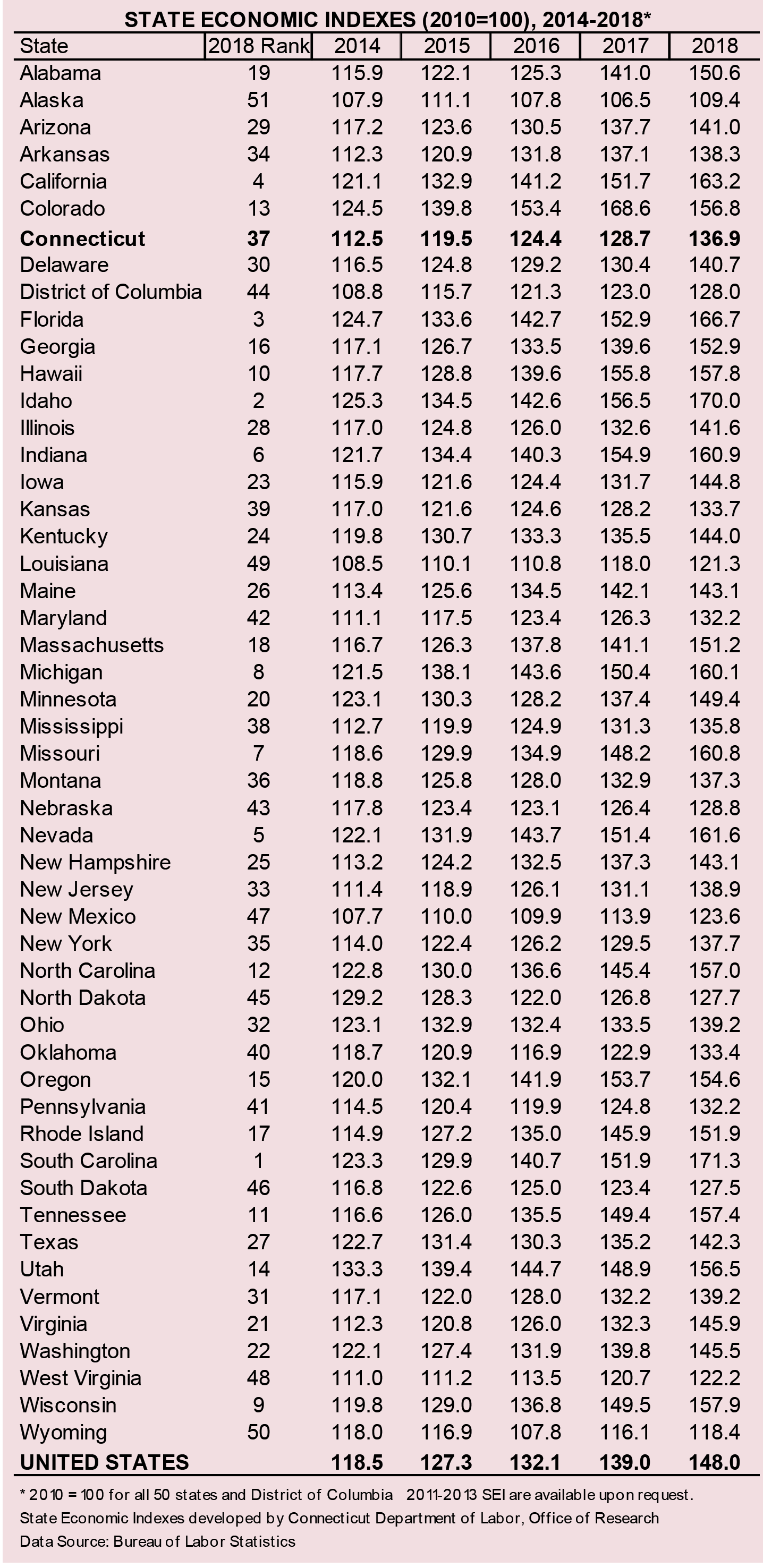 |
 |
November 2019 Connecticut Economic Digest |
 |
State Economic Indexes Improve Further in 2018
By Jungmin Charles Joo, Department of Labor and Dana Placzek, Research, Department of Labor
 onnecticut's economic performance last year was the best in terms of ranking in eight years. After annual revisions, Connecticut ranked 37th out of the 50 states and the District of Columbia (DC) in the State Economic Indexes (SEI) in 2018, up from the 38th position in 2017. onnecticut's economic performance last year was the best in terms of ranking in eight years. After annual revisions, Connecticut ranked 37th out of the 50 states and the District of Columbia (DC) in the State Economic Indexes (SEI) in 2018, up from the 38th position in 2017.
For the first time, South Carolina came in first in the nation with the highest index of 171.3 last year, while Alaska continued to place last (109.4). Colorado, which had ranked number one for three years in a row, fell to 13th place in 2018. Our state's index of 136.9 was below the nationwide value of 148.0.
SEI: Methodology
Applying the same components and methodology of the Connecticut Town Economic Indexes (See October 2019 issue), the Connecticut Department of Labor's Office of Research also developed the State Economic Indexes for all 50 states and DC. With recently available annual average data from the Quarterly Census Employment and Wages (QCEW) program, along with the revised annual average unemployment rate from Local Area Unemployment Statistics (LAUS), annual SEI is reestimated for the 2010-2018 period.
These indexes provide a measure of the overall economic strength of each state that can be compared and ranked. Four annual average state economic indicators were used as components: 1. the number of the total covered business establishments, 2. total covered employment, 3. real covered wages, and 4. the unemployment rate. [ read more ]
Download SEI 2010-2018 data.xlsx |
 |
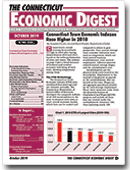
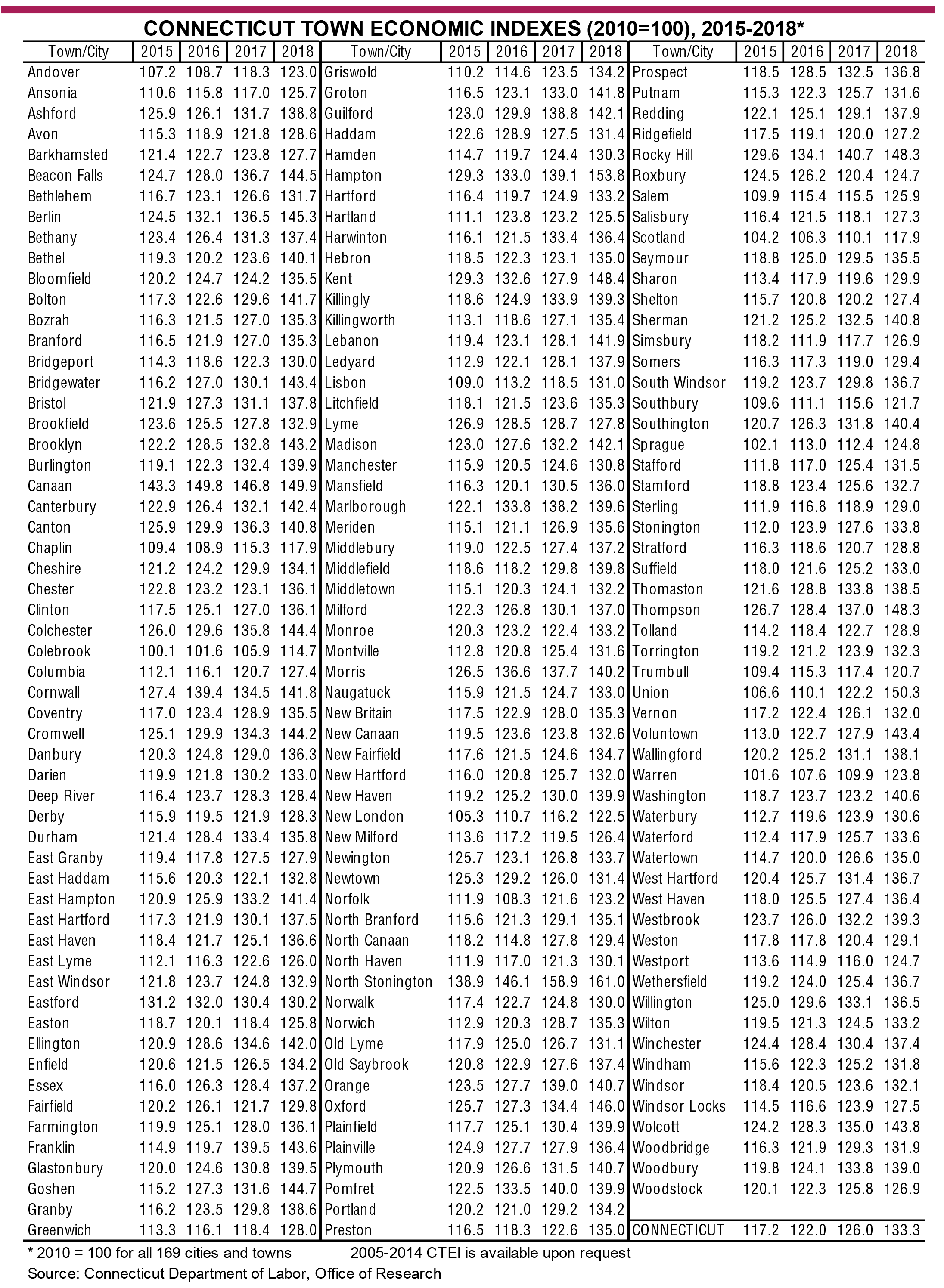 |
 |
October 2019 Connecticut Economic Digest |
 |
Connecticut Town Economic Indexes Rose Higher in 2018
By Jungmin Charles Joo, Department of Labor and Dana Placzek, Research, Department of Labor
 onnecticut's overall economy bounced back strongly in 2018 after having slowed down in 2016 and 2017, based on the index performances of cities and towns. The indexes on page 3 give a broad measure of business and resident economic well-being of each town, allowing comparisons among them. onnecticut's overall economy bounced back strongly in 2018 after having slowed down in 2016 and 2017, based on the index performances of cities and towns. The indexes on page 3 give a broad measure of business and resident economic well-being of each town, allowing comparisons among them.
The CTEI Methodology
The Connecticut Town Economic Indexes (CTEI) were introduced four years ago and are released annually. The Connecticut Department of Labor's Office of Research developed the composite indexes of all 169 municipalities in the state to measure each town or city's overall economic health, which then can be ranked and compared to others to gain perspective. Four annual average town economic indicators were used as components, which are total covered business establishments, total covered employment, inflation-adjusted covered annual average wages, and the unemployment rate.
Establishments are the physical work units located in the municipality. Employment is the number of employees on payroll in the establishments that are located in the town. Wages are the aggregate payroll pay divided by the total average employment. These three measures come from the Quarterly Census of Employment and Wages (QCEW) program and include all those who are covered under the unemployment insurance law, thus capturing nearly 100 percent of all the employees in each town. [ read more ]
Download CTEI 2005-2018 data.xlsx |
 |
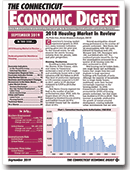 |
 |
September 2019 Connecticut Economic Digest |
 |
2018 Housing Market in Review
By Kolie Sun, Senior Research Analyst, Department of Economic and Community Development
 onnecticut's housing market experienced growth in 2018 with many economic indicators posting gains over the prior year. In this annual review, we will examine the state's housing industry from the permits, sales and price perspectives. onnecticut's housing market experienced growth in 2018 with many economic indicators posting gains over the prior year. In this annual review, we will examine the state's housing industry from the permits, sales and price perspectives.
Housing Production
According to data released by the Bureau of the Census, cities and towns in Connecticut authorized a total of 4,815 single and multifamily homes with a total valuation of $1.112 billion in 2018. This level of production represents a 5.9% increase compared to 4,547 in 2017, and a 12.5% decrease compared to 5,504 in 2016.
New Haven County regained the lead in the number of permit authorizations since 2010, with the largest share (24.2%) in 2018, followed by Hartford County (23.6%) and Fairfield County (22.8%). Litchfield County had the smallest share (2.6%). [ read more ]
Redevelopment for Workforce Housing
By Al Sylvestre, Research Analyst, Department of Labor
 he vision of Connecticut as a prosperous, inviting, and invigorating place to live, work, and play is brought to life by plans, places, and the networks that connect them. The most recent annual gathering of southern New England's land use planners, economic development professionals, and scholars featured ideas, plans, and projects of great place making. Place making is fundamental to bringing growth and prosperity that business, government, and education leaders speak about when they talk of making Connecticut competitive with its neighbors. [ read more ] he vision of Connecticut as a prosperous, inviting, and invigorating place to live, work, and play is brought to life by plans, places, and the networks that connect them. The most recent annual gathering of southern New England's land use planners, economic development professionals, and scholars featured ideas, plans, and projects of great place making. Place making is fundamental to bringing growth and prosperity that business, government, and education leaders speak about when they talk of making Connecticut competitive with its neighbors. [ read more ]
|
 |
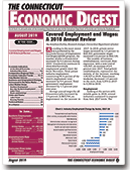 |
 |
August 2019 Connecticut Economic Digest |
 |
Covered Employment and Wages: A 2018 Annual Review
By Jonathan Kuchta, Research Analyst, Department of Labor
 ccording to the most recent data published by the Quarterly Census of Employment and Wages (QCEW) program, the number of jobs in Connecticut increased by 0.2 percent during 2018. Connecticut continues to show slow but steady employment growth since the Great Recession. Total private industry employment, constituting 86.4 percent of the state's employment total, increased by 0.4 percent. Total government employment decreased by 1.1 percent year-over-year. ccording to the most recent data published by the Quarterly Census of Employment and Wages (QCEW) program, the number of jobs in Connecticut increased by 0.2 percent during 2018. Connecticut continues to show slow but steady employment growth since the Great Recession. Total private industry employment, constituting 86.4 percent of the state's employment total, increased by 0.4 percent. Total government employment decreased by 1.1 percent year-over-year.
Average annual wages for all Connecticut jobs increased by 1.6 percent, to $67,744, an improvement on the increase in 2017. In 2018, private sector wages increased by 1.5 percent to $68,305; government wages increased 2.4 percent to $64,126.
The number of business establishments continued their expansion, with a new total of 122,067, an increase of 2.0 percent over 2017. Total private establishments represented the entirety of the increase, reaching 118,727 in 2018. Government worksites decreased 1.0 percent in the state, from 3,374 in 2017 to 3,340 in 2018. [ read more ] |
 |
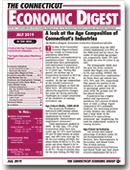 |
 |
July 2019 Connecticut Economic Digest |
 |
A Look at the Age Composition of Connecticut's Industries
By Matthew Krzyzek, Economist, Department of Labor
 he May 2019 Connecticut Economic Digest outlined top-line trends in Connecticut population, labor force participation, and employment to population ratios. As noted, overall labor force participation and employment to population ratios are up since the lows of 8 to 10 years ago. During this period, the median age in Connecticut increased to 40.9 by 2017, the 6th highest in the country. As the age composition of the overall Connecticut population changes, so Does the labor force. All industries are affected by population changes but some are facing particular challenges as a larger proportion of the workforce is nearing retirement age. [ download article only ] he May 2019 Connecticut Economic Digest outlined top-line trends in Connecticut population, labor force participation, and employment to population ratios. As noted, overall labor force participation and employment to population ratios are up since the lows of 8 to 10 years ago. During this period, the median age in Connecticut increased to 40.9 by 2017, the 6th highest in the country. As the age composition of the overall Connecticut population changes, so Does the labor force. All industries are affected by population changes but some are facing particular challenges as a larger proportion of the workforce is nearing retirement age. [ download article only ]
The Higher Education / Workforce Report
By Patrick.Flaherty, Assistant Director of Research, Department of Labor
 ost graduates of Connecticut's public colleges and universities work in Connecticut. Graduates from the wide range of programs are working in nearly every industry in our state. Shortly after leaving college, many graduates are employed in retail and food service. However, as time passes they are more likely to move to other industries such as manufacturing and health care. Average wages rise significantly in the years following graduation. [ download article only ] ost graduates of Connecticut's public colleges and universities work in Connecticut. Graduates from the wide range of programs are working in nearly every industry in our state. Shortly after leaving college, many graduates are employed in retail and food service. However, as time passes they are more likely to move to other industries such as manufacturing and health care. Average wages rise significantly in the years following graduation. [ download article only ]
|
 |
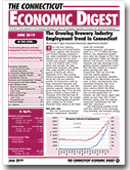 |
 |
June 2019 Connecticut Economic Digest |
 |
The Growing Brewery Industry Employment Trend in Connecticut
By Lincoln S. Dyer, Associate Economist, Department of Labor
 he craft beer industry, consisting of microbreweries, brewpubs, regional craft breweries, and contract brewing companies, has really established its calling in America over the last ten years. Overall total brewery employment in the U.S. (NAICS* code 31212), which also includes the large brand-name breweries, has grown from under 25,000 in the first quarter of 2010 to 81,180 in September 2019. This exciting brewery job growth is clearly being led by the craft beer industry portion. In Connecticut, with no large commercial breweries and mainly consisting of the craft beer industry segment, employment has grown from less than 15 in the first quarter of 2010 to close to 800 in December 2019 (780 jobs from 63 establishments). Notice the hockey stick or boomerang-like job growth since coming out the Great Financial Crisis shown in the chart. [ download article only ] he craft beer industry, consisting of microbreweries, brewpubs, regional craft breweries, and contract brewing companies, has really established its calling in America over the last ten years. Overall total brewery employment in the U.S. (NAICS* code 31212), which also includes the large brand-name breweries, has grown from under 25,000 in the first quarter of 2010 to 81,180 in September 2019. This exciting brewery job growth is clearly being led by the craft beer industry portion. In Connecticut, with no large commercial breweries and mainly consisting of the craft beer industry segment, employment has grown from less than 15 in the first quarter of 2010 to close to 800 in December 2019 (780 jobs from 63 establishments). Notice the hockey stick or boomerang-like job growth since coming out the Great Financial Crisis shown in the chart. [ download article only ]
2018 Unemployment Rate by Town
By Jungmin Charles Joo, Department of Labor and Dana Placzek, Research, Department of Labor
 n 2018, the annual average statewide unemployment rate was 4.1%, down from 4.7% in 2017. For the eighth year, most municipalities experienced a decline in their unemployment rate, even more than fell in 2017. n 2018, the annual average statewide unemployment rate was 4.1%, down from 4.7% in 2017. For the eighth year, most municipalities experienced a decline in their unemployment rate, even more than fell in 2017.
2017 to 2018
Of 169 cities and towns in the state, the unemployment rate fell in 165, rose in 1, while 3 were unchanged in 2018. On the other hand, 152 were down, 11 were up, and 6 remained the same in 2017. Washington had the lowest unemployment rate of 2.4%, while the residents of Hartford experienced the highest rate of 7.0% last year (see table on page 3 for the complete town data). Overall, a total of 130 cities and towns had jobless rates below the 2018 statewide figure of 4.1%, 33 had rates above it, and six had rates equal to it. By comparison, 122 cities and towns had rates below the 2017 statewide average of 4.7%, 37 above it, and 10 were the same. [ download article only ]
|
 |
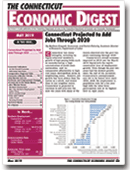 |
 |
May 2019 Connecticut Economic Digest |
 |
Connecticut Projected to Add Jobs Through 2020
By Matthew Krzyzek, Economist, Department of Labor and Patrick.Flaherty, Assistant Director of Research, Department of Labor
 onnecticut has many strengths, including its highly-educated workforce, growth of high-paying fields such as manufacturing, a high concentration of world-class universities, and its comparative affordability to highcost major metropolitan areas in neighboring states. However, job growth has been slower than the nation as a whole, and slower than in our neighbor states. onnecticut has many strengths, including its highly-educated workforce, growth of high-paying fields such as manufacturing, a high concentration of world-class universities, and its comparative affordability to highcost major metropolitan areas in neighboring states. However, job growth has been slower than the nation as a whole, and slower than in our neighbor states.
Connecticut is projected to continue to add jobs over the next two years with many of the trends observed over the past two years continuing through 2020. Connecticut's overall economy improved in 2018 (see the March 2019 Digest) with the eighth consecutive year of employment growth. Even though the past two years had the slowest growth since the end of the recession, Connecticut's unemployment rate fell to its lowest level since 2002, while the employment to population ratio hit a ten year high with the labor force participation rate at its highest level in eight years.
The unemployment rate is low despite slow job growth because our working-age population has also increased at a slower pace - up 5.2% over ten years compared to a 9.9% increase nationally. To put it simply, our slower population growth is resulting in slower employment growth. [ download article only ]
|
 |
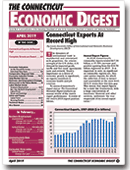 |
 |
April 2019 Connecticut Economic Digest |
 |
Connecticut Exports At Record High
By Laura Jaworski, Office of International and Domestic Business Development, Department of Economic and Community Development
 he dynamics of international trade is multifaceted and intertwined with geopolitics, the relative strength of the U.S. dollar, U.S. demand for imported goods, tariffs and free trade agreements (new and revised). Trade's importance as a driver of economic growth is significant, as exports contribute to economic health and job creation. he dynamics of international trade is multifaceted and intertwined with geopolitics, the relative strength of the U.S. dollar, U.S. demand for imported goods, tariffs and free trade agreements (new and revised). Trade's importance as a driver of economic growth is significant, as exports contribute to economic health and job creation.
To assess Connecticut's export status, The Connecticut Economic Digest conducts an annual review of the state's export performance. A review of the state's 2018 export position follows. [ download article only ]
Complete Streets are Sweet
By Al Sylvestre, Research Analyst, Department of Labor
 ecause every trip begins and ends on foot, universal access to work, education, and recreation is the guiding principle that gave rise to complete streets, the design and operation of streets that are safe for all users inclusive of people with disabilities and public transit users as well as motorized and non-motorized vehicle operators. Since 2009, the Department of Transportation (ConnDOT), guided by its Bicycle and Pedestrian Advisory Board (Bike and Ped Board), is bringing safer commuting to Connecticut's cities and towns. This article illustrates some benefits attributable to complete streets along with a brief description of how ConnDOT supports municipal efforts to bring complete streets to their residents. [ download article only ] ecause every trip begins and ends on foot, universal access to work, education, and recreation is the guiding principle that gave rise to complete streets, the design and operation of streets that are safe for all users inclusive of people with disabilities and public transit users as well as motorized and non-motorized vehicle operators. Since 2009, the Department of Transportation (ConnDOT), guided by its Bicycle and Pedestrian Advisory Board (Bike and Ped Board), is bringing safer commuting to Connecticut's cities and towns. This article illustrates some benefits attributable to complete streets along with a brief description of how ConnDOT supports municipal efforts to bring complete streets to their residents. [ download article only ]
|
 |
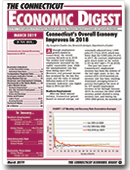 |
 |
March 2019 Connecticut Economic Digest |
 |
Connecticut's Overall Economy Improves in 2018
By Jungmin Charles Joo, Associate Research Analyst, Department of Labor
 lthough employment growth slowed in Connecticut, the overall economy did pick up in 2018. The revised total nonfarm employment increased for the eighth consecutive year, while the unemployment rate has been falling since 2011. Moreover, real personal income has increased for the last five years, and the value of annual diffusion index of 57 state economic indicators rose higher than in 2016 and 2017. lthough employment growth slowed in Connecticut, the overall economy did pick up in 2018. The revised total nonfarm employment increased for the eighth consecutive year, while the unemployment rate has been falling since 2011. Moreover, real personal income has increased for the last five years, and the value of annual diffusion index of 57 state economic indicators rose higher than in 2016 and 2017.
Nonfarm Employment
After our latest annual revision, Connecticut gained (based on annual average, not seasonally adjusted data) 1,600 jobs (+0.1%) in 2018, which was fewer than the 3,500 jobs (+0.2%) in 2017. By contrast, employment grew much faster in the nation (1.6% in 2017 and 1.7% in 2018).
The past two years of Connecticut's employment recovery has been the slowest of the last eight years. In fact, the current 2010-2019 monthly job recovery rate has been trending downward, averaging below 0.1 percent throughout the most of its 107-month employment recovery so far through January 2019. In contrast, the 2003-2008 recovery period showed a rising recovery rate, and during the 1993-2000 period, the monthly job growth rate rose steadily, increasing above the 0.1 percent threshold in later years of its employment recovery. [ download article only ]
|
 |
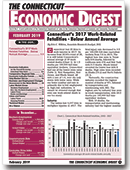 |
 |
February 2019 Connecticut Economic Digest |
 |
Connecticut's 2017 Work-Related Fatalities - Below Annual Average
By Erin C. Wilkins, Associate Research Analyst, Department of Labor
 onnecticut lost 35 lives to work injuries in 2017. An increase from 2016's count of 28, it is still below Connecticut's annual average of 39 work-related deaths. At 1.9 deaths per 100,000 full-time equivalent workers, Connecticut had one of the lowest state rates. New Hampshire, New Jersey, and Rhode Island, all with a rate of 1.6, were the only states with lower rates. While our lower number and rate is primarily due to low employment in high-risk industries, it cannot be stressed enough that even one work-related death is one too many. onnecticut lost 35 lives to work injuries in 2017. An increase from 2016's count of 28, it is still below Connecticut's annual average of 39 work-related deaths. At 1.9 deaths per 100,000 full-time equivalent workers, Connecticut had one of the lowest state rates. New Hampshire, New Jersey, and Rhode Island, all with a rate of 1.6, were the only states with lower rates. While our lower number and rate is primarily due to low employment in high-risk industries, it cannot be stressed enough that even one work-related death is one too many.
Industry
The nation lost 5,147 lives to workplace injuries in 2017. The fatal injury rate decreased to 3.5 per 100,000 full-time equivalent workers from 3.6 in 2016. The highest loss was seen in Texas with 534 deaths, followed by California with 376 and New York with 313 deaths. Rhode Island recorded the lowest loss with 8 deaths. High rates were recorded in Alaska (10.2) and North Dakota (10.1).
Nationally, the construction industry recorded the highest number of deaths at 971, followed by transportation and warehousing with 882. The highest rate by industry was seen in truck transportation, with 28.0 deaths per 100,000 full time equivalent workers. [ download article only ]
|
 |
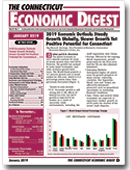 |
 |
January 2019 Connecticut Economic Digest |
 |
2019 Economic Outlook: Steady Growth Globally, Slower Growth Yet Positive Potential for Connecticut
By Alissa K. DeJonge, Vice President of Research, Connecticut Economic Resource Center, Inc.
 lobal and U.S. Overview lobal and U.S. Overview
The global economy in 2019 should continue its track of steady growth since mid-2016. However, the growth has peaked in some major economies, and risks of slower growth have risen. The World Bank projects a 3.7 percent growth rate in world output for this year, which is 0.2 percentage points lower than previously forecasted.
Trends to note include:
- U.S.: Economic growth is still strong due to the effects of federal tax cuts, but 2019 growth is expected to be weaker as a result of uncertain trade environments, including the tariff negotiation with China.
- Europe: Affected by the ongoing Brexit negotiations, growth projections for the Euro area and the UK are also adjusted downward.
- Emerging Markets: Anticipated higher oil prices raise the growth prospects of many energy- exporting countries, but Argentina, Brazil, Iran and Turkey are affected by downward pressures such as geopolitical uncertainty or worsening financial conditions.
- Asia: China and several Asian economies are expected to experience weaker growth in 2019 under the shadow of the recent trade disputes.
Across the world, the stagnant growth in working-age population and labor productivity foreshadows a more limited potential for long-term global economic growth. Coupled with fading monetary stimulation, the growth in most advanced economies is likely to decline to a rate slower than the average level before the global financial crisis in 2008.[ download article only ]
|
 |
 |
 |
 |
|
 |
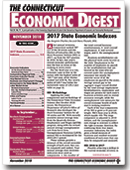
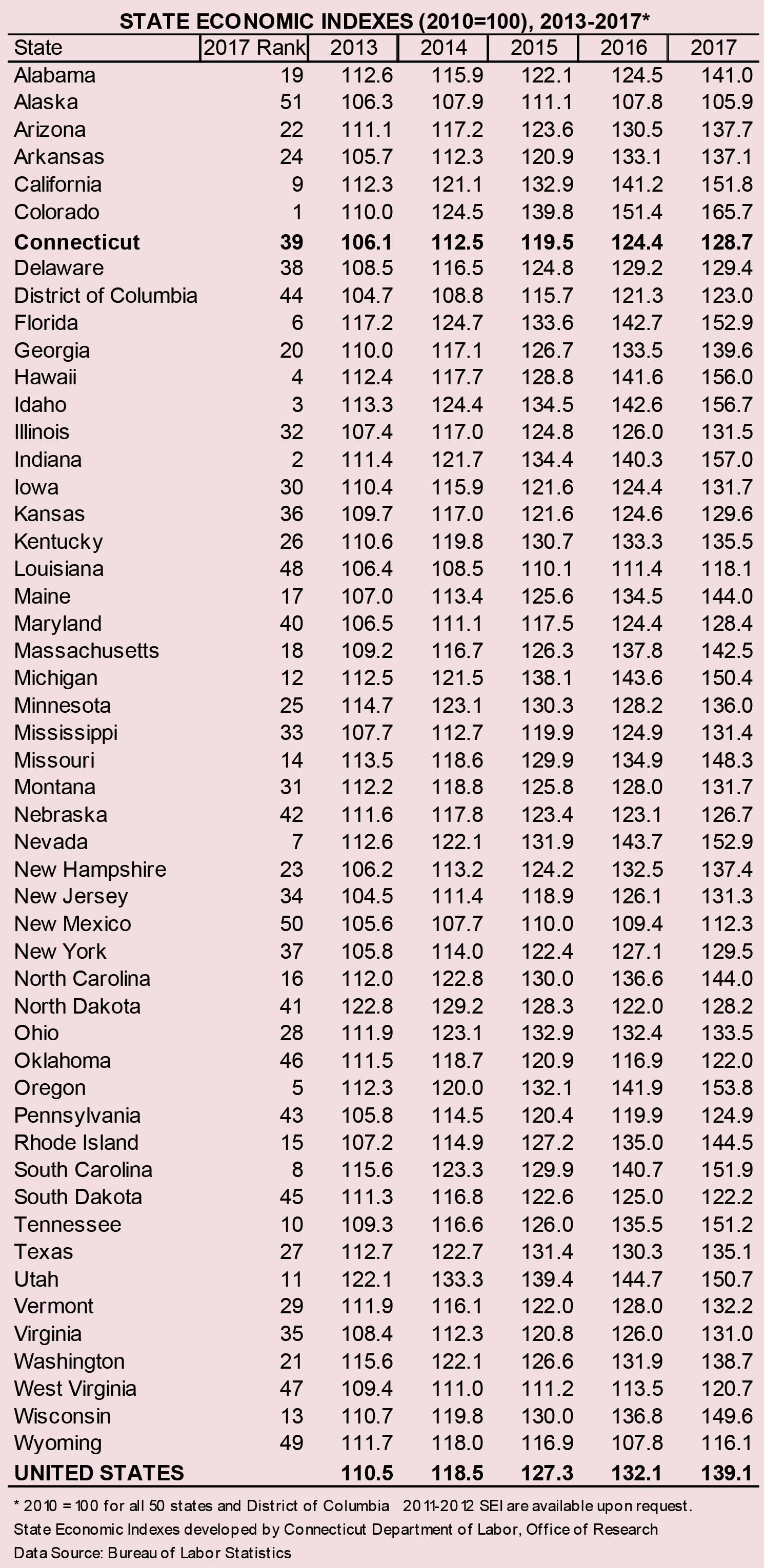 |
 |
November 2018 Connecticut Economic Digest |
 |
2017 State Economic Indexes
By Jungmin Charles Joo, Department of Labor and Dana Placzek, Research, Department of Labor
 or the third year in a row, Colorado came in first in the nation with the highest index of 165.7 last year, while Alaska ranked last (105.9). Our state's index of 128.7 was below the nationwide value of 139.1. or the third year in a row, Colorado came in first in the nation with the highest index of 165.7 last year, while Alaska ranked last (105.9). Our state's index of 128.7 was below the nationwide value of 139.1.
SEI: Methodology
Applying the same components and methodology of the Connecticut Town Economic Indexes (See October 2018 issue), the Connecticut Department of Labor's Office of Research also developed the State Economic Indexes for all 50 states and DC. With recently available annual average data from the Quarterly Census Employment and Wages (QCEW) program, along with the revised annual average unemployment rate from Local Area Unemployment Statistics (LAUS), annual SEI is reestimated for the 2010-2017 period.
These indexes provide a measure of the overall economic strength of each state that can be compared and ranked. Four annual average state economic indicators were used as components: 1. the number of the total covered business establishments, 2. total covered employment, 3. real covered wages, and 4. the unemployment rate. [ read more ]
Download SEI 2010-2017 data.xlsx |
 |
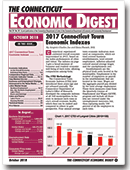
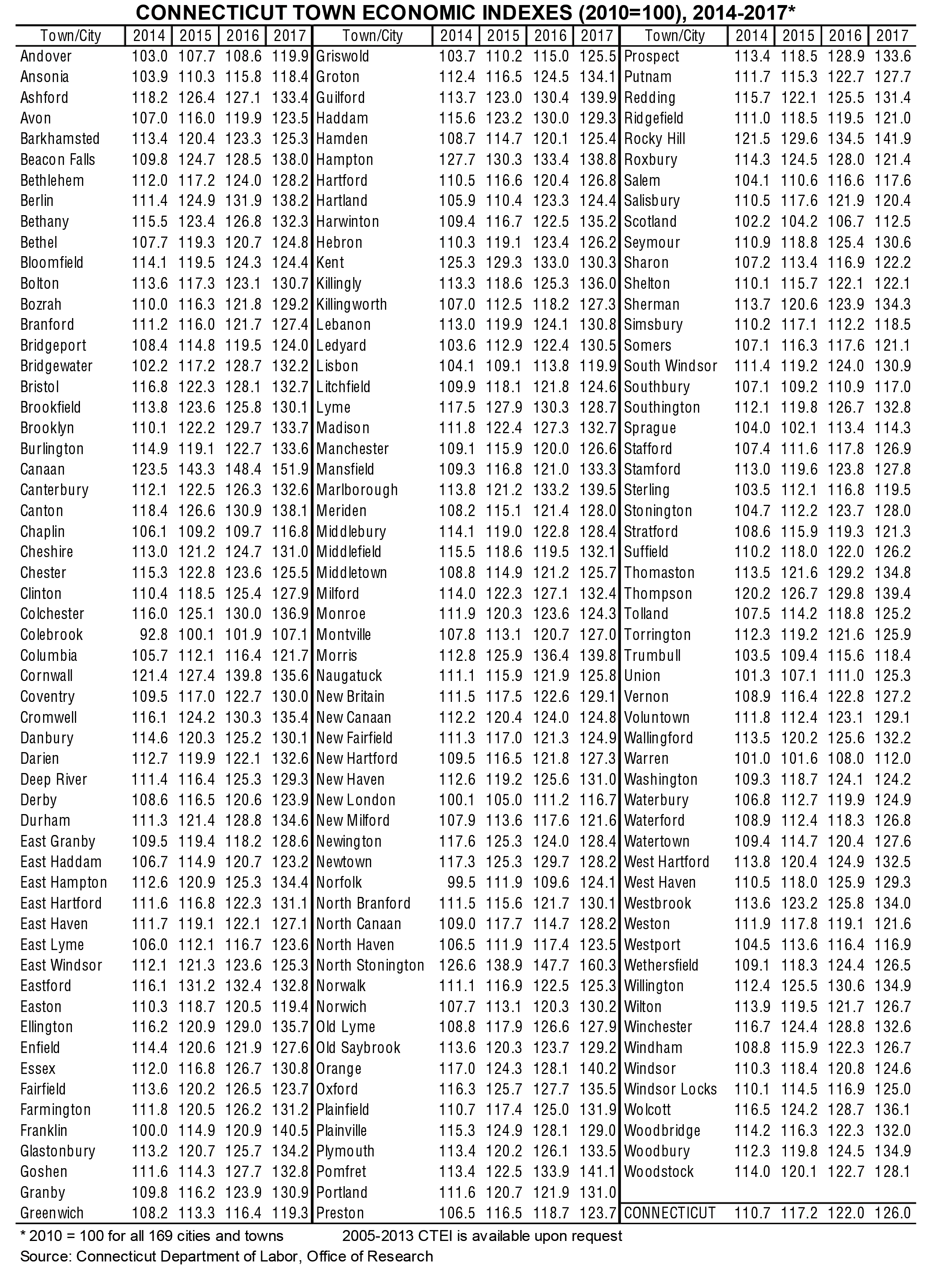 |
 |
October 2018 Connecticut Economic Digest |
 |
2017 Connecticut Town Economic Indexes
By Jungmin Charles Joo, Department of Labor and Dana Placzek, Research, Department of Labor
 onnecticut experienced continued overall economic improvement in 2017, based on the index performances of cities and towns. The indexes on page 3 give a broad measure of business and resident economic well-being of each town, allowing comparisons among them. onnecticut experienced continued overall economic improvement in 2017, based on the index performances of cities and towns. The indexes on page 3 give a broad measure of business and resident economic well-being of each town, allowing comparisons among them.
The CTEI Methodology
The Connecticut Town Economic Indexes (CTEI) were introduced three years ago and are released annually. The Connecticut Department of Labor's Office of Research developed the composite indexes of all 169 municipalities in the state to measure each town or city's overall economic health, which then can be ranked and compared to others to gain perspective. Four annual average town economic indicators were used as components, which are total covered business establishments, total covered employment, inflation-adjusted covered annual average wages, and the unemployment rate.
Establishments are the physical work units located in the municipality. Employment is the number of employees on payroll in the establishments that are located in the town. Wages are the aggregate payroll pay divided by the total average employment. These three measures come from the Quarterly Census of Employment and Wages (QCEW) program and include all those who are covered under the unemployment insurance law, thus capturing nearly 100 percent of all the employees in each town. [ read more ]
Download CTEI 2005-2017 data.xlsx |
 |
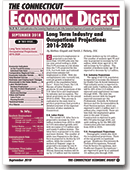 |
 |
September 2018 Connecticut Economic Digest |
 |
Long Term Industry and Occupational Projections: 2016-2026
By Matthew Krzyzek, Economist, Department of Labor and Patrick.Flaherty, Assistant Director of Research, Department of Labor
 onnecticut's employment is projected to increase by more than 110,000 jobs over the ten-year period ending in 2026. This 5.9% increase is a bit slower than the 7.4% projected for the U.S., but both state and national projections assume full employment in 2026. With the unemployment rate currently low, total job growth is limited by growth in the population/labor force. Every two years, the U.S. Bureau of Labor Statistics produces 10 year projections of the U.S. labor force and employment by industry and occupation. The latest projections are for the period 2016 to 2026. This process is replicated at the state level to produce projections that provide a detailed overview of the expected direction of labor markets in Connecticut. onnecticut's employment is projected to increase by more than 110,000 jobs over the ten-year period ending in 2026. This 5.9% increase is a bit slower than the 7.4% projected for the U.S., but both state and national projections assume full employment in 2026. With the unemployment rate currently low, total job growth is limited by growth in the population/labor force. Every two years, the U.S. Bureau of Labor Statistics produces 10 year projections of the U.S. labor force and employment by industry and occupation. The latest projections are for the period 2016 to 2026. This process is replicated at the state level to produce projections that provide a detailed overview of the expected direction of labor markets in Connecticut.
U.S. Labor Force
The overall U.S. labor force is projected to increase by 10.5 million workers from 2016 to 2026 (a 0.6% annualized growth rate) with increases of 4.5 million men and nearly 6 million women. The labor force is projected to be older and more diverse. The number of white non-Hispanics in the labor force is projected to decline by 2.5 million, while the number of workers of Hispanic origin is projected to increase by over 8 million. The number of Black or African-American workers will be up by 1.9 million and the number of Asian workers up by 2.6 million. The number of workers aged 55 and over is projected to increase by 6.4 million, while those aged 25 to 54 will increase by 5.4 million. The number of workers under age 25 is expected to decrease by 1.3 million. [ read more ]
|
 |
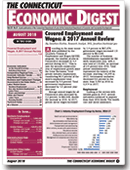 |
 |
August 2018 Connecticut Economic Digest |
 |
Covered Employment and Wages: A 2017 Annual Review
By Jonathan Kuchta, Research Analyst, Department of Labor
 ccording to the most recent Quarterly Census of Employment and Wages (QCEW) program, the number of jobs in Connecticut increased by 0.2 percent during 2017.1 This is now the seventh consecutive year of employment growth since the Great Recession. Total private industry employment, constituting 86.4 percent of the state's employment total, increased by 0.5 percent. Total government employment decreased by 1.6 percent year-over-year. ccording to the most recent Quarterly Census of Employment and Wages (QCEW) program, the number of jobs in Connecticut increased by 0.2 percent during 2017.1 This is now the seventh consecutive year of employment growth since the Great Recession. Total private industry employment, constituting 86.4 percent of the state's employment total, increased by 0.5 percent. Total government employment decreased by 1.6 percent year-over-year.
Average annual wages for all Connecticut jobs increased by 1.2 percent, to $66,648, double the increase in 2016. In 2017, private sector wages increased by 1.0 percent to $67,278; government wages increased 1.9 percent to $62,648.
The number of business establishments expanded for the sixth consecutive year, with a new total of 119,669, an increase of 2.0 percent over 2016. Total private establishments represented the entirety of the increase, reaching 116,295 in 2017. Government worksites decreased 0.6 percent in the state, from 3,393 in 2016 to 3,374 in 2017. [ read more ] |
 |
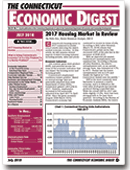 |
 |
July 2018 Connecticut Economic Digest |
 |
2017 Housing Market in Review
By Kolie Sun, Senior Research Analyst, Department of Economic and Community Development
 onnecticut's housing sector in 2017 continued to exhibit mixed results mirroring the state's modest economic recovery. In this article, we will examine several aspects of state's housing industry including permits, sales and prices. [ read more ] onnecticut's housing sector in 2017 continued to exhibit mixed results mirroring the state's modest economic recovery. In this article, we will examine several aspects of state's housing industry including permits, sales and prices. [ read more ]
What is Ailing Connecticut's Economy? Is it a City Problem? Is it a Sector Problem?
By Manisha Srivastava, Connecticut Office of Policy and Management
 onnecticut's economic recovery from the 2007-2010 recession has lagged not only the country but also the region. Table 1 compares Connecticut's job growth and gross state product growth (GSP - a measure of goods and services produced within a region, utilized as a broad measure of economic activity) to regional states and the nation. The nation recovered jobs lost as a result of the recession by May 2014, and has since experienced job growth of 12.5%. Connecticut's job growth since the recession at 4.6% is close to Maine (5.0%) and Vermont (5.4%), but is one of the few states yet to recover all jobs lost during the recession. On GSP, Connecticut is the only state to continue losing economic activity even since the end of the recession (-3.3%). In fact, in inflation-adjusted, or real GSP terms - Connecticut's economy is at the same level it was in 2004. This lackluster economic growth has resulted in anemic revenue growth in the state, leading to years of budgetary constraints. [ read more ] onnecticut's economic recovery from the 2007-2010 recession has lagged not only the country but also the region. Table 1 compares Connecticut's job growth and gross state product growth (GSP - a measure of goods and services produced within a region, utilized as a broad measure of economic activity) to regional states and the nation. The nation recovered jobs lost as a result of the recession by May 2014, and has since experienced job growth of 12.5%. Connecticut's job growth since the recession at 4.6% is close to Maine (5.0%) and Vermont (5.4%), but is one of the few states yet to recover all jobs lost during the recession. On GSP, Connecticut is the only state to continue losing economic activity even since the end of the recession (-3.3%). In fact, in inflation-adjusted, or real GSP terms - Connecticut's economy is at the same level it was in 2004. This lackluster economic growth has resulted in anemic revenue growth in the state, leading to years of budgetary constraints. [ read more ]
|
 |
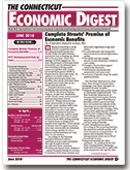 |
 |
June 2018 Connecticut Economic Digest |
 |
Complete Streets' Promise of Economic Benefits
By Al Sylvestre, Research Analyst, Department of Labor
 alking or bicycling to work without competition from speeding motorists is just one benefit of the Complete Streets movement that is making its effects felt in Connecticut. Since the passage of 2009 legislation, the state Department of Transportation (ConnDOT) and its advisors have been working to bring a safer commute together with Transit Oriented Development (TOD) to Connecticut's cities and towns. In addition to a brief outline of Complete Streets principles and benefits, this article describes what its application looks like in two cities and one suburb. [ read more ] alking or bicycling to work without competition from speeding motorists is just one benefit of the Complete Streets movement that is making its effects felt in Connecticut. Since the passage of 2009 legislation, the state Department of Transportation (ConnDOT) and its advisors have been working to bring a safer commute together with Transit Oriented Development (TOD) to Connecticut's cities and towns. In addition to a brief outline of Complete Streets principles and benefits, this article describes what its application looks like in two cities and one suburb. [ read more ]
2017 Unemployment Rate by Town
By Jungmin Charles Joo, Department of Labor and Dana Placzek, Research, Department of Labor
 n 2017, for the seventh year, most municipalities experienced a decline in their unemployment rate, but fewer dropped than in 2016. n 2017, for the seventh year, most municipalities experienced a decline in their unemployment rate, but fewer dropped than in 2016.
2016 to 2017
Out of 169 cities and towns in the state, the rate fell in 152, rose in 9, and 8 were unchanged in 2017. On the other hand, 159 were down, 3 were up, and 7 remained the same in 2016. Canaan had the lowest unemployment rate of 2.8%, while the residents of Hartford experienced the highest rate of 8.1% last year. See table on page 3 for the complete town data. The annual average statewide unemployment rate in 2017 was 4.7%, down from 5.1% in 2016. Overall, a total of 126 cities and towns had jobless rates below the statewide figure of 4.7%, 37 had rates above it, and six had rates equal to it last year. By comparison, there were 124 cities and towns that had rates below the statewide average of 5.1%, 39 above it, and six the same. [ read more ]
|
 |
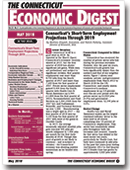 |
 |
May 2018 Connecticut Economic Digest |
 |
Connecticut's Short-Term Employment Projections Through 2019
By Matthew Krzyzek, Economist, Department of Labor and Patrick.Flaherty, Assistant Director of Research, Department of Labor
 urrent Situation urrent Situation
Connecticut is off to a good start in 2018. As reported in the March Digest, Connecticut's economic recovery slowed in 2017, but the first quarter of 2018 has shown significant job gains. While data are preliminary and subject to significant revision, first quarter employment rose more than 8,700 jobs from the fourth quarter of 2017 and more than 7,200 from the first quarter of 2017. Private sector employment gained 9,400 from the fourth quarter with Health Care & Social Assistance up 2,500 (+3,800 from the first quarter of 2017), Accommodation and Food Services up 1,300 (+900 from the 2017 Q1) and Professional, Scientific, and Technical Services up over 1,000. Manufacturing was a bright spot in 2017 - the first quarter of 2018 was up 5,100 from the first quarter of 2017 with most of the gains in Durable Goods.
In 2017, the average seasonally adjusted monthly jobs gain was just 400 jobs per month compared to 1,500 jobs per month for the first three months of 2018. Though this pace of growth is not likely to continue - and is subject to revision - the Connecticut economy was showing positive momentum as we headed into spring. [ read more ] |
 |
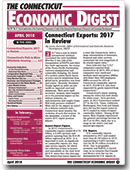 |
 |
April 2018 Connecticut Economic Digest |
 |
Connecticut Exports: 2017 in Review
By Laura Jaworski, Office of International and Domestic Affairs, Department of Economic and Community Development
 017 was a year in which international relations dominated the news headlines. Whether it was talk of the renegotiation of NAFTA and other free trade agreements, the status of the Trans-Pacific Partnership, currency manipulation and commodity dumping, the threat of a nuclear armed North Korea or entry and/or withdrawal from global pacts, geopolitics was front and center. Recently, President Trump signed an order on new tariffs on imported steel and aluminum. With such tariff increases, analysis must happen as to the potential impact on the defense industry, its subcontractors and supply chain. Will trade partners retaliate? What will be the impact on sales? As a defense-oriented state, Connecticut must monitor the evolution of such discussions. In the meantime, a review of the state's 2017 export position follows. [ read more ] 017 was a year in which international relations dominated the news headlines. Whether it was talk of the renegotiation of NAFTA and other free trade agreements, the status of the Trans-Pacific Partnership, currency manipulation and commodity dumping, the threat of a nuclear armed North Korea or entry and/or withdrawal from global pacts, geopolitics was front and center. Recently, President Trump signed an order on new tariffs on imported steel and aluminum. With such tariff increases, analysis must happen as to the potential impact on the defense industry, its subcontractors and supply chain. Will trade partners retaliate? What will be the impact on sales? As a defense-oriented state, Connecticut must monitor the evolution of such discussions. In the meantime, a review of the state's 2017 export position follows. [ read more ]
Connecticut's Path to More Affordable Housing
By Al Sylvestre, Research Analyst, Department of Labor
 ecuring affordable housing in Connecticut's expensive residential market is a significant challenge for the state's workforce. What follows is a brief overview of some of the conundrum's components and some methods land use planners and policy makers employ to smooth the path to more affordable housing. ecuring affordable housing in Connecticut's expensive residential market is a significant challenge for the state's workforce. What follows is a brief overview of some of the conundrum's components and some methods land use planners and policy makers employ to smooth the path to more affordable housing.
Challenges
According to the Partnership for Strong Communities, Connecticut has the sixth highest housing cost in the US while nearly a third of the population in 102 of its 169 cities and towns are spending at least 30% of their incomes on housing as shown on the map. As the housing cost burden rises with age, more households headed by persons over age 60 in a state with the sixth oldest population in the nation will find their incomes stretched more thinly. As people with disabilities and those above age 60 re-enter or remain in the workforce longer, access to housing becomes more difficult because: [ read more ]
|
 |
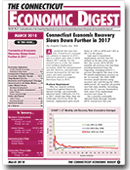 |
 |
March 2018 Connecticut Economic Digest |
 |
Connecticut Economic Recovery Slows Down Further in 2017
By Jungmin Charles Joo, Department of Labor
 s predicted this time last year, Connecticut's economy did continue to improve in 2017, and at a slower pace than in 2016 (March 2017 article). For the seventh year in a row, the revised total nonfarm employment increased, while the unemployment rate fell. However, real personal income decreased for the last two years, and more economic indicators pointed in negative directions than in 2016. s predicted this time last year, Connecticut's economy did continue to improve in 2017, and at a slower pace than in 2016 (March 2017 article). For the seventh year in a row, the revised total nonfarm employment increased, while the unemployment rate fell. However, real personal income decreased for the last two years, and more economic indicators pointed in negative directions than in 2016.
Nonfarm Employment
After our annual revision, Connecticut gained (based on annual average, not seasonally adjusted data) 1,800 jobs (+0.1%) in 2017, which was fewer than the 4,800 jobs (+0.3%) in 2016. By contrast, employment grew much faster at 1.8% in 2016 and 1.6% in 2017 in the nation.
Last year's Connecticut employment recovery was the slowest in the last seven years. In fact, the current 2010-2018's monthly job recovery rate has been trending downward from the beginning, averaging below 0.1 percent throughout the most of its 95-month employment recovery so far. In contrast, the 2003-2008 recovery period showed rising recovery rate, and during the 1993-2000 period, the monthly job growth rate had risen steadily, increasing above the 0.1 percent threshold in later years of its employment recovery. [ read more ]
|
 |
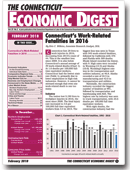 |
 |
February 2018 Connecticut Economic Digest |
 |
Connecticut's Work-Related Fatalities in 2016
By Erin C. Wilkins, Associate Research Analyst, Department of Labor
 onnecticut lost 28 lives to work injuries in 2016, decreasing from 2015's count of 44. This is the smallest loss since 2008. It is also below Connecticut's annual average of 39 work-related deaths. At 1.6 deaths per 100,000 fulltime equivalent workers, Connecticut had the lowest state rate, primarily due to lower employment in high-risk industries. However, it cannot be stressed enough that even one work-related death is one too many. onnecticut lost 28 lives to work injuries in 2016, decreasing from 2015's count of 44. This is the smallest loss since 2008. It is also below Connecticut's annual average of 39 work-related deaths. At 1.6 deaths per 100,000 fulltime equivalent workers, Connecticut had the lowest state rate, primarily due to lower employment in high-risk industries. However, it cannot be stressed enough that even one work-related death is one too many.
Industry
The nation lost 5,190 lives to workplace injuries in 2016, the most since 2008. The fatal injury rate increased to 3.6 per 100,000 full-time equivalent workers from 3.4 in 2015. The biggest loss was seen in Texas with 545 work-related fatalities, followed by California with 376 and Florida with 309 deaths. Rhode Island recorded the fewest, with 9. High rates were recorded in Wyoming (12.3) and Alaska (10.6). Wyoming's highest rate was in the transportation and utilities industry, at 46.8. Alaska recorded a rate of 44.5 in manufacturing and 42.0 in transportation and utilities.
Nationally, the construction industry recorded the biggest number of fatalities at 991, followed by transportation and warehousing with 825. The highest rate by industry was seen in truck transportation, with 25.6 deaths per 100,000 full time equivalent workers. [ read more ]
|
 |
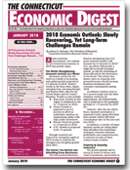 |
 |
January 2018 Connecticut Economic Digest |
 |
2018 Economic Outlook: Slowly Recovering, Yet Long-Term Challenges Remain
By Alissa K. DeJonge, Vice President of Research, Connecticut Economic Resource Center, Inc.
 mid numerous uncertainties, the outlook for the Connecticut economy in 2018 has positive signs. mid numerous uncertainties, the outlook for the Connecticut economy in 2018 has positive signs.
The World: Strengthening Economic Activity as a Whole
Economic activity for the world as a whole is increasing, with global growth projected at 3.7 percent in 2018. Positive trends in the Euro Area, Japan, emerging Asia, emerging Europe, and Russia offset risks for the United States and the United Kingdom. Trends to note include:
- Euro Area: Growth in this region is estimated to rise to 1.9% in 2018.
- China: Growth is projected to be 6.5 percent in 2018 as authorities continue an expansionary policy with high public investment.
- Russia: Projected growth is 1.8 percent in 2018.
- U.K.: Growth is projected to be 1.5 percent.
Enough countries are expected to strengthen again in 2018 so that it could be the strongest year for global growth since 2011.
The Nation: Tax Reform and Rebuilding From Hurricanes
The International Monetary Fund is anticipating that U.S. gross domestic product will increase by 2.3 percent in 2018. U.S. tax reform will provide a slight lift to overall economic growth, as will the rebuilding of areas affected by the hurricanes in the South. Tax reform that lowers rates on corporate and personal income should increase business investment and consumer consumption during 2018. [ read more ]
|
 |
 |
 |
 |
|
 |
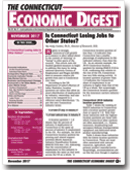 |
 |
December 2017 Connecticut Economic Digest |
 |
Life in the Slow Lane?
By Patrick.Flaherty, Assistant Director of Research, Department of Labor
 The Connecticut State Data Center at the University of Connecticut recently released population projections for Connecticut and its towns through 2040. The projections suggest a slowing of population growth but do not show an exodus of young people from Connecticut. Declines in the younger population groups are driven by a low birth rate while migration out of state is concentrated in older age groups. Nevertheless, the number of senior citizens will increase while the school-aged population will decline. Growth will be uneven across cities and towns with some (particularly the largest cities) gaining significant population while others decline. Some of the smallest towns are projected to reverse part of the strong growth they have experienced in recent decades. The Connecticut State Data Center at the University of Connecticut recently released population projections for Connecticut and its towns through 2040. The projections suggest a slowing of population growth but do not show an exodus of young people from Connecticut. Declines in the younger population groups are driven by a low birth rate while migration out of state is concentrated in older age groups. Nevertheless, the number of senior citizens will increase while the school-aged population will decline. Growth will be uneven across cities and towns with some (particularly the largest cities) gaining significant population while others decline. Some of the smallest towns are projected to reverse part of the strong growth they have experienced in recent decades.
Statewide Overview
Connecticut's population increased by over 255,000 from 1970 to 1990 and added an additional 300,000 from 1990 to 2015, a 9.3% increase. Population growth is projected to grow just 1.7% in the 25 years from 2015 to 2040, less than 20% of the growth rate of the previous 25 years. Focusing on the most recent 15 year period and comparing it to the next shows a similar pattern. Population grew 5.5% from 2000 to 2015 but is projected to grow just 1.1% from 2015 to 2030. While these projections are not predictions of what will happen (unforeseen events such as changes in the economy could affect these projections), they are carefully calculated projections based on fertility rates, survival rates, domestic migration, international migration, and college migration. [ read more ]
|
 |
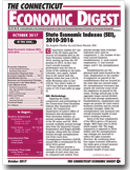 |
 |
October 2017 Connecticut Economic Digest |
 |
State Economic Indexes (SEI), 2010-2016
By Jungmin Charles Joo, Department of Labor and Dana Placzek, Research, Department of Labor
 onnecticut ranked 32nd out of the 50 states and the District of Columbia (DC) in the State Economic Indexes (SEI) in 2016, moving up from the 39th position in 2015. In fact, last year's overall economic performance was the best in terms of the ranking in six years. Colorado, once again, ranked first in the nation with the highest index last year (145.3), while Wyoming came in last (102.6). Our state's index of 120.5 was below the nationwide value of 124.5. onnecticut ranked 32nd out of the 50 states and the District of Columbia (DC) in the State Economic Indexes (SEI) in 2016, moving up from the 39th position in 2015. In fact, last year's overall economic performance was the best in terms of the ranking in six years. Colorado, once again, ranked first in the nation with the highest index last year (145.3), while Wyoming came in last (102.6). Our state's index of 120.5 was below the nationwide value of 124.5.
SEI: Methodology
Applying the same components and methodology of the Connecticut Town Economic Indexes (See September 2017 issue), the Connecticut Department of Labor's Office of Research also developed the State Economic Indexes, an annual composite index of each of the 50 states and DC. With recently available annual average data from the Quarterly Census Employment and Wages (QCEW) program, along with the revised annual average unemployment rate from Local Area Unemployment Statistics (LAUS), annual SEI is reestimated for the 2010-2016 period.
These indexes provide a measure of the overall economic strength of each state that can be compared and ranked. Four annual average state economic indicators were used as components: 1. the number of the total covered business establishments, 2. total covered employment, 3. real covered wages, and 4. the unemployment rate. [ read more ]
|
 |
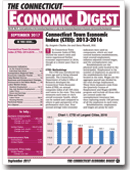 |
 |
September 2017 Connecticut Economic Digest |
 |
Connecticut Town Economic Index (CTEI): 2013-2016
By Jungmin Charles Joo, Department of Labor and Dana Placzek, Research, Department of Labor
 he Connecticut Town Economic Index (CTEI) showed the state's cities and towns experienced further economic improvement in 2016, though at a slower pace than in 2015. he Connecticut Town Economic Index (CTEI) showed the state's cities and towns experienced further economic improvement in 2016, though at a slower pace than in 2015.
CTEI: Methodology: The CTEI was introduced two years ago and is being released annually. The Connecticut Department of Labor's Office of Research developed the Connecticut Town Economic Index (CTEI), an annual composite index of all 169 cities and towns in the state. This index measures each town or city's overall economic health, which can be ranked and compared to others to gain perspective of its performance each year. Four annual average town economic indicators were used as components, which are total covered business establishments, total covered employment, inflation-adjusted covered wages, and the unemployment rate.
Establishments are the physical work units located in the municipality. Employment is the number of employees on payroll in the establishments that are located in the town. Wages are the aggregate payroll pay divided by the total average employment. These three measures come from the Quarterly Census of Employment and Wages (QCEW) program and include all those who are covered under the unemployment insurance law, thus capturing nearly 100 percent of all the employees in each town.[ read more ]
|
 |
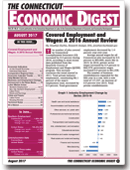 |
 |
August 2017 Connecticut Economic Digest |
 |
Covered Employment and Wages: A 2016 Annual Review
By Jonathan Kuchta, Research Analyst, Department of Labor
 he number of jobs covered by Connecticut Unemployment Insurance (UI) increased by 0.2 percent during 2016, according to most recent data published from the Quarterly Census of Employment and Wages (QCEW) program. This increase continues the trend started in 2011. Total private industry employment, constituting 86.1 percent of the state's employment total, increased by 0.5 percent. Total government employment decreased by 1.4 percent year-over-year. he number of jobs covered by Connecticut Unemployment Insurance (UI) increased by 0.2 percent during 2016, according to most recent data published from the Quarterly Census of Employment and Wages (QCEW) program. This increase continues the trend started in 2011. Total private industry employment, constituting 86.1 percent of the state's employment total, increased by 0.5 percent. Total government employment decreased by 1.4 percent year-over-year.
Average annual wages for all Connecticut jobs increased by 0.5 percent to $65,869, much like in 2015. In 2016, private sector wages increased by 0.4 percent to $66,579; government wages increased 0.9 percent to $61,458.
The number of business establishments expanded for the fifth year in a row, with a new total of 117,337, an increase of 0.9 percent over 2015. Total private establishments represented the entirety of the increase, reaching 113,944 in 2016. Government worksites decreased 0.9 percent in the state, from 3,425 in 2015 to 3,393 in 2016. [ read more ] |
 |
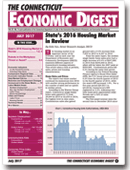 |
 |
July 2017 Connecticut Economic Digest |
 |
State's 2016 Housing Market in Review
By Kolie Sun, Senior Research Analyst, Department of Economic and Community Development
 he housing market is an important sector of the economy, and so each year the Department of Economic and Community Development (DECD) examines different aspects of Connecticut's housing industry. This article takes a look at permits, sales, prices and housing characteristics. he housing market is an important sector of the economy, and so each year the Department of Economic and Community Development (DECD) examines different aspects of Connecticut's housing industry. This article takes a look at permits, sales, prices and housing characteristics.
Home Sales and Prices
The state's real estate market continued its momentum into 2016 with another strong performance in the number of sales and an uptick in median prices.
According to the Warren Group report, Connecticut single-family home sales gained 8.7% from 29,644 in 2015 to 32,235 in 2016, the highest level in nine years. Condominium sales also gained ground with a 5.3% increase from 7,853 in 2015 to 8,267 in 2016. [ read more ]
Robots in the Workplace: Threat or Asset?
By Patrick.Flaherty, Assistant Director of Research, Department of Labor
 The latest breakthroughs in robotics and artificial intelligence have awakened fears that technological advances will lead to a large decrease in the overall level of employment and widespread unemployment. While there will be disruptions, and many occupations are at high risk of computerization over the next decade or two, the dynamic labor market continues to create opportunities for workers with the right skills and education. [ read more ] The latest breakthroughs in robotics and artificial intelligence have awakened fears that technological advances will lead to a large decrease in the overall level of employment and widespread unemployment. While there will be disruptions, and many occupations are at high risk of computerization over the next decade or two, the dynamic labor market continues to create opportunities for workers with the right skills and education. [ read more ]
|
 |
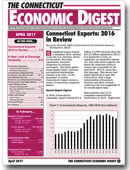 |
 |
April 2017 Connecticut Economic Digest |
 |
Connecticut Exports: 2016 in Review
By Laura Jaworski, Office of International and Domestic Affairs, Department of Economic and Community Development
 eopolitical issues seemed to dominate 2016, whether it was the U.S. elections, Brexit, the Eurozone, free trade agreements, economic integration or national sovereignty. How these global issues impact trade, currency, and political relationships remains to be seen. In the meantime, to assess Connecticut's export status, a review of several key categories follows. eopolitical issues seemed to dominate 2016, whether it was the U.S. elections, Brexit, the Eurozone, free trade agreements, economic integration or national sovereignty. How these global issues impact trade, currency, and political relationships remains to be seen. In the meantime, to assess Connecticut's export status, a review of several key categories follows.
Annual Export Figures
In 2016, Connecticut's commodity exports totaled $14.4 billion, a 5.49% decrease from the $15.24 billion registered in 2015. It is important to note, as significant as commodity exports are, they omit service exports, for which the collection of data is inexact and unavailable at the state level. All U.S. states face this data gap. This means that export figures for a state like Connecticut- with a large concentration of insurance, financial and other services understate the true magnitude of its overall export value. [ read more ]
A New Look at Earnings Inequality
By Patrick.Flaherty, Assistant Director of Research, Department of Labor
 here is a great deal of literature documenting the increase in income inequality in the United States from the mid-1970s to the present. Data from the Current Population Survey (CPS) and the Internal Revenue Service (IRS) show similar trends. In a recent presentation, Dr. James R. Spletzer of the U.S. Census Bureau reviewed this data and presented new findings using data from the Longitudinal Employer-Household Dynamics (LEHD). [ read more ] here is a great deal of literature documenting the increase in income inequality in the United States from the mid-1970s to the present. Data from the Current Population Survey (CPS) and the Internal Revenue Service (IRS) show similar trends. In a recent presentation, Dr. James R. Spletzer of the U.S. Census Bureau reviewed this data and presented new findings using data from the Longitudinal Employer-Household Dynamics (LEHD). [ read more ]
|
 |
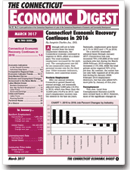 |
 |
March 2017 Connecticut Economic Digest |
 |
Connecticut Economic Recovery Continues in 2016
By Jungmin Charles Joo, Department of Labor
 lthough still yet to fully recover from the latest employment downturn, the Connecticut economy continued to improve in 2016, albeit at a slower pace. The total nonfarm employment increased for the sixth year. The unemployment rate fell for six consecutive years. Real personal income rose for the third year. Other economic indicators, however, were somewhat mixed. lthough still yet to fully recover from the latest employment downturn, the Connecticut economy continued to improve in 2016, albeit at a slower pace. The total nonfarm employment increased for the sixth year. The unemployment rate fell for six consecutive years. Real personal income rose for the third year. Other economic indicators, however, were somewhat mixed.
Nonfarm Employment
After our annual revision, Connecticut gained (based on annual average, not seasonally adjusted data) 5,000 jobs (+0.3%) in 2016, which was fewer than the 12,600 jobs (+0.8%) in 2015. Last year's employment recovery was the slowest in the last six years. Nationally, employment grew faster at 2.1% in 2015 and 1.7% in 2016. On a monthly seasonally adjusted basis through January 2017, Connecticut has now recovered 70% (+83,600) of the total nonfarm jobs lost during the March 2008-February 2010 employment recession (-119,100), while the total private sector regained 92% of its job loss. By contrast, the nation has not only fully regained all of the jobs lost during its January 2008-February 2010 employment downturn, but has also added 82% more jobs by January his year. [ read more ]
|
 |
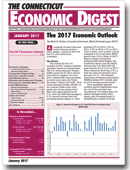 |
 |
January 2017 Connecticut Economic Digest |
 |
The 2017 Economic Outlook
By Mark Prisloe, Associate Economist, Department of Economic and Community Development
 n analysis of recent data and trends indicates positive - albeit modest - growth in 2017 for the U.S. and Connecticut economies. n analysis of recent data and trends indicates positive - albeit modest - growth in 2017 for the U.S. and Connecticut economies.
The Nation
The outlook for the U.S. economy in 2017 remains relatively optimistic based on technical data. The U.S. Gross Domestic Product (GDP), except for Q1-2011 and Q1-2014 (when it slipped 1.5% and 0.9%, respectively), has now grown for seven years since the "Great Recession" ended in Q2-2009. Real Gross Domestic Product (RGDP), or the constant dollar value of all goods and services produced by labor and capital located in the U.S., since Q2-2009 has averaged a 2.1% annual increase from the preceding quarter (Figure 1). After growing 2.5% in 2010, 1.6% in 2011, 2.2% in 2012, 1.7% in 2013, 2.4% in 2014, 2.6% in 2015, and an estimated 3.2% in Q3-2016, RGDP growth near 2.5% is likely in 2017. Major economic forecasters, including HIS Global Insight, The Conference Board, and the OECD, forecast that U.S. Real GDP will grow between 2 to 2 1/2% in 2017. Their outlook for 2016 was 3.4%, a little less than the previous year's forecast of 3.7%. The National Association of Business Economists (NABE) median 2017 outlook calls for 2.3% average annual growth. [ read more ]
|
 |
 |
 |
|
 |
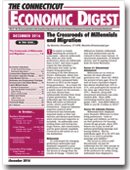 |
 |
December 2016 Connecticut Economic Digest |
 |
The Crossroads of Millennials and Migration
By Manisha Srivastava, Connecticut Office of Policy and Management
 he nation is closely watching the actions of millennials - what do millennials like, what are their work preferences, where do millennials want to live? And there is good reason for this attention - millennials now make up the largest living generation. According to the Pew Research Center, millennials, whom they define as born between 1981 and 1997, recently surpassed baby boomers in 2015 as the largest living generation. As a result the preferences of millennials do have a sizable impact on the economy - and their choices have substantially deviated from those of prior generations. But as millennials age their preferences likely will return to historical norms, which could benefit Connecticut. Long-run domestic migration patterns show Connecticut has historically imported adults in their late twenties and thirties (and forties when international migration is included). As millennials start settling down and moving into larger homes, safe communities, and for good schools, hopefully Connecticut will stand out as a top destination. [ read more ] he nation is closely watching the actions of millennials - what do millennials like, what are their work preferences, where do millennials want to live? And there is good reason for this attention - millennials now make up the largest living generation. According to the Pew Research Center, millennials, whom they define as born between 1981 and 1997, recently surpassed baby boomers in 2015 as the largest living generation. As a result the preferences of millennials do have a sizable impact on the economy - and their choices have substantially deviated from those of prior generations. But as millennials age their preferences likely will return to historical norms, which could benefit Connecticut. Long-run domestic migration patterns show Connecticut has historically imported adults in their late twenties and thirties (and forties when international migration is included). As millennials start settling down and moving into larger homes, safe communities, and for good schools, hopefully Connecticut will stand out as a top destination. [ read more ]
|
 |
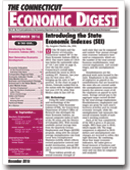 |
 |
November 2016 Connecticut Economic Digest |
 |
Introducing the State Economic Indexes (SEI)
By Jungmin Charles Joo
 f the 50 states and the District of Columbia, Connecticut ranked 38th in the State Economic Indexes (SEI) in 2015. Our state's index of 118.9 was below the nationwide value of 124.1 (see table on page 2). Over the last five years, Connecticut's overall index performed the worst in 2013, ranking 45th. However, last year was the best since 2011, bringing up the state to 38th position. As the chart on page 3 shows, Colorado ranked first in the nation with the highest index last year (137.9), while New Mexico came in last (107.2). [ read more ] f the 50 states and the District of Columbia, Connecticut ranked 38th in the State Economic Indexes (SEI) in 2015. Our state's index of 118.9 was below the nationwide value of 124.1 (see table on page 2). Over the last five years, Connecticut's overall index performed the worst in 2013, ranking 45th. However, last year was the best since 2011, bringing up the state to 38th position. As the chart on page 3 shows, Colorado ranked first in the nation with the highest index last year (137.9), while New Mexico came in last (107.2). [ read more ]
Next Generation Economic Development
By Al Sylvestre, Research Analyst, Department of Labor
 onnecticut is dependent on large employers for jobs and job growth. A significant proportion of private-sector employment is in companies with 500 or more employees. Early this year, based on the premise that Connecticut's economy would benefit from job growth among businesses of all sizes, the Capitol Region Council of Governments convened a panel of experts composed of business and government leaders to generate ideas for nurturing small to medium-size businesses in economic sectors that show promise for bringing more wellpaying jobs to Connecticut. The successful firms described below show that Connecticut has the potential to experience growth in diverse industries. [ read more ] onnecticut is dependent on large employers for jobs and job growth. A significant proportion of private-sector employment is in companies with 500 or more employees. Early this year, based on the premise that Connecticut's economy would benefit from job growth among businesses of all sizes, the Capitol Region Council of Governments convened a panel of experts composed of business and government leaders to generate ideas for nurturing small to medium-size businesses in economic sectors that show promise for bringing more wellpaying jobs to Connecticut. The successful firms described below show that Connecticut has the potential to experience growth in diverse industries. [ read more ]
|
 |
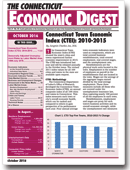 |
 |
October 2016 Connecticut Economic Digest |
 |
Connecticut Town Economic Index (CTEI): 2010-2015
By Jungmin Charles Joo, Department of Labor
 he Connecticut Town Economic Index (CTEI) showed the state's cities and towns experienced further economic improvement in 2015. The CTEI was introduced last year and will be released annually in the October issue. The revised 2011 index values for all 169 cities and towns in the state are available upon request. he Connecticut Town Economic Index (CTEI) showed the state's cities and towns experienced further economic improvement in 2015. The CTEI was introduced last year and will be released annually in the October issue. The revised 2011 index values for all 169 cities and towns in the state are available upon request.
CTEI: Methodology: The Connecticut Department of Labor's Office of Research developed the Connecticut Town Economic Index (CTEI), an annual composite index of all 169 cities and towns in Connecticut. This index measures each town or city's overall economic health, which can be ranked and compared to others to gain perspective of its performance each year. Four annual average town economic indicators were used as components, which are total covered business establishments, total covered employment, real covered wages, and the unemployment rate. [ read more ]
Seasonally Adjusted Unemployment Rates by Labor Market Area, 1990-July 2016
By Jungmin Charles Joo, Department of Labor
 n addition to not seasonally adjusted unemployment rate estimates, the Bureau of Labor Statistics (BLS) also produces monthly seasonally adjusted data by major labor market areas (LMAs) for Connecticut, going back to 1990. Because of the one-month lag, these estimates are not published in the Labor Situation or the Connecticut Economic Digest, but they are available upon request. This article looks at the long-term monthly trends of seasonally adjusted unemployment rates of all the LMAs. The Connecticut Department of Labor's Office of Research separately produced seasonally adjusted estimates for small areas (Enfield, Torrington-Northwest, and Danielson-Northeast) so that all areas in the state can be compared and analyzed. Note that because of the recent geographical changes, these small non-BLS LMAs can be seasonally adjusted only back to 2010. [ read more ] n addition to not seasonally adjusted unemployment rate estimates, the Bureau of Labor Statistics (BLS) also produces monthly seasonally adjusted data by major labor market areas (LMAs) for Connecticut, going back to 1990. Because of the one-month lag, these estimates are not published in the Labor Situation or the Connecticut Economic Digest, but they are available upon request. This article looks at the long-term monthly trends of seasonally adjusted unemployment rates of all the LMAs. The Connecticut Department of Labor's Office of Research separately produced seasonally adjusted estimates for small areas (Enfield, Torrington-Northwest, and Danielson-Northeast) so that all areas in the state can be compared and analyzed. Note that because of the recent geographical changes, these small non-BLS LMAs can be seasonally adjusted only back to 2010. [ read more ]
|
 |
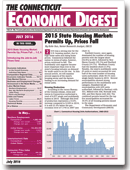 |
 |
July 2016 Connecticut Economic Digest |
 |
2015 State Housing Market: Permits Up, Prices Fall
By Kolie Sun, Senior Research Analyst, Department of Economic and Community Development
 015 was a strong year for the U.S. housing market, due to high home sales and rising home prices. Connecticut followed the nation in terms of sales, however, prices continued to fall. The multifamily unit segment became more important than ever in the state's housing industry as demand for multi-units is on the rise. In this annual article, we will examine several aspects of the state's housing sector and the factors leading to an increasing demand for rental units. [ read more ] 015 was a strong year for the U.S. housing market, due to high home sales and rising home prices. Connecticut followed the nation in terms of sales, however, prices continued to fall. The multifamily unit segment became more important than ever in the state's housing industry as demand for multi-units is on the rise. In this annual article, we will examine several aspects of the state's housing sector and the factors leading to an increasing demand for rental units. [ read more ]
Introducing the Job-to-Job Flows Data
By Patrick.Flaherty, Assistant Director of Research, Department of Labor
 his article introduces a new set of statistics about the dynamic nature of the labor market - the Job-to-Job Flows. These statistics provide information on workers who leave or lose one job and take another with little or no unemployment in between. For example, when a worker quits one job to take a better job at a different company, this will be counted as a job-to-job flow. While the data is still considered "Beta" and will be enhanced and improved in future years, the recently released numbers help us understand job changes in Connecticut. [ read more ] his article introduces a new set of statistics about the dynamic nature of the labor market - the Job-to-Job Flows. These statistics provide information on workers who leave or lose one job and take another with little or no unemployment in between. For example, when a worker quits one job to take a better job at a different company, this will be counted as a job-to-job flow. While the data is still considered "Beta" and will be enhanced and improved in future years, the recently released numbers help us understand job changes in Connecticut. [ read more ]
|
 |
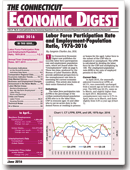 |
 |
June 2016 Connecticut Economic Digest |
 |
Labor Force Participation Rate and Employment-Population Ratio, 1976-2016
By Jungmin Charles Joo, Department of Labor
 he Connecticut Economic Digest now publishes the monthly labor force participation rate and employment-population ratio, which are found under the "Unemployment" table on page 6. These two data, produced by the Bureau of Labor Statistics (BLS), provide additional perspectives to the unemployment rate data in assessing the current economic condition. This article also looks at their entire historical trends. [ read more ] he Connecticut Economic Digest now publishes the monthly labor force participation rate and employment-population ratio, which are found under the "Unemployment" table on page 6. These two data, produced by the Bureau of Labor Statistics (BLS), provide additional perspectives to the unemployment rate data in assessing the current economic condition. This article also looks at their entire historical trends. [ read more ]
Annual Town Unemployment Rates, 2011-2015
By Jungmin Charles Joo, Department of Labor
 nemployment rates come from the Local Area Unemployment Statistics (LAUS) program. There are total of 169 cities and towns in Connecticut for which labor force estimates are produced monthly by the Connecticut Department of Labor in cooperation with the U.S. Bureau of Labor Statistics (BLS). For a brief explanation of the methodology of LAUS, see "Labor Force Estimates" on page 23. In July 2015 Digest, 2010-2014 annual average town unemployment rate estimates were published. This year, revised 2011-2015 data are analyzed. [ read more ] nemployment rates come from the Local Area Unemployment Statistics (LAUS) program. There are total of 169 cities and towns in Connecticut for which labor force estimates are produced monthly by the Connecticut Department of Labor in cooperation with the U.S. Bureau of Labor Statistics (BLS). For a brief explanation of the methodology of LAUS, see "Labor Force Estimates" on page 23. In July 2015 Digest, 2010-2014 annual average town unemployment rate estimates were published. This year, revised 2011-2015 data are analyzed. [ read more ]
|
 |
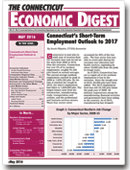 |
 |
May 2016 Connecticut Economic Digest |
 |
Connecticut's Short-Term Employment Outlook to 2017
By Sarah Pilipaitis, Economist, Department of Labor
 onnecticut is now into its sixth year of recovery from the recession that took its toll on the state from 2008 to 2010. Over the recession, Connecticut lost over 5% of its nonfarm employment, roughly 91,100 jobs based on annual averages. The annual average nonfarm employment reached its peak in 2008 at 1,699,100 jobs. By the time it reached the trough in 2010, the state's employment had fallen to 1,608,000 jobs. The largest losses came from the construction, manufacturing, trade, transportation and utilities, and the professional and business services sectors. Those four sectors alone accounted for 80% of the lost jobs. The lone sector that was able to create jobs during the recession was education and health services, expanding by about 10,000 jobs from the peak to trough years. [ read more ] onnecticut is now into its sixth year of recovery from the recession that took its toll on the state from 2008 to 2010. Over the recession, Connecticut lost over 5% of its nonfarm employment, roughly 91,100 jobs based on annual averages. The annual average nonfarm employment reached its peak in 2008 at 1,699,100 jobs. By the time it reached the trough in 2010, the state's employment had fallen to 1,608,000 jobs. The largest losses came from the construction, manufacturing, trade, transportation and utilities, and the professional and business services sectors. Those four sectors alone accounted for 80% of the lost jobs. The lone sector that was able to create jobs during the recession was education and health services, expanding by about 10,000 jobs from the peak to trough years. [ read more ]
|
 |
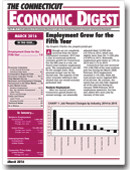 |
 |
March 2016 Connecticut Economic Digest |
 |
Employment Grew for the Fifth Year
By Jungmin Charles Joo, Department of Labor
 lthough not yet completely recovered from the latest employment recession, 2015 was a year of continued moderate economic growth for Connecticut. For the fifth year in a row, our State's total nonfarm employment grew. The unemployment rate fell for five straight years. Real personal income rose for the second year. The majority of the other economic indicators also showed that our overall economy performed well. lthough not yet completely recovered from the latest employment recession, 2015 was a year of continued moderate economic growth for Connecticut. For the fifth year in a row, our State's total nonfarm employment grew. The unemployment rate fell for five straight years. Real personal income rose for the second year. The majority of the other economic indicators also showed that our overall economy performed well.
Nonfarm Employment
After our annual revision, Connecticut gained (based on annual average, not seasonally adjusted data) 12,500 jobs (+0.75%) in 2015, which was slightly more than the 11,400 jobs (+0.69%) in 2014. Nationally, employment grew faster at 1.9% in 2014 and 2.1% in 2015. Connecticut has now recovered 73% (+86,700) of the total nonfarm jobs lost during the March 2008-February 2010 employment recession (-119,100), while the total private sector regained 86% of its job loss. By contrast, the nation has not only fully regained all of the jobs lost during its January 2008-February 2010 employment downturn, but has also added 56% more jobs by January of this year. [ read more ]
|
 |
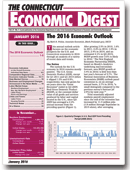 |
 |
January 2016 Connecticut Economic Digest |
 |
The 2016 Economic Outlook
By Mark Prisloe, Associate Economist, Department of Economic and Community Development
 his annual outlook article focuses on the economic prospects for the U.S. and Connecticut economies in 2016 through an analysis of a variety of recent data and trends. his annual outlook article focuses on the economic prospects for the U.S. and Connecticut economies in 2016 through an analysis of a variety of recent data and trends.
The Nation
The outlook for the U.S. economy in 2016 remains mostly positive. The U.S. Gross Domestic Product (GDP), except for Q1-2011 and Q1-2014 (when it slipped 1.5% and 0.9%, respectively), has now grown for six years since the “Great Recession” ended in Q2-2009. Real Gross Domestic Product (RGDP), or the constant dollar value of all goods and services produced by labor and capital located in the U.S., since Q2-2009 has averaged a 2.2% annual increase from the preceding quarter (Figure 1).
After growing 2.5% in 2010, 1.6% in 2011, 2.2% in 2012, 1.5% in 2013, 2.4% in 2014, and an estimated 2.1% in Q3-2015, RGDP growth near 3.0% is likely in 2016. The New England Economic Partnership (NEEP), based on Moody’s Analytics underlying macroeconomic forecast, sees RGDP growth at 3.4% in 2016, a little less than last year’s forecast of 3.7%. The National Association of Business Economists (NABE) outlook panel consensus is, on an average annual basis, 2.7% in 2016, “a small downgrade compared to the previous survey’s forecast [of 2.9%] for next year.” [ read more ]
|
 |
 |
 |
|
 |
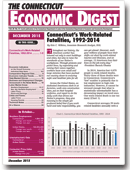 |
 |
December 2015 Connecticut Economic Digest |
 |
Connecticut’s Work-Related Fatalities, 1992-2014
By Erin C. Wilkins, Associate Research Analyst, Department of Labor
 hroughout our history, the American worker has labored not only to erect buildings and cities, but also to raise the standards of our Nation’s workplaces. Through protests and picket lines, by organizing and raising their voices together, workers have won small and large victories that have pushed our country closer to ensuring safer and healthier jobs for all. hroughout our history, the American worker has labored not only to erect buildings and cities, but also to raise the standards of our Nation’s workplaces. Through protests and picket lines, by organizing and raising their voices together, workers have won small and large victories that have pushed our country closer to ensuring safer and healthier jobs for all.
Across the United States, as dedicated Americans clock in at factories, walk onto construction sites, put on their hospital uniforms, and report to do the daily work that drives our Nation’s progress, they give meaning to the simple yet profound belief that if you work hard and take responsibility, you can get ahead. However, each year millions of people have their shifts cut short by work-related injuries and illnesses, and on average, 12 Americans lose their lives on the job every day.” - President Barack Obama
In 2014, America lost 4,679 people to work-related deaths. Thirty-three of those deaths were in Connecticut. Connecticut’s “low” number is primarily due to low employment in high-risk industries. However, it cannot be stressed enough that what is statistically unremarkable has a devastating impact on loved ones. One work-related death is one too many. [ read more ] |
 |
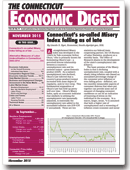 |
 |
November 2015 Connecticut Economic Digest |
 |
Connecticut's so-called Misery Index Falling as of Late
By Lincoln S. Dyer, Economist, Department of Labor
 straight forward Misery Index was developed in the 1960’s by Yale economist Arthur Okun, who is primarily known for formulating Okun’s Law – a perceived inverse relationship between a country’s unemployment rate and its national output – gross domestic product (GDP). As a nation’s unemployment rate declined, Okun’s Law inferred that a country’s gross product/output increased with some degree of regularity, and/or vice versa. This fundamental supposition of Okun’s Law has held up pretty well over time. Okun’s Misery Index, aptly an economic indicator that similarly is utilizing the unemployment rate (seasonally adjusted), is essentially the unemployment rate added to the annualized inflation rate (UR+CPI U annualized). These are two statistics our federal/state cooperating partner, the US Bureau of Labor Statistics, produces on a monthly basis. The Office of Research shares in the development of the state’s unemployment rate. [ read more ] straight forward Misery Index was developed in the 1960’s by Yale economist Arthur Okun, who is primarily known for formulating Okun’s Law – a perceived inverse relationship between a country’s unemployment rate and its national output – gross domestic product (GDP). As a nation’s unemployment rate declined, Okun’s Law inferred that a country’s gross product/output increased with some degree of regularity, and/or vice versa. This fundamental supposition of Okun’s Law has held up pretty well over time. Okun’s Misery Index, aptly an economic indicator that similarly is utilizing the unemployment rate (seasonally adjusted), is essentially the unemployment rate added to the annualized inflation rate (UR+CPI U annualized). These are two statistics our federal/state cooperating partner, the US Bureau of Labor Statistics, produces on a monthly basis. The Office of Research shares in the development of the state’s unemployment rate. [ read more ]
Alternative Measures of Labor Underutilization in Connecticut, 2003-2014
By Jungmin Charles Joo and Sarah Pilipaitis, Department of Labor
 n addition to the official unemployment rate, the Connecticut Economic Digest has been publishing the “U-6 rate” each quarter on page 6 under the “Unemployment” table. As introduced in the February 2010 issue (page 3), there are six alternative measures of labor underutilization produced by the U.S. Bureau of Labor Statistics (BLS), of which U-6 is the broadest measure, capturing not only the “official” unemployed, but also workers employed part-time for economic reasons, and those marginally attached to the labor force. [ read more ] n addition to the official unemployment rate, the Connecticut Economic Digest has been publishing the “U-6 rate” each quarter on page 6 under the “Unemployment” table. As introduced in the February 2010 issue (page 3), there are six alternative measures of labor underutilization produced by the U.S. Bureau of Labor Statistics (BLS), of which U-6 is the broadest measure, capturing not only the “official” unemployed, but also workers employed part-time for economic reasons, and those marginally attached to the labor force. [ read more ]
|
 |
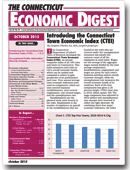 |
 |
October 2015 Connecticut Economic Digest |
 |
Introducing the Connecticut Town Economic Index (CTEI)
By Jungmin Charles Joo, Department of Labor
 he Connecticut Department of Labor’s Office of Research developed the Connecticut Town Economic Index (CTEI), an annual composite index of all 169 cities and towns in Connecticut. This index measures each town or city’s overall economic health, which can be ranked and compared to others to gain perspective of its performance each year. Four annual average town economic indicators were used as components, which are total covered business establishments, total covered employment, real covered wages, and the unemployment rate. [ read more ] he Connecticut Department of Labor’s Office of Research developed the Connecticut Town Economic Index (CTEI), an annual composite index of all 169 cities and towns in Connecticut. This index measures each town or city’s overall economic health, which can be ranked and compared to others to gain perspective of its performance each year. Four annual average town economic indicators were used as components, which are total covered business establishments, total covered employment, real covered wages, and the unemployment rate. [ read more ]
Occupational Profile: Information Security Analysts
By Sarah Pilipaitis, Economist, Department of Labor
 nformation security analysts plan, implement, upgrade, or monitor security measures for the protection of computer networks and information. They may ensure appropriate security controls are in place that will safeguard digital files and vital electronic infrastructure. Additionally, information security analysts may respond to computer security breaches and viruses. [ read more ] nformation security analysts plan, implement, upgrade, or monitor security measures for the protection of computer networks and information. They may ensure appropriate security controls are in place that will safeguard digital files and vital electronic infrastructure. Additionally, information security analysts may respond to computer security breaches and viruses. [ read more ]
|
 |
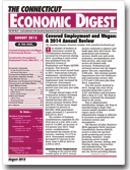 |
 |
August 2015 Connecticut Economic Digest |
 |
Covered Employment and Wages: A 2014 Annual Review
By Jonathan Kuchta, Research Analyst, Department of Labor
 he number of workers in Connecticut covered by Unemployment Insurance (UI) increased by 0.8 percent during 2014, according to most recent data published from the Quarterly Census of Employment and Wages (QCEW) program. This increase continues the trend started back in 2011. Total private industry employment, constituting 85.7 percent of the State’s covered employment total, increased by 0.9 percent. Government employment increased by 0.3 percent year-over-year. [ read more ] he number of workers in Connecticut covered by Unemployment Insurance (UI) increased by 0.8 percent during 2014, according to most recent data published from the Quarterly Census of Employment and Wages (QCEW) program. This increase continues the trend started back in 2011. Total private industry employment, constituting 85.7 percent of the State’s covered employment total, increased by 0.9 percent. Government employment increased by 0.3 percent year-over-year. [ read more ]
Construction Occupational Employment Trend, 2005-2013
By Matthew Krzyzek, Economist, Department of Labor
 he bursting of the housing bubble hit certain areas of the economy harder than others. Though Connecticut was not an epicenter of the housing bubble and bust, its impact can be seen when examining construction occupational employment. This article uses data from the Census Bureau’s American Community Survey (ACS) as it provides estimates of labor market variables not captured in other datasets, including unemployment by occupation and prior occupation of those not in the labor force. From this we can get a generalized idea of how construction occupations in Connecticut have fared during the recession and recovery. [ read more ] he bursting of the housing bubble hit certain areas of the economy harder than others. Though Connecticut was not an epicenter of the housing bubble and bust, its impact can be seen when examining construction occupational employment. This article uses data from the Census Bureau’s American Community Survey (ACS) as it provides estimates of labor market variables not captured in other datasets, including unemployment by occupation and prior occupation of those not in the labor force. From this we can get a generalized idea of how construction occupations in Connecticut have fared during the recession and recovery. [ read more ]
|
 |
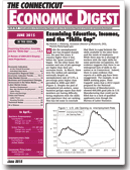 |
 |
June 2015 Connecticut Economic Digest |
 |
Examining Education, Incomes, and the "Skills Gap"
By Patrick.Flaherty, Assistant Director of Research, Department of Labor
 hile the unemployment rate has dropped sharply over the past few years, it remains higher than it was before the “great recession” began. On the other hand, the number and rate of job openings are higher than their prerecession levels. In March, there were five million job openings nationally despite an unemployment rate of 5.4%, a percentage point higher than prevailed in 2006 and 2007. Despite the pool of unemployed job-seekers, some business groups report that their members are having difficulty hiring employees with the skills and experience they are seeking. This has led some to conclude that there is a gap between the skills available in the labor force and the needs of employers. [ read more ] hile the unemployment rate has dropped sharply over the past few years, it remains higher than it was before the “great recession” began. On the other hand, the number and rate of job openings are higher than their prerecession levels. In March, there were five million job openings nationally despite an unemployment rate of 5.4%, a percentage point higher than prevailed in 2006 and 2007. Despite the pool of unemployed job-seekers, some business groups report that their members are having difficulty hiring employees with the skills and experience they are seeking. This has led some to conclude that there is a gap between the skills available in the labor force and the needs of employers. [ read more ]
A Review of 2004-2014 Employment Projections
By Michael Fitzgerald, Research Analyst, Department of Labor
 t will be years—not in my time—before a woman will become Prime Minister.” That’s a quote made by Margaret Thatcher in 1969, ten years before she took over as Prime Minister of the United Kingdom in 1979. In other words, projections—especially 10 years ahead of time—are difficult. Every two years, the Office of Research at the Connecticut Department of Labor creates 10-year employment projections for the state. Now that employment statistics for 2014 have been released, we are going to take a look at the 2004-2014 projections and see how well the projections fared. Statewide numbers for the Major Standard Occupational Classification (SOC) groupings and Occupation Employment Statistics data from 2014 will be what is focused on. There are a couple of things to bear in mind when looking at the original projections. [ read more ] t will be years—not in my time—before a woman will become Prime Minister.” That’s a quote made by Margaret Thatcher in 1969, ten years before she took over as Prime Minister of the United Kingdom in 1979. In other words, projections—especially 10 years ahead of time—are difficult. Every two years, the Office of Research at the Connecticut Department of Labor creates 10-year employment projections for the state. Now that employment statistics for 2014 have been released, we are going to take a look at the 2004-2014 projections and see how well the projections fared. Statewide numbers for the Major Standard Occupational Classification (SOC) groupings and Occupation Employment Statistics data from 2014 will be what is focused on. There are a couple of things to bear in mind when looking at the original projections. [ read more ]
|
 |
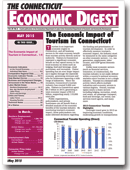 |
 |
May 2015 Connecticut Economic Digest |
 |
The Economic Impact of Tourism in Connecticut
Tourism Economics - Connecticut Department of Economic and Community Development.
 ourism is an important economic engine in Connecticut, and all business sectors in the state economy benefit from tourism activity directly and/or indirectly. Visitors to Connecticut represent a significant economic benefit as they spend money in the local economy on items such as lodging, food and beverage, retail purchases, and recreation. Visitor spending has an even larger impact as it ripples through the statewide economy, generating revenues and jobs for businesses spanning a wide range of industries. Since the recession, Connecticut’s tourism industry has created 5,000 new jobs. Visitors to Connecticut spent $8.3 billion in 2013, generating a total economic impact of $14.0 billion, supporting nearly 119,000 total jobs. [ read more ] ourism is an important economic engine in Connecticut, and all business sectors in the state economy benefit from tourism activity directly and/or indirectly. Visitors to Connecticut represent a significant economic benefit as they spend money in the local economy on items such as lodging, food and beverage, retail purchases, and recreation. Visitor spending has an even larger impact as it ripples through the statewide economy, generating revenues and jobs for businesses spanning a wide range of industries. Since the recession, Connecticut’s tourism industry has created 5,000 new jobs. Visitors to Connecticut spent $8.3 billion in 2013, generating a total economic impact of $14.0 billion, supporting nearly 119,000 total jobs. [ read more ]
|
 |
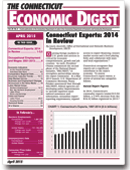 |
 |
April 2015 Connecticut Economic Digest |
 |
Connecticut Exports: 2014 in Review
By Laura Jaworski, Office of International and Domestic Affairs, Department of Economic and Community Development
 pening foreign markets to U.S. goods and services is critical for economic competitiveness, growth and job creation. As such, President Obama commenced the second phase of the National Export Initiative, “NEI/NEXT,” to strengthen partnerships among the export community. At a May 2014 launch, U.S. Department of Commerce Secretary Penny Pritzker announced that through NEI/NEXT, federal agencies are developing policy improvements to “provide exporters more tailored assistance and information; streamline export reporting requirements; expand access to export financing; ensure market access and a level playing field; and collaborate with state and local organizations.” [ read more ] pening foreign markets to U.S. goods and services is critical for economic competitiveness, growth and job creation. As such, President Obama commenced the second phase of the National Export Initiative, “NEI/NEXT,” to strengthen partnerships among the export community. At a May 2014 launch, U.S. Department of Commerce Secretary Penny Pritzker announced that through NEI/NEXT, federal agencies are developing policy improvements to “provide exporters more tailored assistance and information; streamline export reporting requirements; expand access to export financing; ensure market access and a level playing field; and collaborate with state and local organizations.” [ read more ]
Occupational Employment and Wages: 2001-2013
By Matthew Krzyzek, Economist, Department of Labor
 ccupational Employment Statistics (OEWS) estimates employer survey information into detailed wage data for 821 occupations that comprise 22 major categories. Extensive occupational earnings data make the survey useful to both employers and employees. This article utilizes data from 2001, 2004, 2007, 2010, and 2013 to account for the 3-year OEWS survey cycle. Data is examined mostly at 2-digit Standard Occupational Classification (SOC) level but also dives deeper into 6 digit levels to explain broader changes. [ read more ] ccupational Employment Statistics (OEWS) estimates employer survey information into detailed wage data for 821 occupations that comprise 22 major categories. Extensive occupational earnings data make the survey useful to both employers and employees. This article utilizes data from 2001, 2004, 2007, 2010, and 2013 to account for the 3-year OEWS survey cycle. Data is examined mostly at 2-digit Standard Occupational Classification (SOC) level but also dives deeper into 6 digit levels to explain broader changes. [ read more ]
|
 |
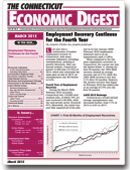 |
 |
March 2015 Connecticut Economic Digest |
 |
Employment Recovery Continues for the Fourth Year
By Jungmin Charles Joo, Department of Labor
 ast year was a continuation of modest employment recovery in Connecticut, with many economic indicators, including unemployment, pointing to positive directions. After our annual revision, Connecticut gained 12,500 jobs (+0.76%) in 2014, which was essentially the same pace as was in 2013, as unemployment rate fell further to 6.6%. ast year was a continuation of modest employment recovery in Connecticut, with many economic indicators, including unemployment, pointing to positive directions. After our annual revision, Connecticut gained 12,500 jobs (+0.76%) in 2014, which was essentially the same pace as was in 2013, as unemployment rate fell further to 6.6%.
Fourth Year of Employment Recovery
During the March 2008-February 2010 recession, Connecticut lost 119,000 total nonfarm jobs, of which 76% are now recovered (+90,500), while the total private sector recovered 87%. Meanwhile, the nation has now fully regained all of the jobs lost in its last January 2008-February 2010 employment downturn and is on an expansionary path (+128%). [ read more ] |
 |
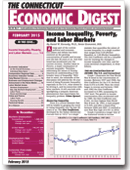 |
 |
February 2015 Connecticut Economic Digest |
 |
Income Inequality, Poverty, and Labor Markets
By Daniel W. Kennedy, Ph.D., Senior Economist, Department of Labor
 large part of the current political and economic discussion and debate has been centered on the growing concentration of wealth and income over the last 30 years or so. And this trend has accelerated over the current recovery. Another issue is Poverty, a major consequence of extreme inequality. Therefore, addressing the issues of Poverty requires an understanding of the broader issue of Inequality. With that in mind, the remainder of the discussion will address the 30-year trend of rising Economic Inequality, especially in the U.S., what seems to be driving it, and its connection with labor markets. It will conclude with spotlighting a uniquely American phenomenon that exacerbates the inequality problem: Urban Sprawl. [ read more ] large part of the current political and economic discussion and debate has been centered on the growing concentration of wealth and income over the last 30 years or so. And this trend has accelerated over the current recovery. Another issue is Poverty, a major consequence of extreme inequality. Therefore, addressing the issues of Poverty requires an understanding of the broader issue of Inequality. With that in mind, the remainder of the discussion will address the 30-year trend of rising Economic Inequality, especially in the U.S., what seems to be driving it, and its connection with labor markets. It will conclude with spotlighting a uniquely American phenomenon that exacerbates the inequality problem: Urban Sprawl. [ read more ]
|
 |
 |
 |
|
 |
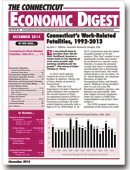 |
 |
December 2014 Connecticut Economic Digest |
 |
Connecticut’s Work-Related Fatalities, 1992-2013
By Erin C. Wilkins, Associate Research Analyst, Department of Labor
 o one should have to sacrifice their life for their livelihood, because a nation built on the dignity of work must provide safe working conditions for its people.” –Secretary of Labor Thomas E. Perez In 2013, work injuries claimed the lives of 4,405 workers in America. Twenty-six of those deaths occurred in Connecticut. o one should have to sacrifice their life for their livelihood, because a nation built on the dignity of work must provide safe working conditions for its people.” –Secretary of Labor Thomas E. Perez In 2013, work injuries claimed the lives of 4,405 workers in America. Twenty-six of those deaths occurred in Connecticut.
Since 1992, the U.S. Department of Labor’s Bureau of Labor Statistics has conducted the annual Census of Fatal Occupational Injuries (CFOI) to document workplace fatalities. Connecticut averages 39 workrelated fatalities annually with a high of 57 in 1998. In 2013, Connecticut saw the lowest recorded number of 26 lost workers. This “low” number is not statistically notable and cannot be attributed to a specific cause. However, it cannot be stressed enough that what is statistically unremarkable has a devastating impact on loved ones. One workrelated death is one too many. As Dr. David Michaels, the Assistant Secretary of Labor for Occupational Safety and Health, states, “Making a living shouldn’t have to cost you your life. Workplace fatalities, injuries, and illnesses are preventable. Safe jobs happen because employers make the choice to fulfill their responsibilities and protect their workers.” [ read more ] |
 |
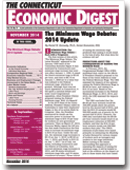 |
 |
November 2014 Connecticut Economic Digest |
 |
The Minimum Wage Debate: 2014 Update
By Daniel W. Kennedy, Ph.D., Senior Economist, Department of Labor
 NTRODUCTION: The Minimum Wage Debate — Back with a Vengeance The first version of this article, “The Minimum Wage Debate: The Latest Rounds”, appeared in the January 1999 issue of the Connecticut Economic Digest. It was motivated by Connecticut’s new minimum-wage increase that went into effect January 1, 1999. It raised the State’s minimum wage to $5.65 per hour, and then to $6.15 on January 1, 2000 (or to a value that was indexed to the Federal minimum wage, whichever is greater). Although there was not much opposition in Connecticut, it did spark a national debate and some vocal Congressional opposition, when President Clinton proposed raising the Federal minimum wage. Well, it’s Baaack! [ read more ] NTRODUCTION: The Minimum Wage Debate — Back with a Vengeance The first version of this article, “The Minimum Wage Debate: The Latest Rounds”, appeared in the January 1999 issue of the Connecticut Economic Digest. It was motivated by Connecticut’s new minimum-wage increase that went into effect January 1, 1999. It raised the State’s minimum wage to $5.65 per hour, and then to $6.15 on January 1, 2000 (or to a value that was indexed to the Federal minimum wage, whichever is greater). Although there was not much opposition in Connecticut, it did spark a national debate and some vocal Congressional opposition, when President Clinton proposed raising the Federal minimum wage. Well, it’s Baaack! [ read more ]
|
 |
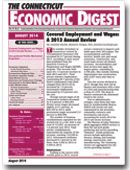 |
 |
August 2014 Connecticut Economic Digest |
 |
Covered Employment and Wages: A 2013 Annual Review.
By Jonathan Kuchta, Research Analyst, Department of Labor
 he number of workers in Connecticut covered by Unemployment Insurance (UI)increased by 0.7 percent during 2013, according to most recent data published from the Quarterly Census of Employment and Wages (QCEW) program. This increase built upon the 1.0 percent increase in both 2012 and 2011. Total private industry employment, constituting 85.7 percent of the State’s employment total [little changed from 2012’s 85.5], increased by 1.0 percent. Government employment decreased by 0.5 percent over the year. [ read more ] he number of workers in Connecticut covered by Unemployment Insurance (UI)increased by 0.7 percent during 2013, according to most recent data published from the Quarterly Census of Employment and Wages (QCEW) program. This increase built upon the 1.0 percent increase in both 2012 and 2011. Total private industry employment, constituting 85.7 percent of the State’s employment total [little changed from 2012’s 85.5], increased by 1.0 percent. Government employment decreased by 0.5 percent over the year. [ read more ]
Occupational Profile: Mechanical Engineers.
By Michael Fitzgerald, Research Analyst, Department of Labor
 echanical Engineers work in a variety of industries developing, building and testing mechanical and thermal devices, including tools, engines and other machines. Mechanical Engineers typically work in an office environment but occasionally travel into the field to inspect or fix equipment. They need at least a bachelor’s degree and a graduate degree may be required for management. Mechanical Engineers must be licensed if they sell their services publicly. (Occupational Outlook Handbook) [ read more ] echanical Engineers work in a variety of industries developing, building and testing mechanical and thermal devices, including tools, engines and other machines. Mechanical Engineers typically work in an office environment but occasionally travel into the field to inspect or fix equipment. They need at least a bachelor’s degree and a graduate degree may be required for management. Mechanical Engineers must be licensed if they sell their services publicly. (Occupational Outlook Handbook) [ read more ]
|
 |
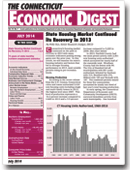 |
 |
July 2014 Connecticut Economic Digest |
 |
State Housing Market Continued its Recovery in 2013.
By Kolie Sun, Senior Research Analyst, Department of Economic and Community Development
 onnecticut’s housing market continued on the path to recovery in 2013 with many economic indicators posting strong gains over the prior year. In this article, we will examine the state’s housing industry and factors that led to stronger housing performance in 2013, most notably permits rising to pre-recession levels. [ read more ] onnecticut’s housing market continued on the path to recovery in 2013 with many economic indicators posting strong gains over the prior year. In this article, we will examine the state’s housing industry and factors that led to stronger housing performance in 2013, most notably permits rising to pre-recession levels. [ read more ]
75 years of state monthly nonfarm employment statistics.
By Lincoln S. Dyer, Economist, Department of Labor
 n the beginning tate and national nonfarm industry employment statistics officially begin their time-series in 1939 just before the start of World War II. More expanded reports on state and national employment, however, were already being called for by the late 1800’s because of rapid industrialization, and during the Great Depression for more national economic planning to emerge from that lasting downturn. By 1940, the U.S. Bureau of Labor Statistics (BLS) moved to consolidate much of the work already being performed by federal statistical agencies, cooperating state research bureaus, and statistical and industrial societies for war planning purposes before WWII and began producing a national nonagricultural employment series for all 48 states, just as the US was preparing for war. This may have facilitated the redirection and awareness of industrial planning during and after the second world war across the country especially as the GI’s returned home looking for jobs – ready with pent-up demand. (Most of the state data development, firm sampling, and nonfarm employment estimation work were performed in each individual state from about 1947 until recently – 2011. States still are a big part of the process.) [ read more ] n the beginning tate and national nonfarm industry employment statistics officially begin their time-series in 1939 just before the start of World War II. More expanded reports on state and national employment, however, were already being called for by the late 1800’s because of rapid industrialization, and during the Great Depression for more national economic planning to emerge from that lasting downturn. By 1940, the U.S. Bureau of Labor Statistics (BLS) moved to consolidate much of the work already being performed by federal statistical agencies, cooperating state research bureaus, and statistical and industrial societies for war planning purposes before WWII and began producing a national nonagricultural employment series for all 48 states, just as the US was preparing for war. This may have facilitated the redirection and awareness of industrial planning during and after the second world war across the country especially as the GI’s returned home looking for jobs – ready with pent-up demand. (Most of the state data development, firm sampling, and nonfarm employment estimation work were performed in each individual state from about 1947 until recently – 2011. States still are a big part of the process.) [ read more ]
|
 |
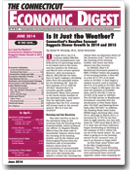 |
 |
June 2014 Connecticut Economic Digest |
 |
Is It Just the Weather? Connecticut's Baseline Forecast Suggests Slower Growth in 2014 and 2015
By Daniel W. Kennedy, Ph.D., Senior Economist, Department of Labor
 n April 2014, the U.S. economy added 288,000 jobs and the unemployment rate (UR) fell by 0.4 percentage points, to its lowest level in five years, and the numbers for February and March were revised upward. However, after increasing in March, 806,000 left the labor force in April, making a shrinking labor force the principal reason for the declining UR. And the first estimate of U.S. GDP for 2014Q12 showed that U.S. economic growth rapidly decelerated. Many have pointed to the harsh winter weather as the principal culprit, and expect that the April jobs report indicates that the U.S. economy will bounce back in the second quarter. But is it just the weather? [ read more ] n April 2014, the U.S. economy added 288,000 jobs and the unemployment rate (UR) fell by 0.4 percentage points, to its lowest level in five years, and the numbers for February and March were revised upward. However, after increasing in March, 806,000 left the labor force in April, making a shrinking labor force the principal reason for the declining UR. And the first estimate of U.S. GDP for 2014Q12 showed that U.S. economic growth rapidly decelerated. Many have pointed to the harsh winter weather as the principal culprit, and expect that the April jobs report indicates that the U.S. economy will bounce back in the second quarter. But is it just the weather? [ read more ]
|
 |
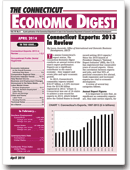 |
 |
April 2014 Connecticut Economic Digest |
 |
Connecticut Exports: 2013 in Review
By Laura Jaworski, Office of International and Domestic Affairs, Department of Economic and Community Development
 o assess Connecticut’s export status, The Connecticut Economic Digest conducts an annual review of the state’s export performance. Exports are a significant contributor to the state’s economy - they support and create jobs and spur economic growth. In 2013, Connecticut’s commodity exports totaled $16.47 billion, a 3.23% increase from the $15.96 billion registered in 2012. Connecticut was one of 16 states to achieve a new record for exports in 2013, which helped drive the United States to overall record-setting 2013 exports. Since the 2010 launch of President Obama’s “National Export Initiative” (NEI), the U.S. has experienced four consecutive years of record exports. Given the correlation between exports and jobs, and that 95% of potential consumers live abroad, trade expansion and increased exports are vital to economic development. [ read more ] o assess Connecticut’s export status, The Connecticut Economic Digest conducts an annual review of the state’s export performance. Exports are a significant contributor to the state’s economy - they support and create jobs and spur economic growth. In 2013, Connecticut’s commodity exports totaled $16.47 billion, a 3.23% increase from the $15.96 billion registered in 2012. Connecticut was one of 16 states to achieve a new record for exports in 2013, which helped drive the United States to overall record-setting 2013 exports. Since the 2010 launch of President Obama’s “National Export Initiative” (NEI), the U.S. has experienced four consecutive years of record exports. Given the correlation between exports and jobs, and that 95% of potential consumers live abroad, trade expansion and increased exports are vital to economic development. [ read more ]
Occupational Profile: Dentist Hygienists
By Lisa D’Acunto, Research Analyst, Department of Labor
 ental hygienists clean teeth, examine patients for signs of oral diseases such as gingivitis, take x-rays, and provide other preventative dental care. They remove tartar and plaque and apply sealants and fluorides to help protect teeth. Educating patients on ways to improve and maintain good oral health is also an important part of this profession. Dental hygienists typically need an associate’s degree in dental hygiene. Bachelor’s degrees in dental hygiene are also available, but are less common. A bachelor’s or master’s degree is usually required for research, teaching, or clinical practice in public or school health programs. Every state requires dental hygienists to be licensed; requirements vary by state. Licensure requirements in most states include a degree from an accredited dental hygiene program and passing grades on written and practical examinations. [ read more ] ental hygienists clean teeth, examine patients for signs of oral diseases such as gingivitis, take x-rays, and provide other preventative dental care. They remove tartar and plaque and apply sealants and fluorides to help protect teeth. Educating patients on ways to improve and maintain good oral health is also an important part of this profession. Dental hygienists typically need an associate’s degree in dental hygiene. Bachelor’s degrees in dental hygiene are also available, but are less common. A bachelor’s or master’s degree is usually required for research, teaching, or clinical practice in public or school health programs. Every state requires dental hygienists to be licensed; requirements vary by state. Licensure requirements in most states include a degree from an accredited dental hygiene program and passing grades on written and practical examinations. [ read more ]
|
 |
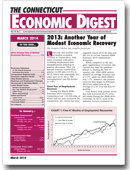 |
 |
March 2014 Connecticut Economic Digest |
 |
2013: Another Year of Modest Economic Recovery
By Jungmin Charles Joo, Department of Labor
 ast year was another year of modest economic recovery in Connecticut, with many economic indicators, including employment and unemployment, pointing in positive directions. After our annual revision, Connecticut gained 14,300 jobs (+0.9%) in 2013, which was essentially the same pace as in 2012. The unemployment rate fell further to 7.8%. ast year was another year of modest economic recovery in Connecticut, with many economic indicators, including employment and unemployment, pointing in positive directions. After our annual revision, Connecticut gained 14,300 jobs (+0.9%) in 2013, which was essentially the same pace as in 2012. The unemployment rate fell further to 7.8%.
During the March 2008-February 2010 recession, Connecticut lost 119,100 jobs, of which half are now recovered. By comparison, the nation has now regained nearly all of the jobs lost (90.1%) in its last January 2008-February 2010 employment downturn. [ read more ]
|
 |
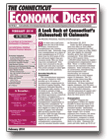 |
 |
February 2014 Connecticut Economic Digest |
 |
A Look Back at Connecticut's (Exhausted) UI Claimants
By Manisha Srivastava
 ver three and a half years since the end of the Great Recession, Connecticut’s unemployment rate remains persistently high. Nationally, long term unemployment as a share of total unemployment at 37.3% is down from its 2010 peak of 45%, but still much higher than prerecession levels. Who are these long-term unemployed? How many have returned to the job market and with what success? This article attempts to shed light on these and other questions. [ read more ] ver three and a half years since the end of the Great Recession, Connecticut’s unemployment rate remains persistently high. Nationally, long term unemployment as a share of total unemployment at 37.3% is down from its 2010 peak of 45%, but still much higher than prerecession levels. Who are these long-term unemployed? How many have returned to the job market and with what success? This article attempts to shed light on these and other questions. [ read more ]
Occupational Profile: Personal Financial Advisors
By Linda Mothersele, Research Analyst, Department of Labor
 ersonal financial advisors give financial advice to people. They help with investments, taxes, and insurance decisions. A bachelor’s degree is required for an entry level position, but a master’s degree and certification increases chances for advancement and a higher level of pay. While most financial advisors work out of an office, nearly 25 percent of personal financial advisors were self employed in 2010. Their schedules often involve evening or weekend meetings with clients. They may also attend conferences and conduct classes in financial planning. With a high percentage of baby boomers nearing retirement there is a strong demand for this type of service. People are having to take more responsibility for their own financial planning as the funding for pensions has decreased, thus increasing the need for this type of service. [ read more ] ersonal financial advisors give financial advice to people. They help with investments, taxes, and insurance decisions. A bachelor’s degree is required for an entry level position, but a master’s degree and certification increases chances for advancement and a higher level of pay. While most financial advisors work out of an office, nearly 25 percent of personal financial advisors were self employed in 2010. Their schedules often involve evening or weekend meetings with clients. They may also attend conferences and conduct classes in financial planning. With a high percentage of baby boomers nearing retirement there is a strong demand for this type of service. People are having to take more responsibility for their own financial planning as the funding for pensions has decreased, thus increasing the need for this type of service. [ read more ]
|
 |
 |
 |
|
 |
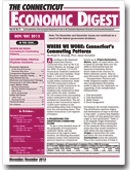 |
 |
November / December 2013 Connecticut Economic Digest
Note: The November and December issues are combined as a result of the federal government shutdown. |
 |
WHERE WE WORK: Connecticut's Commuting Patterns
By Daniel W. Kennedy, Ph.D., Senior Economist, Department of Labor
 ccording to the American Community Survey conducted every year by the U.S. Census Bureau, on average, over the 2006-10 period, 1,713,272 Connecticut residents commuted to their jobs every workday. From Table 1, 1,618,120 of those Connecticut residents commuted to jobs within Connecticut, while 107,976 commuted to jobs at worksites outside Connecticut. In addition to the Connecticut residents who commuted to their jobs within the state, another 95,152 workers from surrounding states commuted to their jobs at worksites in Connecticut. The net result is that Connecticut exports 12,824 more workers to the surrounding states than it imports form the surrounding states. That makes Connecticut a net exporter of workers. [ read more ] ccording to the American Community Survey conducted every year by the U.S. Census Bureau, on average, over the 2006-10 period, 1,713,272 Connecticut residents commuted to their jobs every workday. From Table 1, 1,618,120 of those Connecticut residents commuted to jobs within Connecticut, while 107,976 commuted to jobs at worksites outside Connecticut. In addition to the Connecticut residents who commuted to their jobs within the state, another 95,152 workers from surrounding states commuted to their jobs at worksites in Connecticut. The net result is that Connecticut exports 12,824 more workers to the surrounding states than it imports form the surrounding states. That makes Connecticut a net exporter of workers. [ read more ]
OCCUPATIONAL PROFILE: Physician Assistants
By Michael Polzella, Associate Research Analyst, Department of Labor
 hysician assistants, also known as PAs, practice medicine under the direction of physicians and surgeons. They are formally trained to examine patients, diagnose injuries and illnesses, and provide treatment. According to the American Academy of Physician Assistants, the Physician Assistant (PA) profession was created to improve and expand healthcare. “In the mid-1960s, physicians and educators recognized there was a shortage of primary care physicians. To remedy this, Eugene A. Stead Jr., MD, of the Duke University Medical Center put together the first class of PAs in 1965. He selected Navy corpsmen who had received considerable medical training during their military service and based the curriculum on his knowledge of the fast-track training of doctors during World War II." [ read more ] hysician assistants, also known as PAs, practice medicine under the direction of physicians and surgeons. They are formally trained to examine patients, diagnose injuries and illnesses, and provide treatment. According to the American Academy of Physician Assistants, the Physician Assistant (PA) profession was created to improve and expand healthcare. “In the mid-1960s, physicians and educators recognized there was a shortage of primary care physicians. To remedy this, Eugene A. Stead Jr., MD, of the Duke University Medical Center put together the first class of PAs in 1965. He selected Navy corpsmen who had received considerable medical training during their military service and based the curriculum on his knowledge of the fast-track training of doctors during World War II." [ read more ]
|
 |
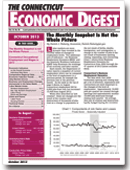 |
 |
October 2013 Connecticut Economic Digest |
 |
The Monthly Snapshot Is Not the Whole Picture
By Patrick.Flaherty, Economist, Department of Labor
 abor markets are more dynamic than revealed in the monthly tallies of changes in employment levels. Two additional sets of indicators – the Business Employment Dynamics (BED)1 and the Quarterly Workforce Indicators (QWI)2 help illuminate the workings of the economy and labor market. abor markets are more dynamic than revealed in the monthly tallies of changes in employment levels. Two additional sets of indicators – the Business Employment Dynamics (BED)1 and the Quarterly Workforce Indicators (QWI)2 help illuminate the workings of the economy and labor market.
Each month, the Department of Labor reports a snapshot of current employment which can be compared to the level of employment in a previous period, for example the previous year or the previous month. As the table at the top of page 6 shows, in August Connecticut employment fell by 6,000 jobs from July but increased 15,400 from August 2012. [ read more ]
Connecticut Occupational Employment and Wages in 2013
By Michael Fitzgerald, CCT Research Analyst, Department of Labor
 he 2013 estimates from the Occupational Employment Statistics (OEWS) Program were recently released. The estimates show Connecticut’s total nonfarm employment at 1,620,620. The two largest occupations in the state are Retail Salespersons (50,070) and Cashiers (39,050), comprising 3.1% and 2.4% of total employment, respectively. The remaining top ten occupations are Registered Nurses; Secretaries, Except Legal, Medical, and Executive; General and Operations Managers; Customer Service Representatives; Waiters and Waitresses; Janitors and Cleaners, Except Maids and Housekeepers; Combined Food Preparation and Serving Workers, Including Fast Food; and Office Clerks, General. These occupations represent just under 20% of total employment in the state. Ninety-two percent of the employees in the ten largest occupations are employed in the private sector. The percentages range from nearly 100% private employment for Retail Salespersons to 74% for Janitors and Cleaners, Except Maids and Housekeeping Cleaners. The overall percentage of private employment in the state is slightly lower at 85%. [ read more ] he 2013 estimates from the Occupational Employment Statistics (OEWS) Program were recently released. The estimates show Connecticut’s total nonfarm employment at 1,620,620. The two largest occupations in the state are Retail Salespersons (50,070) and Cashiers (39,050), comprising 3.1% and 2.4% of total employment, respectively. The remaining top ten occupations are Registered Nurses; Secretaries, Except Legal, Medical, and Executive; General and Operations Managers; Customer Service Representatives; Waiters and Waitresses; Janitors and Cleaners, Except Maids and Housekeepers; Combined Food Preparation and Serving Workers, Including Fast Food; and Office Clerks, General. These occupations represent just under 20% of total employment in the state. Ninety-two percent of the employees in the ten largest occupations are employed in the private sector. The percentages range from nearly 100% private employment for Retail Salespersons to 74% for Janitors and Cleaners, Except Maids and Housekeeping Cleaners. The overall percentage of private employment in the state is slightly lower at 85%. [ read more ]
|
 |
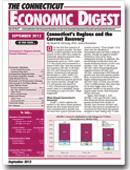 |
 |
September 2013 Connecticut Economic Digest |
 |
Connecticut's Regions and the Current Recovery
By Daniel W. Kennedy, Ph.D., Senior Economist, Department of Labor
 ver the first four quarters of the current recovery, the first quarter of 2010 (2010Q1) to the first quarter of 2011 (2011Q1), based on seasonally adjusted quarterly data, Connecticut’s Non-Farm Employment grew by 1.60%, while U.S. Non-Farm jobs increased by a slower 0.99% rate. Over the second four quarters, 2011Q1 to 2012Q1, the U.S. and Connecticut traded places. Connecticut’s job-growth decelerated to 1.26%, while U.S. job-growth accelerated to +1.83%. Over the third four-quarter period of the current recovery, though the U.S. job-growth rate slowed to 1.54%, Connecticut’s job-growth nearly came to a standstill, barely increasing at a rate of 0.26%. What happened? [ read more ] ver the first four quarters of the current recovery, the first quarter of 2010 (2010Q1) to the first quarter of 2011 (2011Q1), based on seasonally adjusted quarterly data, Connecticut’s Non-Farm Employment grew by 1.60%, while U.S. Non-Farm jobs increased by a slower 0.99% rate. Over the second four quarters, 2011Q1 to 2012Q1, the U.S. and Connecticut traded places. Connecticut’s job-growth decelerated to 1.26%, while U.S. job-growth accelerated to +1.83%. Over the third four-quarter period of the current recovery, though the U.S. job-growth rate slowed to 1.54%, Connecticut’s job-growth nearly came to a standstill, barely increasing at a rate of 0.26%. What happened? [ read more ]
|
 |
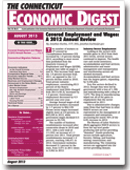 |
 |
August 2013 Connecticut Economic Digest |
 |
Covered Employment and Wages: A 2012 Annual Review.
By Jonathan Kuchta, CCT, Department of Labor
 he number of workers in CT covered by Unemployment Insurance (UI) increased by 1.0 percent during 2012, according to most recent data published from the Quarterly Census of Employment and Wages (QCEW) program (see table on pages 2 and 3). This increase built upon the 1.0 percent increase from 2011, as opposed to the 1.2 percent decline noted in 2010. Total private industry employment, constituting 85.5 percent of the State’s employment total [little changed from 2011’s 85.3], increased by 1.2 percent. Government employment decreased by 0.5 percent year-over-year. [ read more ] he number of workers in CT covered by Unemployment Insurance (UI) increased by 1.0 percent during 2012, according to most recent data published from the Quarterly Census of Employment and Wages (QCEW) program (see table on pages 2 and 3). This increase built upon the 1.0 percent increase from 2011, as opposed to the 1.2 percent decline noted in 2010. Total private industry employment, constituting 85.5 percent of the State’s employment total [little changed from 2011’s 85.3], increased by 1.2 percent. Government employment decreased by 0.5 percent year-over-year. [ read more ]
Connecticut Migration Patterns.
By Matthew Krzyzek, Economist, Department of Labor
 xamining interstate migration patterns provides an interesting view of where new Nutmeggers are coming from and where former Connecticut residents are going. Table 1 shows the ten largest sources of Connecticut inflow migration. The bordering states of New York and Massachusetts had the largest combined share of total inflow to the state at 39 percent of total inflows. Together with the third largest inflow state of Florida, those three states totaled 45 percent of flows into Connecticut. These three states since 2005 have consistently comprised the top three inflow origins to Connecticut. Overall inflow to the state in 2011 was 73,607 new residents. From 2005 through 2011 inflow peaked in 2006 at 88,518 new residents. [ read more ] xamining interstate migration patterns provides an interesting view of where new Nutmeggers are coming from and where former Connecticut residents are going. Table 1 shows the ten largest sources of Connecticut inflow migration. The bordering states of New York and Massachusetts had the largest combined share of total inflow to the state at 39 percent of total inflows. Together with the third largest inflow state of Florida, those three states totaled 45 percent of flows into Connecticut. These three states since 2005 have consistently comprised the top three inflow origins to Connecticut. Overall inflow to the state in 2011 was 73,607 new residents. From 2005 through 2011 inflow peaked in 2006 at 88,518 new residents. [ read more ]
|
 |
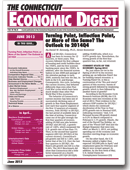 |
 |
June 2013 Connecticut Economic Digest |
 |
Turning Point, Inflection Point, or More of the Same? The Outlook to 2014Q4.
By Daniel W. Kennedy, Ph.D., Senior Economist, Department of Labor
 s of 2013Q1, Connecticut has been in recovery for 12 quarters, or three years. This recovery followed the first collapse of housing and credit bubbles since the 1920’s, and the first systemic banking panic since the 1930’s. In addition, after the financial system bailout in late 2008 and passage of the stimulus package in early 2009, austerity has won the day, in both in the U.S. and Europe. Consequently, this cycle, including the current recovery, has behaved differently than even other Post Cold War cycles which have been much weaker than other Post World War II Era recoveries. [ read more ] s of 2013Q1, Connecticut has been in recovery for 12 quarters, or three years. This recovery followed the first collapse of housing and credit bubbles since the 1920’s, and the first systemic banking panic since the 1930’s. In addition, after the financial system bailout in late 2008 and passage of the stimulus package in early 2009, austerity has won the day, in both in the U.S. and Europe. Consequently, this cycle, including the current recovery, has behaved differently than even other Post Cold War cycles which have been much weaker than other Post World War II Era recoveries. [ read more ]
|
 |
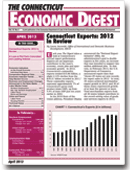 |
 |
April 2013 Connecticut Economic Digest |
 |
Connecticut Exports: 2012 in Review
By Laura Jaworski, Office of International and Domestic Affairs, Department of Economic and Community Development
 ach year The Digest takes a look at Connecticut’s annual export performance. Exports are an important contributor to the state’s economy, create jobs and spur economic growth. In 2012, Connecticut’s commodity exports totaled $15.86 billion, a slight 2.14% decline from the $16.21 billion recorded in 2011. These commodity exports represent approximately 7% of Connecticut’s gross state product (state GSP), up from 4.9% of state GSP just ten years earlier in 2002. [ read more ] ach year The Digest takes a look at Connecticut’s annual export performance. Exports are an important contributor to the state’s economy, create jobs and spur economic growth. In 2012, Connecticut’s commodity exports totaled $15.86 billion, a slight 2.14% decline from the $16.21 billion recorded in 2011. These commodity exports represent approximately 7% of Connecticut’s gross state product (state GSP), up from 4.9% of state GSP just ten years earlier in 2002. [ read more ]
A Look at Phil Fed’s Coincident and Leading Indexes
By Jungmin Charles Joo, Associate Research Analyst, Department of Labor
 tate Coincident Indexes. The Federal Reserve Bank of Philadelphia produces a monthly coincident index for each of the 50 states and the nation, and it combines four state-level indicators, nonfarm payroll employment, average hours worked in manufacturing, the unemployment rate, and wage and salary disbursements deflated by the consumer price index (U.S. city average) to summarize current economic conditions in a single statistic. The trend for each state’s index is set to the trend of its gross domestic product (GDP), so longterm growth in the state’s index matches long-term growth in its GDP. [ read more ] tate Coincident Indexes. The Federal Reserve Bank of Philadelphia produces a monthly coincident index for each of the 50 states and the nation, and it combines four state-level indicators, nonfarm payroll employment, average hours worked in manufacturing, the unemployment rate, and wage and salary disbursements deflated by the consumer price index (U.S. city average) to summarize current economic conditions in a single statistic. The trend for each state’s index is set to the trend of its gross domestic product (GDP), so longterm growth in the state’s index matches long-term growth in its GDP. [ read more ]
|
 |
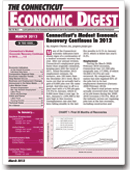 |
 |
March 2013 Connecticut Economic Digest |
 |
Connecticut's Modest Economic Recovery Continues in 2012
By Jungmin Charles Joo, Associate Research Analyst, Department of Labor
 any of the Connecticut economic indicators have shown signs of a continuation of a modest economic recovery last year. After our annual revision, Connecticut’s employment grew faster than originally estimated, keeping pace with the trend of 2011. Initial December 2012 employment estimate, for instance, was 100 lower than the December 2011 level. But it turns out that we actually had a gain of 8,600 jobs over the same period. And this year is off to a good start with a 4,700 job gain (+0.3%) in January, which is 8,000 more than a year ago. In fact, January’s 1,644,400 is the new high in this recovery. Unemployment rate also has been falling steadily in the last five months to 8.1% in January 2013, which is below last year’s 8.2%. [ read more ] any of the Connecticut economic indicators have shown signs of a continuation of a modest economic recovery last year. After our annual revision, Connecticut’s employment grew faster than originally estimated, keeping pace with the trend of 2011. Initial December 2012 employment estimate, for instance, was 100 lower than the December 2011 level. But it turns out that we actually had a gain of 8,600 jobs over the same period. And this year is off to a good start with a 4,700 job gain (+0.3%) in January, which is 8,000 more than a year ago. In fact, January’s 1,644,400 is the new high in this recovery. Unemployment rate also has been falling steadily in the last five months to 8.1% in January 2013, which is below last year’s 8.2%. [ read more ]
|
 |
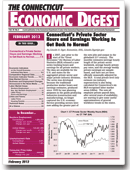 |
 |
February 2013 Connecticut Economic Digest |
 |
Connecticut's Private Sector Hours and Earnings: Working to Get Back to Normal
By Lincoln S. Dyer, Economist, Department of Labor
 n 2007, just prior to the start of the “Great Recession,” the Bureau of Labor Statistics (BLS) released a new series tracking hours and earnings for all private workers. The data are available for the U.S. and states for the aggregated private sector and major private industry divisions. n 2007, just prior to the start of the “Great Recession,” the Bureau of Labor Statistics (BLS) released a new series tracking hours and earnings for all private workers. The data are available for the U.S. and states for the aggregated private sector and major private industry divisions.
The series was developed because the traditional production worker hours and earnings estimates, produced since 1939 for war planning purposes in the goods-producing industries (construction and manufacturing), no longer captured the U.S. economy. Service-providing sectors were now adding the greater part of the new jobs and output in the globalized 21st century. The monthly estimates (average hourly length of the private sector workweek, average hourly private pay rates, and the average weekly private earnings) are samplebased, and have not yet been officially seasonally adjusted by the BLS. A total private level only estimate (no industry supersectors) is also being calculated for Connecticut’s six BLS-recognized labor market areas (LMAs). The new all employee private payroll data, after several years of availability, are starting to give some useful approximations of general workforce trends in the states. [ read more ]
|
 |
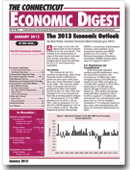 |
 |
January 2013 Connecticut Economic Digest |
 |
The 2013 Economic Outlook
By Mark Prisloe, Associate Economist, Department of Economic and Community Development
 s we begin a new year, the Digest looks at the economic prospects for the year ahead. This outlook is an interpretation of some of the most recent data and their trends, and offers some insights about what they portend for the U.S. and Connecticut economies. s we begin a new year, the Digest looks at the economic prospects for the year ahead. This outlook is an interpretation of some of the most recent data and their trends, and offers some insights about what they portend for the U.S. and Connecticut economies.
The outlook for the U.S. economy is improving. Real Gross Domestic Product (RGDP) has grown for three and a half years since the “Great Recession” ended in Q2-2009. The constant dollar value of all goods and services produced by labor and capital located in the U.S. since then has averaged 2.2% at an annual rate from the preceding quarter (Figure 1). Decreasing by 3.1% in 2009, growing 2.4% in 2010, 1.8% in 2011, and an estimated 3.1% in Q3-2012, RGDP growth of 1.8% to 2.4% is likely in 2013. The New England Economic Partnership (NEEP), a consortium of government, business, and academia, in its proprietary forecast sees RGDP growth at 2.4% in 2013. The National Association of Business Economists (NABE) outlook panel sees 2.4% growth in 2013. [ read more ]
|
 |
 |
 |
|
 |
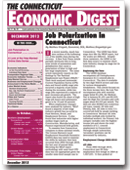 |
 |
December 2012 Connecticut Economic Digest |
 |
Job Polarization in Connecticut
By Matthew Krzyzek, Economist, Department of Labor
 n recent months, much has been written of the hollowing out of the middle class during the recovery. A New York Times article partially attributes this to longterm trends of automation and globalization that cause a polarization of labor to high and low wage employment. The same article extensively reports on the findings by The National Employment Law Project (NELP). Their work analyzed nationwide Current Population Survey (CPS) data and found middle wage jobs incurred a majority of job losses during the recession, while lowwage jobs experienced a majority of post-recession job growth. The report also found the share of high wage job losses and subsequent gains to be 19 and 20 percent. [ read more ] n recent months, much has been written of the hollowing out of the middle class during the recovery. A New York Times article partially attributes this to longterm trends of automation and globalization that cause a polarization of labor to high and low wage employment. The same article extensively reports on the findings by The National Employment Law Project (NELP). Their work analyzed nationwide Current Population Survey (CPS) data and found middle wage jobs incurred a majority of job losses during the recession, while lowwage jobs experienced a majority of post-recession job growth. The report also found the share of high wage job losses and subsequent gains to be 19 and 20 percent. [ read more ]
A Look at the Help Wanted OnLine Data Series
By Sarah York, Economist, Department of Labor
 one are the days when the most effective and utilized job search method was to open up your local newspaper. The use of online databases by job seekers has become much more prevalent in recent years. In an effort to reflect this reality, the Conference Board replaced its Help Wanted newspaper employment index with the Help Wanted OnLine Data Series (HWOL) in 2005. The series can be used for a variety of purposes, but its strengths may lie as an indicator of job demand as represented by employment vacancies and as a leading indicator of potential shifts in actual employment levels. [ read more ] one are the days when the most effective and utilized job search method was to open up your local newspaper. The use of online databases by job seekers has become much more prevalent in recent years. In an effort to reflect this reality, the Conference Board replaced its Help Wanted newspaper employment index with the Help Wanted OnLine Data Series (HWOL) in 2005. The series can be used for a variety of purposes, but its strengths may lie as an indicator of job demand as represented by employment vacancies and as a leading indicator of potential shifts in actual employment levels. [ read more ]
|
 |
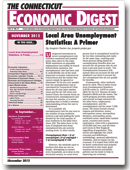 |
 |
November 2012 Connecticut Economic Digest |
 |
Local Area Unemployment Statistics: A Primer
By Jungmin Charles Joo, Associate Research Analyst, Department of Labor
 nexpected movements in recent unemployment rate numbers surprised and puzzled many data users in the state. While sometimes no plausible explanations can readily be found behind these statistics, the unemployment rate has been and is undoubtedly one of the most important economic indicators in Connecticut and the nation that cannot simply be ignored or dismissed. So do you ever wonder how the unemployment rate is calculated for Connecticut? How about for all nine labor market areas and for all 169 cities and towns? Given the intense focus on Connecticut’s unemployment rate the last few months, it is worth spending time to build a common understanding of how the rate is determined. [ read more ] nexpected movements in recent unemployment rate numbers surprised and puzzled many data users in the state. While sometimes no plausible explanations can readily be found behind these statistics, the unemployment rate has been and is undoubtedly one of the most important economic indicators in Connecticut and the nation that cannot simply be ignored or dismissed. So do you ever wonder how the unemployment rate is calculated for Connecticut? How about for all nine labor market areas and for all 169 cities and towns? Given the intense focus on Connecticut’s unemployment rate the last few months, it is worth spending time to build a common understanding of how the rate is determined. [ read more ]
|
 |
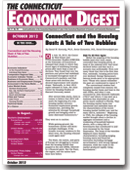 |
 |
October 2012 Connecticut Economic Digest |
 |
Connecticut and the Housing Bust: A Tale of Two Bubbles
By Daniel W. Kennedy, Ph.D., Senior Economist, Department of Labor
 n July 18, 2012, the Center for Real Estate and Urban Economic Studies (CREUES) at the University of Connecticut released their study in which they found signs of stabilizing housing prices after more than a year of declines. They found that over the previous year prices had stabilized or increased throughout most of Connecticut’s markets, and that those areas with declines also showed improvement with smaller drops. Nationally, in their 2012 report released in June, the Joint Center for Housing Studies of Harvard University stated: n July 18, 2012, the Center for Real Estate and Urban Economic Studies (CREUES) at the University of Connecticut released their study in which they found signs of stabilizing housing prices after more than a year of declines. They found that over the previous year prices had stabilized or increased throughout most of Connecticut’s markets, and that those areas with declines also showed improvement with smaller drops. Nationally, in their 2012 report released in June, the Joint Center for Housing Studies of Harvard University stated:
After several false starts, there is reason to believe that 2012 will mark the beginning of a true housing market recovery. Sustained employment growth remains key, providing the stimulus for stronger household growth and bringing relief to some distressed homeowners. They went on to caution:
While gaining ground, the homeowner market still faces multiple challenges. If the broader economy weakens in the short term, the housing rebound could again stall. [ read more ] |
 |
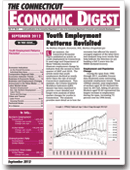 |
 |
September 2012 Connecticut Economic Digest |
 |
Youth Employment Patterns Revisited
By Matthew Krzyzek, Economist, Department of Labor
 ast summer, the Connecticut Economic Digest published an article on youth employment in Connecticut. It used wage and Department of Motor Vehicles records to illustrate employment change by industry from the second to third quarter of 2007 and 2010. The article noted that youth employment declined at nearly three times the rate of overall Connecticut employment. This summer, the Census Quarterly Workforce Indicators (QWI) dataset has been examined to provide a more detailed and longer-term analysis of labor market changes for youths in Connecticut. The analysis provides more detail as to how the recession has affected the state’s youngest segment of the labor force and analyzes long-term trends that help indicate the direction we are heading a full 3 years into the NBER-declared recovery. [ read more ] ast summer, the Connecticut Economic Digest published an article on youth employment in Connecticut. It used wage and Department of Motor Vehicles records to illustrate employment change by industry from the second to third quarter of 2007 and 2010. The article noted that youth employment declined at nearly three times the rate of overall Connecticut employment. This summer, the Census Quarterly Workforce Indicators (QWI) dataset has been examined to provide a more detailed and longer-term analysis of labor market changes for youths in Connecticut. The analysis provides more detail as to how the recession has affected the state’s youngest segment of the labor force and analyzes long-term trends that help indicate the direction we are heading a full 3 years into the NBER-declared recovery. [ read more ]
|
 |
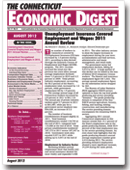 |
 |
August 2012 Connecticut Economic Digest |
 |
Unemployment Insurance Covered Employment and Wages: 2011 Annual Review
By Edward T. Doukas, Jr., Research Analyst, Department of Labor
 he number of workers in Connecticut covered by Unemployment Insurance (UI) laws increased by 1.0 percent during 2011, according to data derived through the Quarterly Census of Employment and Wages (QCEW) program. The 2011 increase reversed the trend over the previous two years when annual average employment declined; down 1.2 percent in 2010 and 4.3 percent in 2009. Total private industry employment, accounting for 85.3 percent of the State’s employment total, increased by 1.6 percent, while government employment fell by 1.9 percent. [ read more ] he number of workers in Connecticut covered by Unemployment Insurance (UI) laws increased by 1.0 percent during 2011, according to data derived through the Quarterly Census of Employment and Wages (QCEW) program. The 2011 increase reversed the trend over the previous two years when annual average employment declined; down 1.2 percent in 2010 and 4.3 percent in 2009. Total private industry employment, accounting for 85.3 percent of the State’s employment total, increased by 1.6 percent, while government employment fell by 1.9 percent. [ read more ]
Connecticut Occupational Employment and Wages in 2012
By Lisa Castagna, Department of Labor, & Jungmin Charles Joo, Associate Research Analyst, Department of Labor
 he recently released statistics by the Office of Research in the Connecticut Department of Labor showed that retail salespersons (50,190) and cashiers (39,640) were the occupations with the highest employment in Connecticut. These two occupations combined made up nearly 6 percent of total Connecticut employment. [ read more ] he recently released statistics by the Office of Research in the Connecticut Department of Labor showed that retail salespersons (50,190) and cashiers (39,640) were the occupations with the highest employment in Connecticut. These two occupations combined made up nearly 6 percent of total Connecticut employment. [ read more ]
|
 |
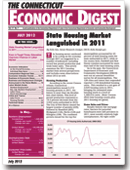 |
 |
July 2012 Connecticut Economic Digest |
 |
State Housing Market Languished in 2011
By Kolie Sun, Senior Research Analyst, Department of Economic and Community Development
 he housing sector continued to be a drag on the economy through 2011 as suggested by a number of indicators, including record-low permit production and weak home sales. This article examines the 2011 housing market from several perspectives and includes some observations. [ read more ] he housing sector continued to be a drag on the economy through 2011 as suggested by a number of indicators, including record-low permit production and weak home sales. This article examines the 2011 housing market from several perspectives and includes some observations. [ read more ]
Even in Tough Times, Education Improves Chances in Labor Market
By Patrick.Flaherty, Economist, Department of Labor
 uring graduation season, there were a number of stories in the news about the difficulty that many new college graduates are having finding employment, particularly high paying employment within a field related to their course of study. In addition, announcements by many institutions of tuition and fee increases and the debates in Washington about the interest rate changed on student loans generated media attention on the high cost of higher education. Implicit in some of this coverage is the idea that given the high cost of going to college, and the shortterm difficulty of some college graduates in the labor market, a college education might not be “worth it.” While “individual results may vary” as they say (in fact they do vary significantly), on average additional education is still associated with increased employment and higher long term earnings prospects. [ read more ] uring graduation season, there were a number of stories in the news about the difficulty that many new college graduates are having finding employment, particularly high paying employment within a field related to their course of study. In addition, announcements by many institutions of tuition and fee increases and the debates in Washington about the interest rate changed on student loans generated media attention on the high cost of higher education. Implicit in some of this coverage is the idea that given the high cost of going to college, and the shortterm difficulty of some college graduates in the labor market, a college education might not be “worth it.” While “individual results may vary” as they say (in fact they do vary significantly), on average additional education is still associated with increased employment and higher long term earnings prospects. [ read more ]
|
 |
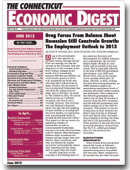 |
 |
June 2012 Connecticut Economic Digest |
 |
Drag Forces From Balance Sheet Recession Still Constrain Growth: The Employment Outlook to 2013
By Daniel W. Kennedy, Ph.D., Senior Economist, Department of Labor
 rag is the aerodynamic force that opposes an aircraft’s motion through the air. If for our analogy, we cast the aircraft as the economy, then the drag force on the economy is the $16.4 trillion collapse in net worth of U.S. households between 2007Q2 and 2009Q1. As of the fourth quarter of 2011, U.S. household net worth was still down $8.4 trillion from its peak. Further, the net worth of non-incorporated businesses was still down $2 trillion from its peak, also in 2007Q2. As noted in The Outlook to 2012, the recent downturn was no “ordinary” recession, and this is not a “normal” recovery. This recovery not only followed a financial panic, but also the first popping of asset bubbles in housing and the stock market, in conjunction with unsustainable levels of household debt since the 1920s. This wiped out the net worth of a significant number of households, as well as unincorporated businesses, leaving in its wake what has been called a Balance Sheet Recession. Balance sheet recessions are steeper and last longer than nonbalance sheet recessions, and they are followed by weaker recoveries5 as households reduce their spending and pay down debt to repair their net worth. [ read more ] rag is the aerodynamic force that opposes an aircraft’s motion through the air. If for our analogy, we cast the aircraft as the economy, then the drag force on the economy is the $16.4 trillion collapse in net worth of U.S. households between 2007Q2 and 2009Q1. As of the fourth quarter of 2011, U.S. household net worth was still down $8.4 trillion from its peak. Further, the net worth of non-incorporated businesses was still down $2 trillion from its peak, also in 2007Q2. As noted in The Outlook to 2012, the recent downturn was no “ordinary” recession, and this is not a “normal” recovery. This recovery not only followed a financial panic, but also the first popping of asset bubbles in housing and the stock market, in conjunction with unsustainable levels of household debt since the 1920s. This wiped out the net worth of a significant number of households, as well as unincorporated businesses, leaving in its wake what has been called a Balance Sheet Recession. Balance sheet recessions are steeper and last longer than nonbalance sheet recessions, and they are followed by weaker recoveries5 as households reduce their spending and pay down debt to repair their net worth. [ read more ]
|
 |
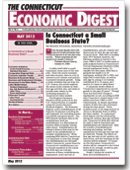 |
 |
May 2012 Connecticut Economic Digest |
 |
Is Connecticut a Small Business State?
By Manisha Srivastava, Economist, Department of Labor
 Over the past decade and a half, America’s small businesses have created 65 percent of all new jobs in the country… These companies are the engine of job growth in America.” -President Barack Obama, October 21, 2009 Over the past decade and a half, America’s small businesses have created 65 percent of all new jobs in the country… These companies are the engine of job growth in America.” -President Barack Obama, October 21, 2009
A widely held belief is small businesses create most of the new jobs. Given the recent recession and slow recovery, there is a lot of interest in job creation and policies to promote economic growth. Using a newly available data set from the U.S. Census, this article explores the notion of job creation by both firm age and firm size, and seeks to provide some clarity on the underlying dynamics of Connecticut’s labor market.
The Business Dynamics Statistics (BDS) produced by the U.S. Census Bureau is compiled using the Census Bureau’s Business Register. The Business Register covers establishments of all domestic businesses including the self-employed, but excluding private households and governments. The BDS dataset tabulates data at the establishment level (an establishment is a fixed physical location where economic activity takes place). Establishments all belong to firms (a firm may be the parent of one establishment or multiple establishments). When analyzing BDS data for Connecticut it is important to note that though the establishments are all based within Connecticut, parent firms for Connecticut’s establishments can be located anywhere in the nation. [ read more ] |
 |
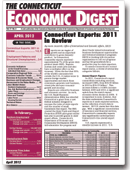 |
 |
April 2012 Connecticut Economic Digest |
 |
Connecticut Exports: 2011 in Review
By Laura Jaworski, Office of International and Domestic Affairs, Department of Economic and Community Development
 xports are an engine of growth and an important contributor to gross domestic product. In Connecticut, commodity exports represent approximately 7% of the gross state product (state GDP). Exports sustain and create jobs and also have a multiplier effect on the economy. Given the fact that 95% of the world’s consumers live outside the U.S., it makes sense to pursue foreign market opportunities and reach those consumers, generate new business, create jobs and spur economic growth and recovery. [ read more ] xports are an engine of growth and an important contributor to gross domestic product. In Connecticut, commodity exports represent approximately 7% of the gross state product (state GDP). Exports sustain and create jobs and also have a multiplier effect on the economy. Given the fact that 95% of the world’s consumers live outside the U.S., it makes sense to pursue foreign market opportunities and reach those consumers, generate new business, create jobs and spur economic growth and recovery. [ read more ]
Employment Patterns and Structural Unemployment
By Matthew Krzyzek, Economist, Department of Labor
 he recent recession has raised the question of structural unemployment’s contribution to the stubbornly high unemployment rates that have thus far typified the recovery period. Structural change—the permanent relocation of workers from some industries to others, is a dynamic process that occurs throughout business cycles. [ read more ] he recent recession has raised the question of structural unemployment’s contribution to the stubbornly high unemployment rates that have thus far typified the recovery period. Structural change—the permanent relocation of workers from some industries to others, is a dynamic process that occurs throughout business cycles. [ read more ]
|
 |
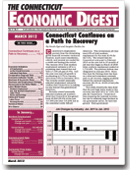 |
 |
March 2012 Connecticut Economic Digest |
 |
Connecticut Continues on a Path to Recovery
By Lincoln S. Dyer, Economist, Department of Labor & Jungmin Charles Joo, Associate Research Analyst, DOL, Jungmin.Joo@ct.gov
 onnecticut’s employment recovery from the devastating global financial recession continues. However, much more remediation, rebirth, and renewal are needed for a stable and lasting jobs revival. The January 2012 total nonfarm employment estimate is off to a promising start toward that end with a 7,100 job gain (0.4%). And the year-over-year job growth is accelerating to 0.7% in January 2012 from 0.5% in December 2011. The recently revised seasonally adjusted employment estimates confirm that Connecticut is making its way beyond this generational downturn. [ read more ] onnecticut’s employment recovery from the devastating global financial recession continues. However, much more remediation, rebirth, and renewal are needed for a stable and lasting jobs revival. The January 2012 total nonfarm employment estimate is off to a promising start toward that end with a 7,100 job gain (0.4%). And the year-over-year job growth is accelerating to 0.7% in January 2012 from 0.5% in December 2011. The recently revised seasonally adjusted employment estimates confirm that Connecticut is making its way beyond this generational downturn. [ read more ]
|
 |
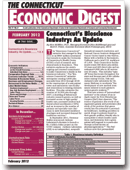 |
 |
February 2012 Connecticut Economic Digest |
 |
Connecticut's Bioscience Industry: An Update
By Stan McMillen, Ph.D., Managing Economist, DECD and Mark Prisloe, Associate Economist, Department of Economic and Community Development
 he “Bioscience Connecticut” initiative that emerged in May 2011 is an $864 million investment that intends to make the University of Connecticut’s Health Center (UCHC) a hub of research and clinical work in bioscience. This initiative reinforces the state’s ongoing and renewed commitment to make Connecticut a leader in the bioscience industry. The “Bioscience Connecticut” initiative anticipates creating 3,000 jobs annually from 2012 through 2018 in the construction of a new patient tower and ambulatory care facility and renovations to existing research facilities. The plan estimates the creation of 16,400 jobs through 2037, a doubling of federal and industry research grants, as well as increased access to high quality health care, increased medical and dental school enrollments (+30%) and an increase in the number of primary and specialty care clinicians to meet forecasted workforce shortages and increased demand for healthcare services. [ read more ] he “Bioscience Connecticut” initiative that emerged in May 2011 is an $864 million investment that intends to make the University of Connecticut’s Health Center (UCHC) a hub of research and clinical work in bioscience. This initiative reinforces the state’s ongoing and renewed commitment to make Connecticut a leader in the bioscience industry. The “Bioscience Connecticut” initiative anticipates creating 3,000 jobs annually from 2012 through 2018 in the construction of a new patient tower and ambulatory care facility and renovations to existing research facilities. The plan estimates the creation of 16,400 jobs through 2037, a doubling of federal and industry research grants, as well as increased access to high quality health care, increased medical and dental school enrollments (+30%) and an increase in the number of primary and specialty care clinicians to meet forecasted workforce shortages and increased demand for healthcare services. [ read more ]
|
 |
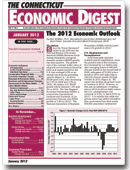 |
 |
January 2012 Connecticut Economic Digest |
 |
The 2012 Economic Outlook
By Stan McMillen, Ph.D., Managing Economist, DECD and Mark Prisloe, Associate Economist, Department of Economic and Community Development
 ince the “Great Recession” ended in Q2-2009 per the National Bureau of Economic Research (NBER) Business Cycle Dating Committee, real gross domestic product (RGDP) growth has been positive. The growth rate of the constant dollar value of all goods and services produced by labor and capital located in the U.S. has averaged 2.5% at an annual rate from the preceding quarter (Figure 1) In 2010, RGDP grew 3.0%, after decreasing by 0.3% in 2008 and 3.5% in 2009. We believe U.S. RGDP growth will be between 1.5% and 2% in 2012. The New England Economic Partnership (NEEP), a consortium of government, business and academia, in its proprietary forecast sees RGDP growth at 1.8% in 2012. The National Association of Business Economists (NABE) outlook panel sees 2.4% growth in 2012. [ read more ] ince the “Great Recession” ended in Q2-2009 per the National Bureau of Economic Research (NBER) Business Cycle Dating Committee, real gross domestic product (RGDP) growth has been positive. The growth rate of the constant dollar value of all goods and services produced by labor and capital located in the U.S. has averaged 2.5% at an annual rate from the preceding quarter (Figure 1) In 2010, RGDP grew 3.0%, after decreasing by 0.3% in 2008 and 3.5% in 2009. We believe U.S. RGDP growth will be between 1.5% and 2% in 2012. The New England Economic Partnership (NEEP), a consortium of government, business and academia, in its proprietary forecast sees RGDP growth at 1.8% in 2012. The National Association of Business Economists (NABE) outlook panel sees 2.4% growth in 2012. [ read more ]
|
 |
 |
 |
|
 |
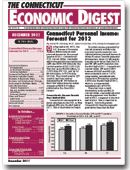 |
 |
December 2011 Connecticut Economic Digest |
Connecticut Personal Income: Forecast for 2012 [ Download December 2011 CT Economic Digest PDF ]
By Daniel W. Kennedy, Ph.D., Senior Economist, Department of Labor
 n September 22, 2011, the U.S. Bureau of Economic Analysis (BEA) released state personal income for the second quarter of 2011. Connecticut’s (CT), current dollar, seasonally adjusted quarterly personal income (QPI) was $206.408 billion for the second quarter of 2011 (2011Q2). This was up by $2.522 billion, or 1.24% from 2011Q1, and up by $9.694 billion, or 4.93% from 2010Q2. The second quarter QPI number had been revised downward by $1.632 billion to $203.886 billion from the initial estimate of $205.518 billion published in the June 2011 release. [ read more ] n September 22, 2011, the U.S. Bureau of Economic Analysis (BEA) released state personal income for the second quarter of 2011. Connecticut’s (CT), current dollar, seasonally adjusted quarterly personal income (QPI) was $206.408 billion for the second quarter of 2011 (2011Q2). This was up by $2.522 billion, or 1.24% from 2011Q1, and up by $9.694 billion, or 4.93% from 2010Q2. The second quarter QPI number had been revised downward by $1.632 billion to $203.886 billion from the initial estimate of $205.518 billion published in the June 2011 release. [ read more ]
|
 |
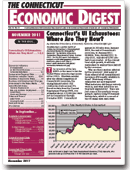 |
 |
November 2011 Connecticut Economic Digest |
Connecticut's UI Exhaustees: Where Are They Now? [ Download November 2011 CT Economic Digest PDF ]
By Manisha Srivastava, Economist, Department of Labor
 he recession of the late 2000’s is the worst to hit the United States since the depression of the 1930’s. Nineteen months after the official completion of Connecticut’s recession, the unemployment rate is still stubbornly stuck around 9%. Based on data from the Current Employment Survey (CES), it is estimated about 119,000 jobs were lost in Connecticut through December 2009. Connecticut gained 24,300 jobs from January 2010, the end of Connecticut’s recession, to January 2011. However, from January 2011 to July 2011, only about 8,500 jobs have been created. At the current level of job growth, it will take many years to employ those laid off by the recession. [ read more ] he recession of the late 2000’s is the worst to hit the United States since the depression of the 1930’s. Nineteen months after the official completion of Connecticut’s recession, the unemployment rate is still stubbornly stuck around 9%. Based on data from the Current Employment Survey (CES), it is estimated about 119,000 jobs were lost in Connecticut through December 2009. Connecticut gained 24,300 jobs from January 2010, the end of Connecticut’s recession, to January 2011. However, from January 2011 to July 2011, only about 8,500 jobs have been created. At the current level of job growth, it will take many years to employ those laid off by the recession. [ read more ]
This a partial reprint of “Following Connecticut’s Unemployment Insurance Claimants Through the Recession,” by Manisha Srivastava, Connecticut Department of Labor, October 2011. For the full report, including an analysis on the demographics of current claimants, download: https://www1.ctdol.state.ct.us/lmi/pubs/ConnecticutUIClaimants.pdf
|
 |
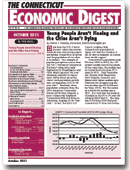 |
 |
October 2011 Connecticut Economic Digest |
Young People Aren't Fleeing and the Cities Aren't Dying [ Download October 2011 CT Economic Digest PDF ]
By Patrick.Flaherty, Economist, Department of Labor
 ata from the U.S. Census Bureau refute the conventional wisdom that young people are leaving Connecticut in droves and the population of our cities is in decline. One example of popular perceptions comes from the “2011 Survey of Connecticut Business” released in early September by BlumShapiro and CBIA which reported “An overwhelming majority of respondents (85%) worry about the state’s slow population growth and out-migration of 21-to-45 year-olds.” Similarly, when population estimates from the 2009 American Community Survey (ACS) were released, a press release was headlined “Connecticut Still at Bottom in Attracting, Keeping 25-34-Year-Olds.” In fact, the 2010 U.S. Census confirms that Ct’s population is aging, but that the situation is not as dire or dramatic as perceptions would suggest. [ read more ] ata from the U.S. Census Bureau refute the conventional wisdom that young people are leaving Connecticut in droves and the population of our cities is in decline. One example of popular perceptions comes from the “2011 Survey of Connecticut Business” released in early September by BlumShapiro and CBIA which reported “An overwhelming majority of respondents (85%) worry about the state’s slow population growth and out-migration of 21-to-45 year-olds.” Similarly, when population estimates from the 2009 American Community Survey (ACS) were released, a press release was headlined “Connecticut Still at Bottom in Attracting, Keeping 25-34-Year-Olds.” In fact, the 2010 U.S. Census confirms that Ct’s population is aging, but that the situation is not as dire or dramatic as perceptions would suggest. [ read more ]
|
 |
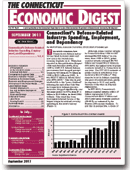 |
 |
September 2011 Connecticut Economic Digest |
Connecticut's Defense-Related Industry: Spending, Employment, and Dependency [ Download September 2011 CT Economic Digest PDF ]
By Mark Prisloe, Associate Economist, Department of Economic and Community Development
 his article examines how Connecticut’s defense industry has fared in recent years and how much the overall state economy depends on it. When last reported in this publication (August 1996 and February 2005), from 1985 to 1995 U.S. federal defense procurement had dropped precipitously by 43% from $179 billion in 1985 to $101 billion in 1995. It was $327.5 billion in federal fiscal year (FFY) 2009. This was in part attributable to the “peace dividend” following the end of the Cold War. In Connecticut defense procurement also dropped significantly over the same period by 64%, from $7.1 billion to $2.5 billion (in fixed 1992 dollars). This trend has been thoroughly reversed by one of the largest surges in national security spending in the state’s history. [ read more ] his article examines how Connecticut’s defense industry has fared in recent years and how much the overall state economy depends on it. When last reported in this publication (August 1996 and February 2005), from 1985 to 1995 U.S. federal defense procurement had dropped precipitously by 43% from $179 billion in 1985 to $101 billion in 1995. It was $327.5 billion in federal fiscal year (FFY) 2009. This was in part attributable to the “peace dividend” following the end of the Cold War. In Connecticut defense procurement also dropped significantly over the same period by 64%, from $7.1 billion to $2.5 billion (in fixed 1992 dollars). This trend has been thoroughly reversed by one of the largest surges in national security spending in the state’s history. [ read more ]
|
 |
 |
 |
August 2011 Connecticut Economic Digest |
Covered Employment and Wages: 2010 Annual Review [ Download August 2011 CT Economic Digest PDF ]
By Edward T. Doukas, Jr., Research Analyst, Department of Labor
 mployment in Connecticut covered by Unemployment Insurance (UI) decreased by 1.2 percent during 2010, according to preliminary figures that recently became available through the Quarterly Census of Employment and Wages (QCEW) program. While 2010 recorded the second consecutive drop in annual average employment, the rate of decline was less than in 2009 when covered employment dropped by 4.3 percent. Total private industry employment, constituting 84.8 percent of the State’s employment total, decreased by 1.1 percent, while government employment fell by 1.7 percent. [ read more ] mployment in Connecticut covered by Unemployment Insurance (UI) decreased by 1.2 percent during 2010, according to preliminary figures that recently became available through the Quarterly Census of Employment and Wages (QCEW) program. While 2010 recorded the second consecutive drop in annual average employment, the rate of decline was less than in 2009 when covered employment dropped by 4.3 percent. Total private industry employment, constituting 84.8 percent of the State’s employment total, decreased by 1.1 percent, while government employment fell by 1.7 percent. [ read more ]
|
 |
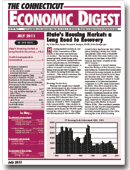 |
 |
July 2011 Connecticut Economic Digest |
State's Housing Market: a Long Road to Recovery [ Download July 2011 CT Economic Digest PDF ]
By By Kolie Sun, Senior Research Analyst, Department of Economic and Community Development
 ousing market activity is one of the barometers of the
health of the state and national economies. The anemic housing permit growth, weak home price increases, and fewer residential real estate transactions in 2010 - when coupled with high unemployment, a jobless economic recovery and a rising foreclosure rate - suggest that
the state’s housing doldrums may continue. This article examines the housing market from several perspectives. [ read more ] ousing market activity is one of the barometers of the
health of the state and national economies. The anemic housing permit growth, weak home price increases, and fewer residential real estate transactions in 2010 - when coupled with high unemployment, a jobless economic recovery and a rising foreclosure rate - suggest that
the state’s housing doldrums may continue. This article examines the housing market from several perspectives. [ read more ]
Youth Employment in Connecticut [ Download July 2011 CT Economic Digest PDF ]
By Matthew Krzyzek, Economist, Department of Labor
 or many, summer is a time
for relaxation. The season is typified by sunny weather, family vacations, barbeques and trips to the beach. However, the season also represents a young workers initiation into the labor force. Be it work as a camp counselor, lifeguard, salesperson or waitress, those summer jobs teach youths valuable skills they will carry with them onto enhanced employment opportunities later in life. Unfortunately, for a growing number of American youths, these jobs are increasingly hard to find. [ read more ] or many, summer is a time
for relaxation. The season is typified by sunny weather, family vacations, barbeques and trips to the beach. However, the season also represents a young workers initiation into the labor force. Be it work as a camp counselor, lifeguard, salesperson or waitress, those summer jobs teach youths valuable skills they will carry with them onto enhanced employment opportunities later in life. Unfortunately, for a growing number of American youths, these jobs are increasingly hard to find. [ read more ]
|
 |
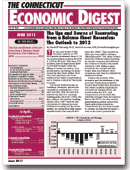 |
 |
June 2011 Connecticut Economic Digest |
The Ups and Downs of Recovering from a Balance Sheet Recession: The Outlook to 2012 [ Download June 2011 CT Economic Digest PDF ]
By Daniel W. Kennedy, Ph.D., Senior Economist, Department of Labor
 he ups and downs of this recovery continue as U.S. GDP growth decelerated from 3.1% (on an annualized basis) in 2010Q4 to 1.8% in 2011Q1. But then, U.S. nonfarm payroll employment grew by 244,000 in April. After the killing of Osama bin Laden, commodity prices, including oil, plummeted the first week of May. However, this may have also been driven by the retreat of speculators and a bearish outlook for the world economy. he ups and downs of this recovery continue as U.S. GDP growth decelerated from 3.1% (on an annualized basis) in 2010Q4 to 1.8% in 2011Q1. But then, U.S. nonfarm payroll employment grew by 244,000 in April. After the killing of Osama bin Laden, commodity prices, including oil, plummeted the first week of May. However, this may have also been driven by the retreat of speculators and a bearish outlook for the world economy.
The recent downturn was no “ordinary” recession, and we are currently in anything but a “normal” recovery. This recovery has followed the first U.S. systemic banking panic since the 1930s, the first collapse of a shadow banking system since 1907, and the first succession of collapses in asset bubbles in housing and the stock market, in conjunction with unsustainable levels of household debt since the 1920s. This resulted in what has been called a Balance Sheet Recession. The Great Depression was a balance sheet recession, as was the recession that followed the collapse of Japan’s real estate bubble in 1989. Balance sheet recessions are steeper and last longer than non-balance sheet recessions, and they are followed by weaker recoveries. [ read more ]
|  |
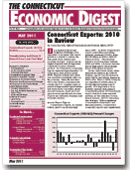 |
 |
May 2011 Connecticut Economic Digest |
Connecticut Exports: 2010 in Review [ Download May 2011 CT Economic Digest PDF ]
By Laura Jaworski, Office of International and Domestic Affairs, Department of Economic and Community Development
 n a climate of fiscal and budgetary challenges, it is imperative to recognize that export growth is a vehicle to achieve the twin goals of job creation and economic recovery. Exports are an engine of growth and an important contributor to gross domestic product. In Connecticut, commodity exports represent approximately 7% of the gross state product (state GDP). Exports sustain and create jobs and have a multiplier effect on the economy. Given the fact that 95% of the world’s consumers live outside the U.S., it makes sense to pursue foreign market opportunities and reach those consumers, generate new business, create jobs and spur economic growth and recovery. Exports are critical for business and economic success. [ read more ] n a climate of fiscal and budgetary challenges, it is imperative to recognize that export growth is a vehicle to achieve the twin goals of job creation and economic recovery. Exports are an engine of growth and an important contributor to gross domestic product. In Connecticut, commodity exports represent approximately 7% of the gross state product (state GDP). Exports sustain and create jobs and have a multiplier effect on the economy. Given the fact that 95% of the world’s consumers live outside the U.S., it makes sense to pursue foreign market opportunities and reach those consumers, generate new business, create jobs and spur economic growth and recovery. Exports are critical for business and economic success. [ read more ]
Manufacturing Isn't Dead: It Doesn't Even Look That Way! [ Download May 2011 CT Economic Digest PDF ]
By Patrick.Flaherty, Economist, Department of Labor
 ome have erroneously declared manufacturing “dead,” particularly in a state like Connecticut that has seen manufacturing’s share of total employment fall nearly in half in the past twenty years. But this pronouncement is not just “premature” (to quote Mark Twain) but completely unwarranted. While a smaller share of total employment, manufacturing is and will continue to be a vital component of Connecticut’s economy and labor market, and Connecticut will remain a place where manufacturers can grow and prosper. [ read more ] ome have erroneously declared manufacturing “dead,” particularly in a state like Connecticut that has seen manufacturing’s share of total employment fall nearly in half in the past twenty years. But this pronouncement is not just “premature” (to quote Mark Twain) but completely unwarranted. While a smaller share of total employment, manufacturing is and will continue to be a vital component of Connecticut’s economy and labor market, and Connecticut will remain a place where manufacturers can grow and prosper. [ read more ]
|
 |
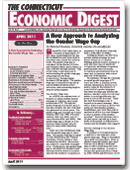 |
 |
April 2011 Connecticut Economic Digest |
A New Approach to Analyzing the Gender Wage Gap [ Download April 2011 CT Economic Digest PDF ]
By Manisha Srivastava, Economist, Department of Labor
 Equal Pay Day” takes place on a Tuesday in April (April 12th this year), symbolizing how far into the workweek women must work to earn what men earned the previous week. The gender wage gap is calculated by the Bureau of Labor and Statistics (BLS), and is based on data collected through surveys. This article takes a new approach to understanding the gender wage gap using wage records from Connecticut’s Unemployment Insurance (UI) program. The gender wage gap is analyzed by age group and in further detail for select industries, with interesting implications for policy makers. Equal Pay Day” takes place on a Tuesday in April (April 12th this year), symbolizing how far into the workweek women must work to earn what men earned the previous week. The gender wage gap is calculated by the Bureau of Labor and Statistics (BLS), and is based on data collected through surveys. This article takes a new approach to understanding the gender wage gap using wage records from Connecticut’s Unemployment Insurance (UI) program. The gender wage gap is analyzed by age group and in further detail for select industries, with interesting implications for policy makers.
As of 2009, the national ratio of women’s to men’s median annual earnings for full-time year-round workers was 0.77. Though the gender wage gap decreased since it was first tracked, the rate of decline has plateaued in recent years. The gender wage gap dropped 12.4 cents between 1981 and 1990, 3.8 cents between 1991 and 2000, and 0.7 cents between 2001 and 2009. The gender wage gap is deeper in Connecticut, where women earn 75 cents for every dollar earned by men. [ read more ]
|
 |
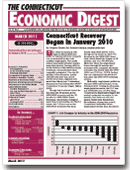 |
 |
March 2011 Connecticut Economic Digest |
Connecticut Recovery Began in January 2010 [ Download March 2011 CT Economic Digest PDF ]
By Jungmin Charles Joo, Associate Research Analyst, Department of Labor
 he Great Recession II that began in March 2008 has ended in January 2010 for Connecticut, as measured by the total nonfarm employment. The newly revised seasonally adjusted employment data showed January 2010 to be the bottom of this awful economic downturn, one month later than originally anticipated. Over the 22 months of the recession, nearly 119,200 jobs were lost, about 20,000 more than originally estimated last March (see “Connecticut Recession to End in December 2009?” Connecticut Economic Digest, March 2010). he Great Recession II that began in March 2008 has ended in January 2010 for Connecticut, as measured by the total nonfarm employment. The newly revised seasonally adjusted employment data showed January 2010 to be the bottom of this awful economic downturn, one month later than originally anticipated. Over the 22 months of the recession, nearly 119,200 jobs were lost, about 20,000 more than originally estimated last March (see “Connecticut Recession to End in December 2009?” Connecticut Economic Digest, March 2010).
Though this downturn lasted far less than the 38 months in the July 2000-Sept 2003 recession and the 46 months in 1989-1992’s Great Recession, the severity of employment drop is astounding. The 7.0% job loss in the March 2008-January 2010 recession was more drastic than 2000-2003’s 3.7%, though not as severe as the 9.3% decrease in the February 1989-December 1992 downturn, which lasted the longest at 46 months, and cost 157,000 jobs. Moreover, when the employment losses through 22 months into recession were compared, the latest recession was even deeper than the 1989-1992 one (-7.0% vs. –5.3%). In fact, this recession experienced the worst job loss since the 1943-45 downturn (-9.5%). [ read more ]
|
 |
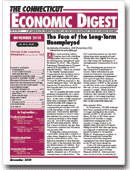 |
 |
February 2011 Connecticut Economic Digest |
Danbury Labor Market Area Profiled [ Download February 2011 CT Economic Digest PDF ]
By Matthew Krzyzek, Economist, Department of Labor
 labor market area is defined as an economically integrated geographic area within which individuals can reside and find employment within a reasonable distance or can readily change employment without changing their place of residence. Connecticut has nine labor market areas, named for the major cities that serve as their hubs. The areas are Bridgeport-Stamford, Danbury, Enfield, Hartford, New Haven, Norwich-New London, Torrington, Waterbury and Willimantic-Danielson. labor market area is defined as an economically integrated geographic area within which individuals can reside and find employment within a reasonable distance or can readily change employment without changing their place of residence. Connecticut has nine labor market areas, named for the major cities that serve as their hubs. The areas are Bridgeport-Stamford, Danbury, Enfield, Hartford, New Haven, Norwich-New London, Torrington, Waterbury and Willimantic-Danielson.
The Danbury Labor Market Area (LMA) consists of the western Connecticut towns of Sherman, New Fairfield, Danbury, Bethel, Brookfield, Bridgewater and New Milford. It has the fourth smallest labor force out of Connecticut’s nine labor market areas. These seven towns hold a combined population of 158,632 residents and the LMA has a labor force of 92,483. [ read more ]
|
 |
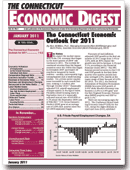 |
 |
January 2011 Connecticut Economic Digest |
The Connecticut Economic Outlook for 2011 [ Download January 2011 CT Economic Digest PDF ]
By Stan McMillen, Ph.D., Managing Economist, DECD and Mark Prisloe, Associate Economist, Department of Economic and Community Development
 he Nation.
We expect the modest expansion of the U.S. economy that began in the third quarter of 2009 will continue in 2011. The outlook for continued recovery from the longest recession since the 1930s that began in December 2007 and lasted 18 months is tempered by harsh realities - notably, unacceptably high unemployment and a weak housing market. Yet, private sector employment increased in each month last year, totaling 1.1 million jobs through October 2010. Privately-owned housing starts in September were at a seasonally adjusted annual rate of 610,000 or 4.1% above the September 2009 rate of 586,000. U.S. Gross Domestic Product (GDP) grew at an average rate of 2.8% each quarter since the Q3-2009 expansion began. [ read more ] he Nation.
We expect the modest expansion of the U.S. economy that began in the third quarter of 2009 will continue in 2011. The outlook for continued recovery from the longest recession since the 1930s that began in December 2007 and lasted 18 months is tempered by harsh realities - notably, unacceptably high unemployment and a weak housing market. Yet, private sector employment increased in each month last year, totaling 1.1 million jobs through October 2010. Privately-owned housing starts in September were at a seasonally adjusted annual rate of 610,000 or 4.1% above the September 2009 rate of 586,000. U.S. Gross Domestic Product (GDP) grew at an average rate of 2.8% each quarter since the Q3-2009 expansion began. [ read more ]
|
 |
 |
 |
|
 |
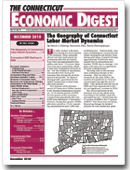 |
 |
December 2010 Connecticut Economic Digest |
The Geography of Connecticut Labor Market Dynamics [ Download December 2010 CT Economic Digest PDF ]
By Patrick.Flaherty, Economist, Department of Labor
 he labor market is dynamic.
Even during the worst months of the recession, when nationally jobs on net were declining by approximately 800,000 per month, there were still approximately four million new hires. Of course, there were even more separations, which is why total employment declined on net – but the number of separations was actually lower during the recession than during the previous period of job growth. In times of strong growth, approximately five million workers lose or leave their jobs every month. [ read more ] he labor market is dynamic.
Even during the worst months of the recession, when nationally jobs on net were declining by approximately 800,000 per month, there were still approximately four million new hires. Of course, there were even more separations, which is why total employment declined on net – but the number of separations was actually lower during the recession than during the previous period of job growth. In times of strong growth, approximately five million workers lose or leave their jobs every month. [ read more ]
Connecticut GDP Declines in 2009 [ Download December 2010 CT Economic Digest PDF ]
By Lincoln S. Dyer, Economist, Department of Labor & Jungmin Charles Joo, Associate Research Analyst, DOL, Jungmin.Joo@ct.gov
 onnecticut’s Gross Domestic
Product (GDP), the most comprehensive measure of total economic activity or value added in the state, was down as expected in 2009. On both a real (chained 2005 dollars) and current dollar basis, Connecticut GDP declined. The decrease in real CT GDP, which considers inflation’s impact, was -3.1%, while the drop in current dollar GDP fell 1.2% from 2008 estimates.* Connecticut’s real GDP was estimated at $205.7 billion and current dollar value GDP was calculated at $227.4 billion. [ read more ] onnecticut’s Gross Domestic
Product (GDP), the most comprehensive measure of total economic activity or value added in the state, was down as expected in 2009. On both a real (chained 2005 dollars) and current dollar basis, Connecticut GDP declined. The decrease in real CT GDP, which considers inflation’s impact, was -3.1%, while the drop in current dollar GDP fell 1.2% from 2008 estimates.* Connecticut’s real GDP was estimated at $205.7 billion and current dollar value GDP was calculated at $227.4 billion. [ read more ]
|
 |
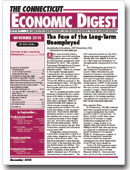 |
 |
November 2010 Connecticut Economic Digest |
The Face of the Long-Term Unemployed [ Download November 2010 CT Economic Digest PDF ]
By Manisha Srivastava, Economist, Department of Labor
 fter much political debate, Congress approved extending unemployment insurance benefits for the long-term unemployed until November 30, 2010. The extended Emergency Unemployment Compensation (EUC) program is 100% federally funded. This is in contrast to the regular Unemployment Compensation (UC) program that is fully State funded. The EUC program is a newly created program as of June 30, 2008 in response to the current financial crisis. It is the first time in the 75-year history of UC that benefits have been extended for up to 99 weeks. fter much political debate, Congress approved extending unemployment insurance benefits for the long-term unemployed until November 30, 2010. The extended Emergency Unemployment Compensation (EUC) program is 100% federally funded. This is in contrast to the regular Unemployment Compensation (UC) program that is fully State funded. The EUC program is a newly created program as of June 30, 2008 in response to the current financial crisis. It is the first time in the 75-year history of UC that benefits have been extended for up to 99 weeks.
The UC program provides unemployment compensation for a maximum of 26 weeks to eligible claimants. In the event of high unemployment rates a program called Extended Benefits (EB) triggers on, which extends unemployment compensation for another 13 to 20 weeks depending on the unemployment rate. Each week a federally mandated formula is used to calculate whether the current economic conditions warrant a State trigger onto EB. EB is 50% state funded and 50% federally funded. Before this current recession, the last time Connecticut entered onto EB status was in early 1981. [ read more ] |
 |
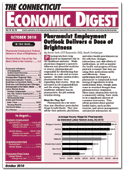 |
 |
October 2010 Connecticut Economic Digest |
Pharmacist Employment Outlook Delivers a Dose of Brightness [ Download October 2010 CT Economic Digest PDF ]
By Sarah York, Economist, Department of Labor
 harmacists have long played an important role in the healthcare industry. While physicians diagnose a patient’s ailments and prescribe medicine to treat it, pharmacists are responsible for distributing that medicine in a safe and accurate manner. As their careers evolve, pharmacists have been expanding their duties. With the increases in job responsibilities and the strong reliance the healthcare industry has on pharmacists, the job outlook remains strong. [ read more ] harmacists have long played an important role in the healthcare industry. While physicians diagnose a patient’s ailments and prescribe medicine to treat it, pharmacists are responsible for distributing that medicine in a safe and accurate manner. As their careers evolve, pharmacists have been expanding their duties. With the increases in job responsibilities and the strong reliance the healthcare industry has on pharmacists, the job outlook remains strong. [ read more ]
West Hartford: One of the Ten Best Cities in the Country [ Download October 2010 CT Economic Digest PDF ]
By Matthew Krzyzek, Economist, Department of Labor
 ncorporated on May 3rd 1854, West Hartford is a town of 63,908 and encompasses 22.4 square miles, situated exactly 98 miles from both Boston and New York City. Quiet suburban neighborhoods of early-mid twentieth century colonial style single-family homes typify much of the town. West Hartford Center, a thriving downtown commercial district, has in recent years become a popular location for commerce and recreation in central Connecticut. An extensive network of town parks, pools, theatre groups, golf courses and a skating rink helps to ensure the availability of year-round recreation and a high quality of life. [ read more ] ncorporated on May 3rd 1854, West Hartford is a town of 63,908 and encompasses 22.4 square miles, situated exactly 98 miles from both Boston and New York City. Quiet suburban neighborhoods of early-mid twentieth century colonial style single-family homes typify much of the town. West Hartford Center, a thriving downtown commercial district, has in recent years become a popular location for commerce and recreation in central Connecticut. An extensive network of town parks, pools, theatre groups, golf courses and a skating rink helps to ensure the availability of year-round recreation and a high quality of life. [ read more ]
|
 |
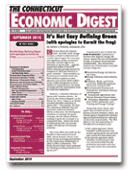 |
 |
September 2010 Connecticut Economic Digest |
It's Not Easy Defining Green (with apologies to Kermit the Frog) [ Download September 2010 CT Economic Digest PDF ]
By Patrick.Flaherty, Economist, Department of Labor
 oncern about the environment, unstable world energy markets, a desire to find new and creative
ways to grow the economy, and significant public investment have kept interest high in the definition of “green jobs.” Approximately $60 billion of the $787 billion stimulus package passed by Congress in 2009 was devoted to green activities.
Data available on the Governor’s website show over $200 million in grants to state agencies and another $200 million in tax credits and grants to other entities in Connecticut in the areas of energy and the environment from the stimulus
legislation. oncern about the environment, unstable world energy markets, a desire to find new and creative
ways to grow the economy, and significant public investment have kept interest high in the definition of “green jobs.” Approximately $60 billion of the $787 billion stimulus package passed by Congress in 2009 was devoted to green activities.
Data available on the Governor’s website show over $200 million in grants to state agencies and another $200 million in tax credits and grants to other entities in Connecticut in the areas of energy and the environment from the stimulus
legislation.
However, a definitive definition of “green jobs” remains elusive. As noted by the Federal Register on the March 16, 2010, “There is no widely accepted standard definition of ‘green jobs.’” Fortunately, the lack of a consensus definition has not prevented continued research efforts in this area, the development of policies to promote the green economy, nor the efforts of those working to grow the economy in a sustainable way. Indeed the work to define green jobs can provide insight into this set of economic activities. [ read more ] |
 |
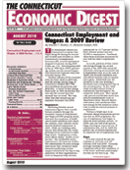 |
 |
August 2010 Connecticut Economic Digest |
Connecticut Employment and Wages: A 2009 Review [ Download August 2010 CT Economic Digest PDF ]
By Edward T. Doukas, Jr., Research Analyst, Department of Labor
 he recessionary impacts on Connecticut’s economy that began being felt during the second half of 2008 took full effect in 2009.
Connecticut’s Unemployment Insurance (UI) covered employment dropped 4.3 percent during 2009 (Table, pp. 2-3). Records going back as far as 1969 show 2009’s percentage decline was the second largest only behind the 5 percent drop that occurred during 1991. he recessionary impacts on Connecticut’s economy that began being felt during the second half of 2008 took full effect in 2009.
Connecticut’s Unemployment Insurance (UI) covered employment dropped 4.3 percent during 2009 (Table, pp. 2-3). Records going back as far as 1969 show 2009’s percentage decline was the second largest only behind the 5 percent drop that occurred during 1991.
Another indicator of the economic wOEWS the State faced in 2009 was that the average annual wage of Connecticut workers ($57,755) decreased from the previous year ($58,334). A review of data dating back as far as 1969 shows that this was only the second time this anomaly has occurred. The only other year that annual pay per employee decreased was 2002. [ read more ] |
 |
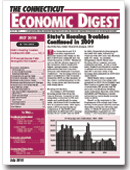 |
 |
July 2010 Connecticut Economic Digest |
State’s Housing Troubles Continued in 2009 [ Download July 2010 CT Economic Digest PDF ]
By Kolie Sun, Senior Research Analyst, Department of Economic and Community Development
 he Connecticut and U.S. economies experienced financial turmoil that began in the
fall of 2008 and continued into the Great Recession of 2009. Nearly all sectors felt the adverse impacts of the recession, which resulted in higher unemployment, declining personal income and corporate revenues and weakened consumer confidence. The housing sector is a major contributor to the economic turmoil in 2009, as this analysis of the state’s residential permit activities,home prices and foreclosures will clearly show. [ read more ] he Connecticut and U.S. economies experienced financial turmoil that began in the
fall of 2008 and continued into the Great Recession of 2009. Nearly all sectors felt the adverse impacts of the recession, which resulted in higher unemployment, declining personal income and corporate revenues and weakened consumer confidence. The housing sector is a major contributor to the economic turmoil in 2009, as this analysis of the state’s residential permit activities,home prices and foreclosures will clearly show. [ read more ]
Connecticut Personal Income Pulls Through in First Quarter [ Download July 2010 CT Economic Digest PDF ]
By Lincoln S. Dyer, Economist, Department of Labor and Matthew Krzyzek, Economist, Department of Labor
 onnecticut personal income growth at 0.6% trailed national personal income growth of 0.9% and New England income growth of 0.8% in the first quarter of 2010. Personal income of $193.037 billion (current dollars, quarterly annualized rate) was the second consecutive quarterly increase, after increasing 0.3% in the fourth quarter of 2009, according to the Bureau of Economic Analysis (BEA). Comparable and adjacent states like New York (0.9%), New Jersey (0.8%), Massachusetts (0.7%), Maryland (0.8%), Pennsylvania (0.8%) and Rhode Island (0.9%) all experienced slightly faster growth than Connecticut during the first quarter. Connecticut ranked 44th by state, in the lowest quintile, in this quarter’s personal income growth. [ read more ] onnecticut personal income growth at 0.6% trailed national personal income growth of 0.9% and New England income growth of 0.8% in the first quarter of 2010. Personal income of $193.037 billion (current dollars, quarterly annualized rate) was the second consecutive quarterly increase, after increasing 0.3% in the fourth quarter of 2009, according to the Bureau of Economic Analysis (BEA). Comparable and adjacent states like New York (0.9%), New Jersey (0.8%), Massachusetts (0.7%), Maryland (0.8%), Pennsylvania (0.8%) and Rhode Island (0.9%) all experienced slightly faster growth than Connecticut during the first quarter. Connecticut ranked 44th by state, in the lowest quintile, in this quarter’s personal income growth. [ read more ]
|
 |
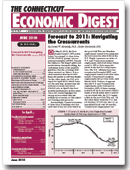 |
 |
June 2010 Connecticut Economic Digest |
Forecast to 2011: Navigating the Crosscurrents [ Download June 2010 CT Economic Digest PDF ]
By Daniel W. Kennedy, Ph.D., Senior Economist, Department of Labor
 n May 6, 2010, the Dow plunged nearly 1,000 points until recovering to close down 347.80 (-3.20%) points, an unpleasant reminder of 2008. Despite the infamous "fat finger" glitch and model-driven threshold selling, the underlying driver of the market's gyrations was the sovereign debt crisis centered on Greece. It is a stark reminder that the world's financial system is still very fragile. On the other hand, the U.S. jobs report for April 2010, which came out the next day, showed that the national economy had added 290,000 jobs in April the best monthly performance in four years. These two events highlight the strong crosscurrents that are pulling the economy, both up and down at the same time, as this apparent turning point proceeds. [ read more ] n May 6, 2010, the Dow plunged nearly 1,000 points until recovering to close down 347.80 (-3.20%) points, an unpleasant reminder of 2008. Despite the infamous "fat finger" glitch and model-driven threshold selling, the underlying driver of the market's gyrations was the sovereign debt crisis centered on Greece. It is a stark reminder that the world's financial system is still very fragile. On the other hand, the U.S. jobs report for April 2010, which came out the next day, showed that the national economy had added 290,000 jobs in April the best monthly performance in four years. These two events highlight the strong crosscurrents that are pulling the economy, both up and down at the same time, as this apparent turning point proceeds. [ read more ]
|
 |
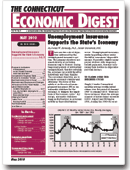 |
 |
May 2010 Connecticut Economic Digest |
Unemployment Insurance Supports the State’s Economy [ Download May 2010 CT Economic Digest PDF ]
By Daniel W. Kennedy, Ph.D., Senior Economist, Department of Labor
 here are two sets of objectives addressed by the unemployment insurance system. The primary objectives are aimed directly at providing financial help to workers during temporary periods of involuntary unemployment, thereby reducing the economic insecurity faced by individuals and their families. The secondary objectives are to promote economic stability and efficiency. The focus of this article is on the role of unemployment insurance (UI) as an automatic stabilizer for the economy, to dampen the amplitude of the business cycle. By design, automatic stabilizers dampen fluctuations in economic activity as those fluctuations occur. Unemployment insurance works by putting a floor under the fall in consumers’ disposable income. It provides eligible unemployed workers with temporary benefit payments, thereby cushioning their decline in disposable personal income. [ read more ] here are two sets of objectives addressed by the unemployment insurance system. The primary objectives are aimed directly at providing financial help to workers during temporary periods of involuntary unemployment, thereby reducing the economic insecurity faced by individuals and their families. The secondary objectives are to promote economic stability and efficiency. The focus of this article is on the role of unemployment insurance (UI) as an automatic stabilizer for the economy, to dampen the amplitude of the business cycle. By design, automatic stabilizers dampen fluctuations in economic activity as those fluctuations occur. Unemployment insurance works by putting a floor under the fall in consumers’ disposable income. It provides eligible unemployed workers with temporary benefit payments, thereby cushioning their decline in disposable personal income. [ read more ]
|
 |
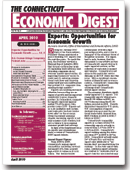 |
 |
April 2010 Connecticut Economic Digest |
Exports: Opportunities for Economic Growth [ Download April 2010 CT Economic Digest PDF ]
By Laura Jaworski, Office of International and Domestic Affairs, Department of Economic and Community Development
 uring his January 2010 State of the Union address, President Obama announced a goal of doubling U.S. exports over the next five years. To reach this goal, the President unveiled a National Export Initiative (NEI) that focuses on three key areas: (1) expanding trade advocacy and educating companies about overseas market opportunities; (2) improving businesses’ access to credit and (3) enforcing international trade laws and removing unfair tariff and non-tariff barriers that prevent U.S. companies from entering foreign markets. [ read more ] uring his January 2010 State of the Union address, President Obama announced a goal of doubling U.S. exports over the next five years. To reach this goal, the President unveiled a National Export Initiative (NEI) that focuses on three key areas: (1) expanding trade advocacy and educating companies about overseas market opportunities; (2) improving businesses’ access to credit and (3) enforcing international trade laws and removing unfair tariff and non-tariff barriers that prevent U.S. companies from entering foreign markets. [ read more ]
United States Census Brings Temporary Federal Jobs [ Download April 2010 CT Economic Digest PDF ]
By Lincoln S. Dyer, Economist, Department of Labor
 y now most Connecticut households have received their 2010 Census forms. Advanced notifications were sent out in early March, followed soon after by the official 2010 Census forms. The 2010 Census forms were projected to arrive at U.S. residences in late March, to be completed and customarily returned in April. April 1st is National Census Day, and some newly hired census takers were expected to start late on March 31st with a rural canvassing and an urban homeless headcount campaign. Then a labor-intensive address follow-up and localized information drive is normally planned for May through July. By mid-summer, the short-term local economic impacts of the Census will be all but over. An evaluation of federal government civilian employment for Connecticut over the last four decades shows the U.S. Census employment buildup that occurs once every ten years in the state seems to follow this basic pattern. [ read more ] y now most Connecticut households have received their 2010 Census forms. Advanced notifications were sent out in early March, followed soon after by the official 2010 Census forms. The 2010 Census forms were projected to arrive at U.S. residences in late March, to be completed and customarily returned in April. April 1st is National Census Day, and some newly hired census takers were expected to start late on March 31st with a rural canvassing and an urban homeless headcount campaign. Then a labor-intensive address follow-up and localized information drive is normally planned for May through July. By mid-summer, the short-term local economic impacts of the Census will be all but over. An evaluation of federal government civilian employment for Connecticut over the last four decades shows the U.S. Census employment buildup that occurs once every ten years in the state seems to follow this basic pattern. [ read more ]
|
 |
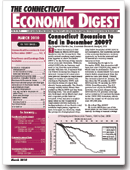 |
 |
March 2010 Connecticut Economic Digest |
Connecticut Recession to End in December 2009? [ Download March 2010 CT Economic Digest PDF ]
By Jungmin Charles Joo, Associate Research Analyst, Department of Labor
 he Great Recession II that began in March 2008 may finally be over for Connecticut. The newly revised nonfarm employment data appears to show December 2009 to be the bottom of this treacherous economic downturn. While we added 2,300 jobs in January, and need to see how the next several months will pan out, it appears that our State’s economy has begun to rebound. Connecticut’s year-over-year percent changes in employment began to decline at a slower rate starting in September 2009, and recovery in terms of output has already begun nationally. The State’s average weekly initial claims data peaked in March 2009 and has been trending down. The stock market also bottomed out in March last year and corporate profits have rebounded. Even last year’s employment trend in the Connecticut employment services industry, a leading indicator of our State’s total nonfarm employment, appears to have bottomed out. However, while the prospects of employment dropping below December 2009’s level is not anticipated, the uncertain nature of the economy warrants a cautious approach, as both the national and Connecticut’s recovery remain tenuous at best. [ read more ] he Great Recession II that began in March 2008 may finally be over for Connecticut. The newly revised nonfarm employment data appears to show December 2009 to be the bottom of this treacherous economic downturn. While we added 2,300 jobs in January, and need to see how the next several months will pan out, it appears that our State’s economy has begun to rebound. Connecticut’s year-over-year percent changes in employment began to decline at a slower rate starting in September 2009, and recovery in terms of output has already begun nationally. The State’s average weekly initial claims data peaked in March 2009 and has been trending down. The stock market also bottomed out in March last year and corporate profits have rebounded. Even last year’s employment trend in the Connecticut employment services industry, a leading indicator of our State’s total nonfarm employment, appears to have bottomed out. However, while the prospects of employment dropping below December 2009’s level is not anticipated, the uncertain nature of the economy warrants a cautious approach, as both the national and Connecticut’s recovery remain tenuous at best. [ read more ]
New Hours and Earnings Data Available [ Download March 2010 CT Economic Digest PDF ]
By Lincoln S. Dyer, Economist, Department of Labor
 fter three years of exploratory development at the Office of Research, real-time monthly hours and earnings estimates for all private industries in the state and the six largest Connecticut labor market areas have been formally introduced. These newly available All Employee Hours and Earnings series from the employer payroll survey include the average hourly earnings, the average weekly hours employed, and the total average weekly earnings for most of Connecticut’s private sector nonfarm workforce. [ read more ] fter three years of exploratory development at the Office of Research, real-time monthly hours and earnings estimates for all private industries in the state and the six largest Connecticut labor market areas have been formally introduced. These newly available All Employee Hours and Earnings series from the employer payroll survey include the average hourly earnings, the average weekly hours employed, and the total average weekly earnings for most of Connecticut’s private sector nonfarm workforce. [ read more ]
|
 |
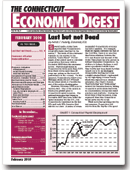 |
 |
February 2010 Connecticut Economic Digest |
Last but not Dead [ Download February 2010 CT Economic Digest PDF ]
By Patrick.Flaherty, Economist, Department of Labor
 everal media stories have reported that “Connecticut’s job growth ranks dead last in the nation.” The truth of this statement depends on the answer to the question, “since when?” For example, if the period used to calculate job growth is February 1989 to December 2009 then the statement is true. Payroll employment in Connecticut is down more than 3.5% from where it was more than 20 years ago, giving us the worst job performance in the country. On this measure, Connecticut is below even Michigan (down about 1.4%) and Rhode Island (down 2.1%) with the rest of the nation showing gains. [ read more ] everal media stories have reported that “Connecticut’s job growth ranks dead last in the nation.” The truth of this statement depends on the answer to the question, “since when?” For example, if the period used to calculate job growth is February 1989 to December 2009 then the statement is true. Payroll employment in Connecticut is down more than 3.5% from where it was more than 20 years ago, giving us the worst job performance in the country. On this measure, Connecticut is below even Michigan (down about 1.4%) and Rhode Island (down 2.1%) with the rest of the nation showing gains. [ read more ]
Measures of Labor Underutilization [ Download February 2010 CT Economic Digest PDF ]
By Salvatore DiPillo, Associate Research Analyst, Department of Labor
 n the November 2009 issue of the Digest we began publishing for Connecticut, in addition to the official unemployment rate, the most comprehensive measure of labor underutilization. Referred to as the “U-6” by the U.S. Bureau of Labor Statistics (BLS) which sets the definition of the labor force, employment and unemployment and the methodologies for measuring these, it is just one of six measures of unemployment for the nation and the states. [ read more ] n the November 2009 issue of the Digest we began publishing for Connecticut, in addition to the official unemployment rate, the most comprehensive measure of labor underutilization. Referred to as the “U-6” by the U.S. Bureau of Labor Statistics (BLS) which sets the definition of the labor force, employment and unemployment and the methodologies for measuring these, it is just one of six measures of unemployment for the nation and the states. [ read more ]
|
 |
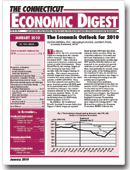 |
 |
January 2010 Connecticut Economic Digest |
The Connecticut Economic Outlook for 2010 [ Download January 2010 CT Economic Digest PDF ]
By Stan McMillen, Ph.D., Managing Economist, DECD and Mark Prisloe, Associate Economist, Department of Economic and Community Development
 he Nation. In 2010, the U.S. economy will begin recovering from the current severe recession that began in December 2007. This outlook is supported by historic experience and recent positive developments. Since World War II, the average length of U.S. recessions has been 10.5 months with the longest lasting 16 months. The current recession is already longer and some observers consider it to have ended in the third quarter of 2009 (Q3-2009). They note that quarter-over-quarter real gross domestic product (RGDP) grew at an annualized rate of 2.8% from Q2-2009 according to the revised estimate released by the Bureau of Economic Analysis (BEA). In Q2-2009, RGDP declined by 0.7%, moderating from Q1-2009 when RGDP declined by 6.4%. [ read more ] he Nation. In 2010, the U.S. economy will begin recovering from the current severe recession that began in December 2007. This outlook is supported by historic experience and recent positive developments. Since World War II, the average length of U.S. recessions has been 10.5 months with the longest lasting 16 months. The current recession is already longer and some observers consider it to have ended in the third quarter of 2009 (Q3-2009). They note that quarter-over-quarter real gross domestic product (RGDP) grew at an annualized rate of 2.8% from Q2-2009 according to the revised estimate released by the Bureau of Economic Analysis (BEA). In Q2-2009, RGDP declined by 0.7%, moderating from Q1-2009 when RGDP declined by 6.4%. [ read more ]
|
 |
 |
|
|

|

|
State of Connecticut Department of Labor - Office of Research, 200 Folly Brook Boulevard, Wethersfield, CT 06109
|

|
|





















